
| Archives: The Third Decade | The Gallery of Original Furniture |
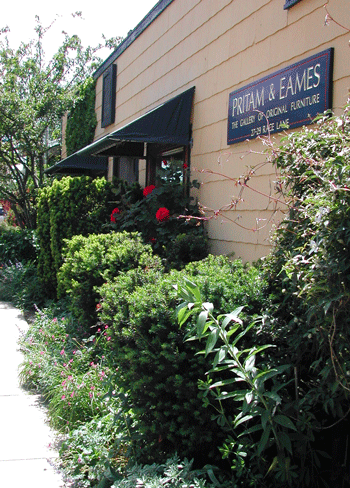
2001 - 2011
The archives is intended as a record of work that Pritam & Eames received in its 30-plus year history. The prompt for the creation of the archives came from an unlikely source: a New York State auditor, when examining the gallery’s sales tax procedures, ended up so impressed with the quality of work being shown that, before she left, she made an emphatic suggestion that the partners had a serious responsibility to produce a record of this work. And so began the registration system -- photographs attached to index cards containing the specifications of each piece, which led to the creation of these Archives.
Throughout its third decade, Pritam & Eames continued its tradition of showcasing work in group and featured shows that was made by the artisans associated with the gallery. Occasionally, a new name would appear on the roster, but the partners' early decision to focus on the evolution of work by a finite group of furniture makers did not allow for a large turn-over in the gallery's representation.
As the third decade of the archives will show there were some remarkably strong pieces to write about. Of special note in this regard were the spectacular pieces made by Kristina Madsen and Brian Newell. It’s clear that when studying individual pieces, some of the strongest work of the gallery’s three decades was produced in this period. You could also say, in general, that most of the work produced in this period was a maturation of individual pathways and less a matter of pushing new frontiers.
At this point, any student of the decorative arts can’t help but appreciate the longevity of the studio furniture movement from its post-World War II beginnings. In fact, this decorative arts period has, by this point, outlasted the length of the Art Deco and Art Nouveau periods combined. However, there were cyclical outside events underway that would intensify the challenges for those operating a small shop/studio for furniture production. The recession of 2009 was but one of the influences that would affect the viability of the studio furniture maker.
Carved Rosettes and Musical Instruments by Ervin Somogyi
NOTES: Although Erwin Somogyi's work does not come from the tradition of furniture making but musical instrument making, his carved panels and instruments were so appealing that he was invited to show his work at the gallery. Renowned as a guitar maker or luthier, Somogi expanded his repertoire of classical rosettes carved in the instruments to other fields of two-dimensional imagery carved into flat boards with a scalpel: intricate impressions of cave drawings, Celtic patterns, latticework, among others.
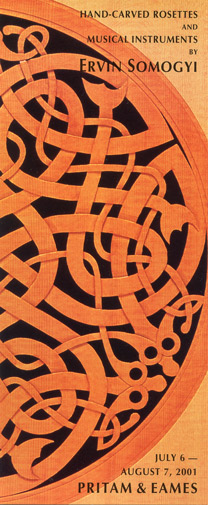

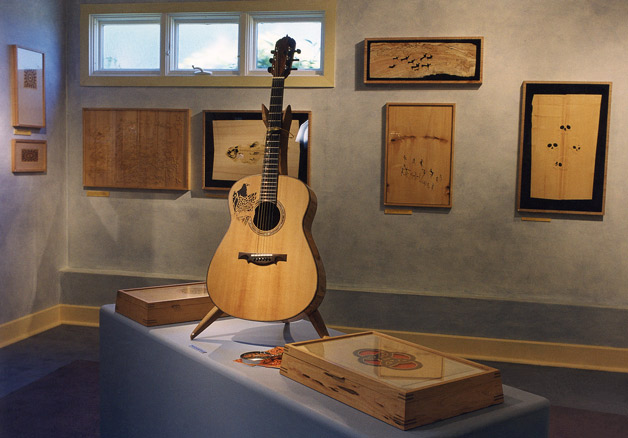
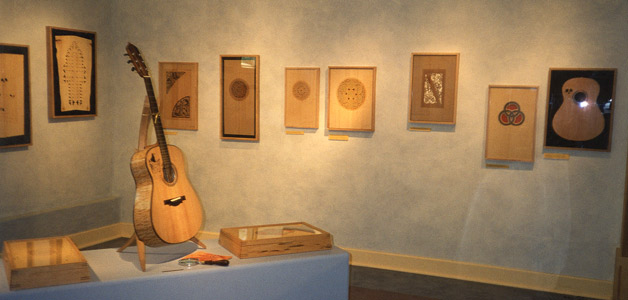
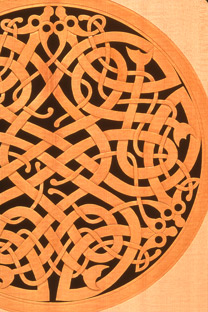
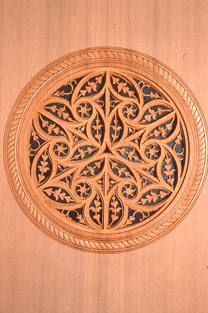
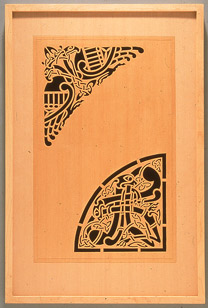
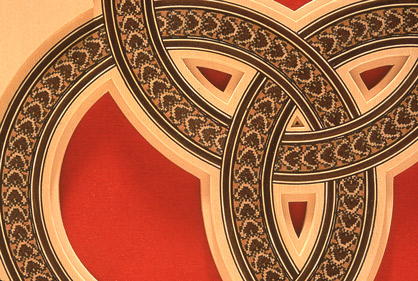
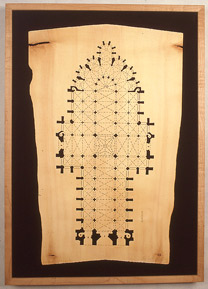
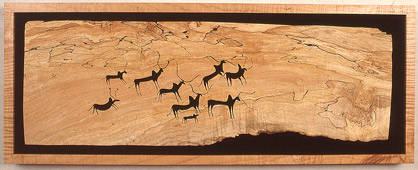
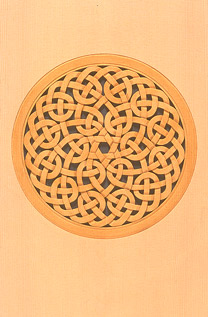
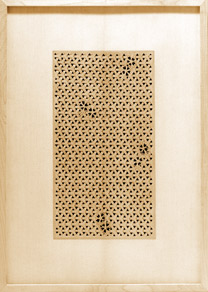
NOTES: Michael Hurwitz's work always maintains an innovative structural dimension, a defining characteristic that he attributes to the early influence of his teacher, Jere Osgood. You can also detect the influence of another of Hurwitz's teachers, Dan Jackson, in the mirror he made for this show. The hemispherical mirror is joined to a mantle shelf built into a form of an oxbow curvature. And like another of his teachers, Alphonse Mattia,whose mirror series became his signature work, Hurwitz chose to treat the mirror as a major piece in this show.
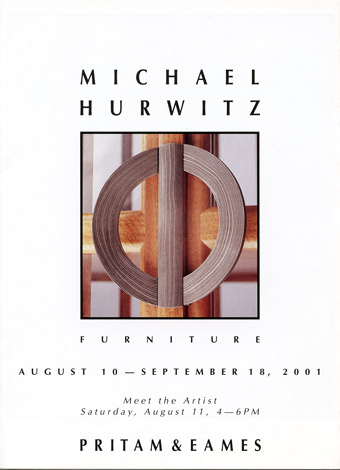


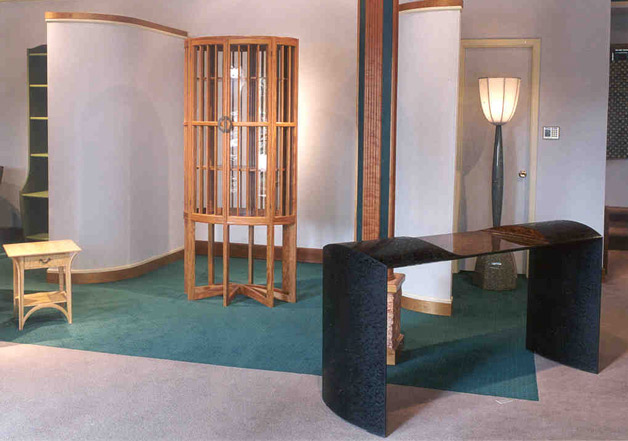
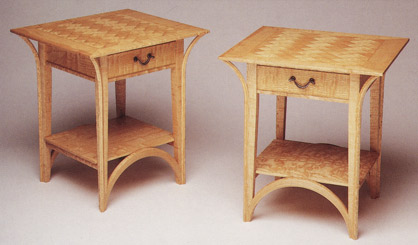
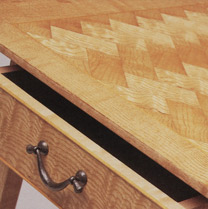
Curly ash, pau amarello, silver pulls.
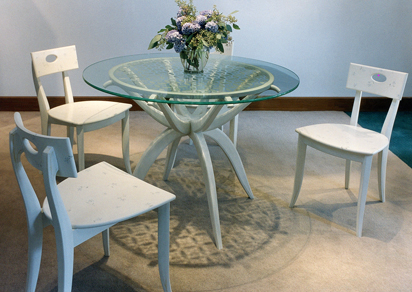
His side tables are vintage Hurwitz with their arching stretcher and corner brace design.
The Flower Table is a glass top table that seats four; the center of the glass has a sandblasted floral based pattern. The top is supported by four intersecting ox bow curves, yielding eight arms. This resulting shallow cup form is jointed into the intersection of two domed pairs of legs. The table is so agreeable, it's as if Hurwitz was amused by this structural challenge.
Chairs with Flowers: Milk paint over ash.
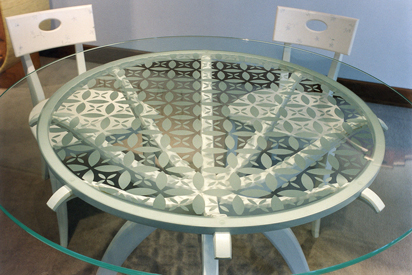
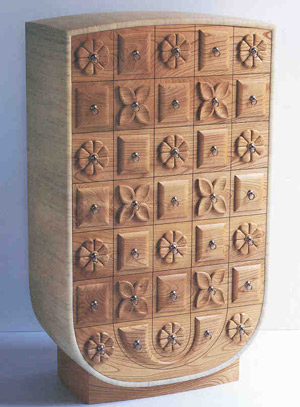
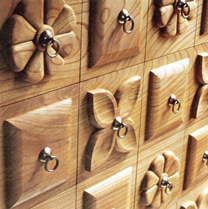
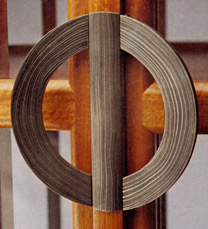
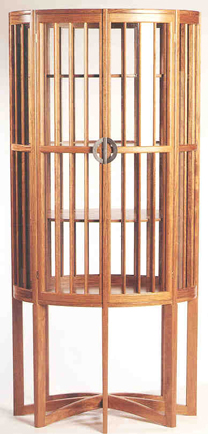
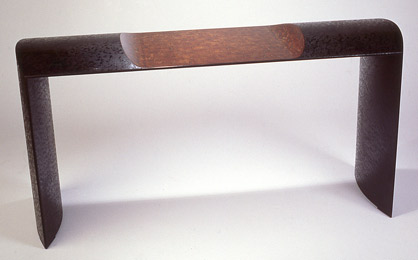
Inkstone Desk:
Japanese lacquer over wood.
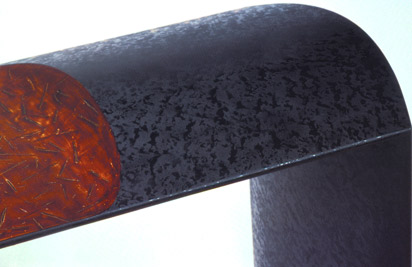
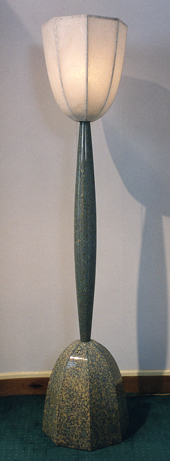
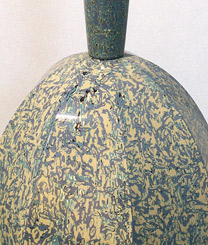
Also included in this exhibit were two collaborative pieces with Yuji Kubo, the Japanese lacquer artist: the polychromed floor-standing lamp, and the amber and black Inkstone Desk with its wondrous rubbed-out pine needle pattern.
John Eric Byers, Linda Sue Eastman, Hank Gilpin, Julie Godfrey, Thomas Hucker, Mary Little & Peter Wheeler, Gary S. Magakis, Jere Osgood, Timothy Philbrick, Fran Taubman, Rick Wrigley
NOTES: John Eric Byers continues to evolve his carved and milk painted cylindrical forms, and Thomas Hucker continues his inspired forms in this pair of cantilevered end tables. Osgood's Easy Chair is joined by a companion settee.
The outstanding wood piece in this show is an oval dining table in cherry from Hank Gilpin. The Arts & Crafts flavored pedestal has a frame-and-panel core, the corners of which have a 45 degree facet. This allows for jointing at the bottom to the horizontal S-curved legs. From its oval top, which is rounder than the usual oval, through the use of figured wood in the panels of the pedestal, to the generous strength of the legs, this piece exhibits the best of Gilpin's fresh touch with standard design elements.
In metal, Fran Taubman's Thicket Table takes her a step away from her previous Art Nouveau inspired work that the Branch Lamp represents. The forged steel branches in the Thicket Table leave the floor in a swirl of thrusting energy, giving this piece a dynamic center. The cast bronze Celery Table by Jod Lourie adds sculptural interest from a newcomer to the gallery.

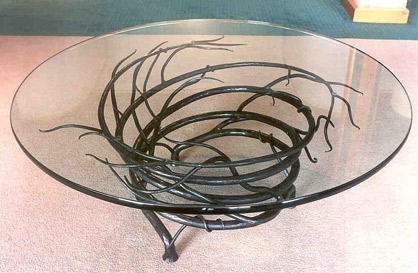
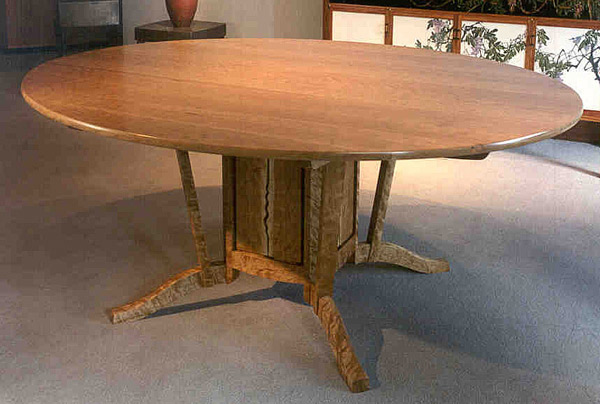
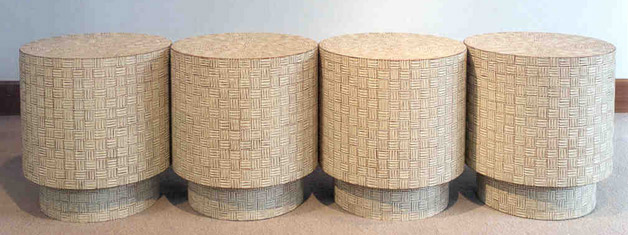
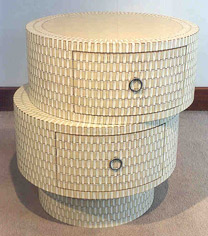
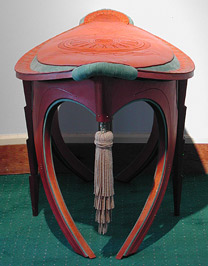
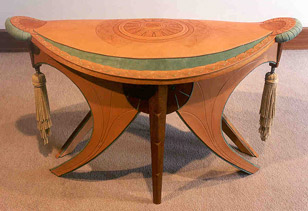
Tooled cowhide, lamb suede, mahogany, curved wood laminations, brass.
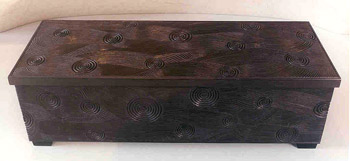
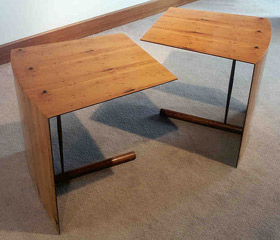
Pair of Side Tables by THOMAS HUCKER: Yew, mahogany.
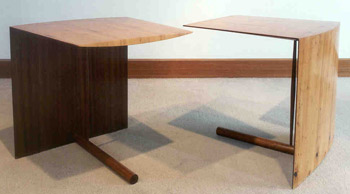
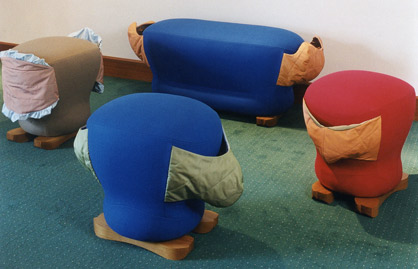
by MARY LITTLE & PETER WHEELER:
Cherry, polyester foam on wood, felted wool, Tafbi (polyester).
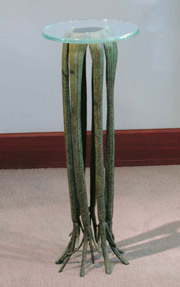
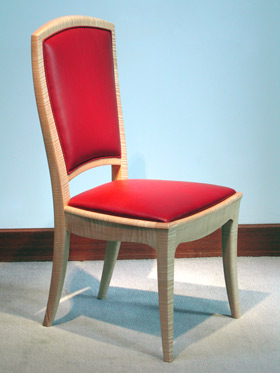
Bronze, glass.
Curly maple, Spinneybeck leather.
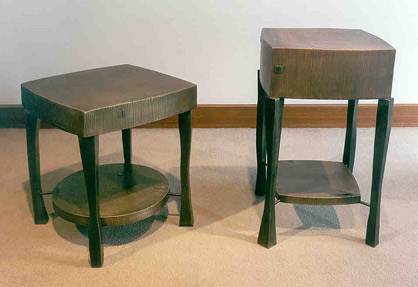
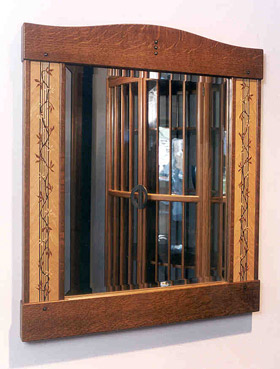
Fumed quartersawn white oak, marquetry woods, ebony, sterling silver inlays.
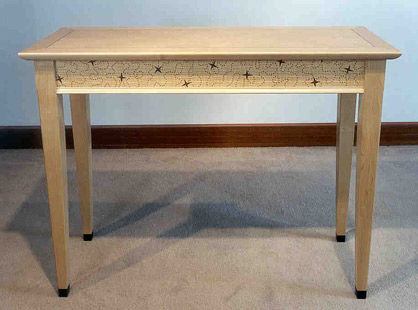
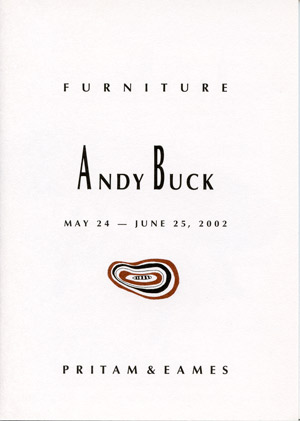
NOTES: Andy Buck's work carries the expectation of unconventional form and use of color. If it makes sense to speak of a "timeless modern" idiom, there were pieces in this show that would strike the observer as timeless. The Pod Buffet table and the Moonwalker bench have qualities that make them at home in any interior with walls of modern art.
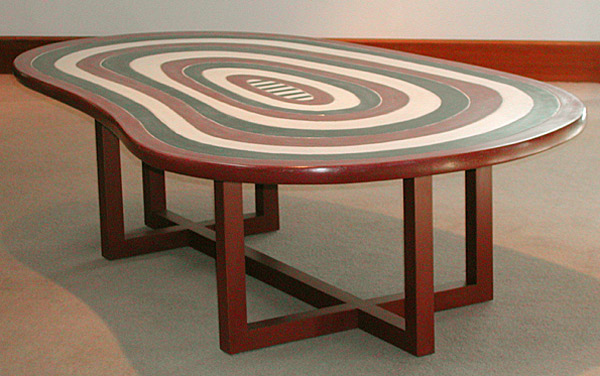
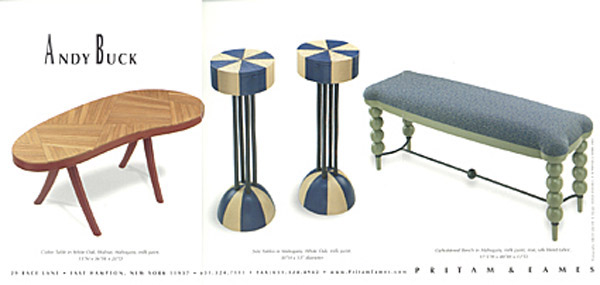
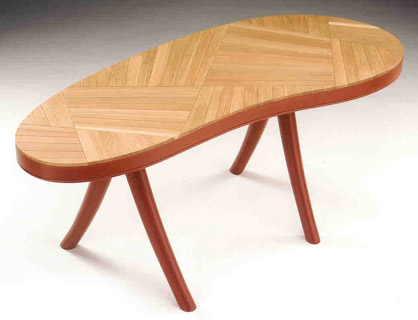
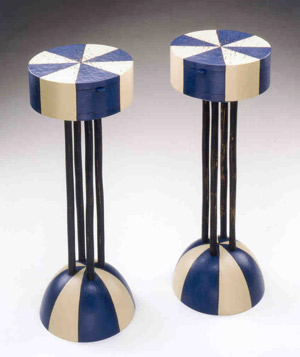
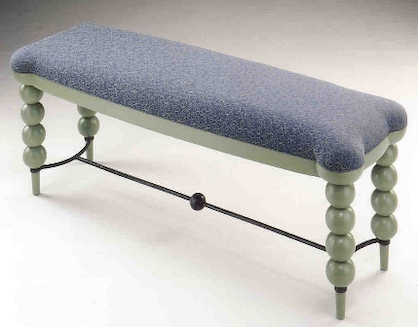
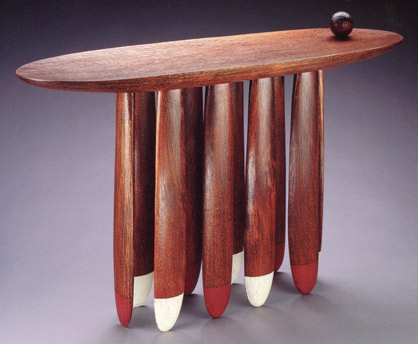
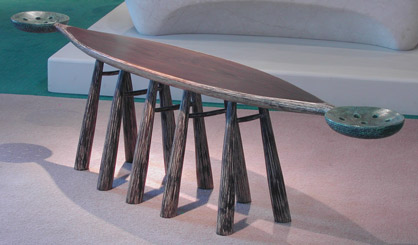
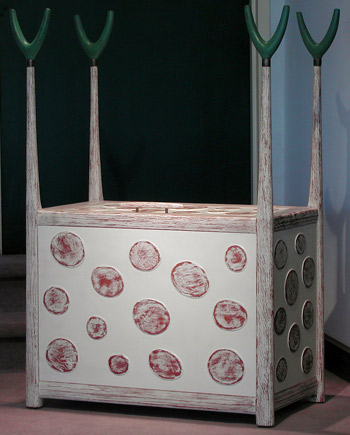
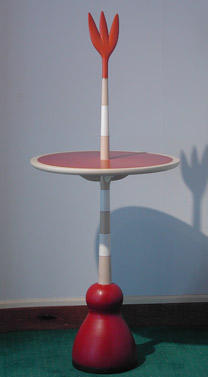
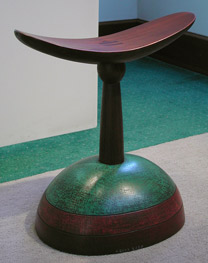
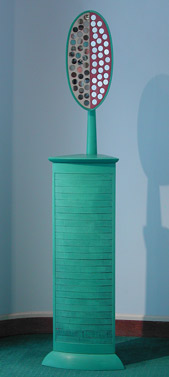
Mahogany, poplar, steel, milk paint.
Poplar, milk paint, mirror.
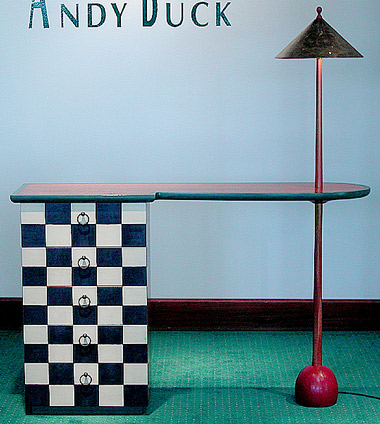
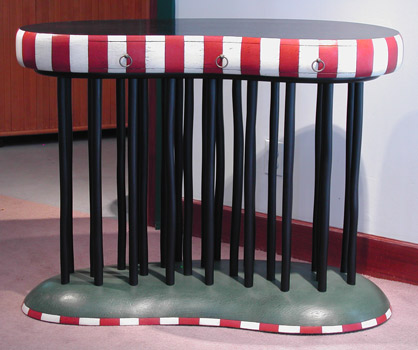
BRIAN NEWELL &
WILLIAM WALKER - 2002
NOTES: This is the first two-person show at Pritam & Eames to feature the work of graduates of the College of the Redwoods: William Walker and Brian Newell. The excellence of their work made the choice for this show easy.
When a maker completes a dining room extension table and ten chairs, all made from the same tree, one says they have done their work. When the table comes with such features as a resawn veneer top with cocobolo inlay and edging, a maple torsion box extending mechanism, and corner oriented, curved, pillowed, and faceted legs that pour from the apron, you know you have a piece that was not only time-consuming but fueled by a vision. The resulting table is simply one of the most appealing and sophisticated dining room tables the gallery has hosted.
This dining suite is accompanied by a pair of flawless side tables in fiddleback maple, with tops of Kerilian/Masur birch. Square in form, the scale is sufficiently ample to support a reading lamp.
Walker's style is consistent with what was described earlier as a Northwest coast contemporary style, with roots perhaps in Scandinavian Moderne but by now comfortably American with its own sophisticated corner leg and apron solutions. It should be mentioned that the chair retailed for under $2,500. With a compound curved wooden back, an upholstered seat that fits neatly inside the wooden frame of the aprons, and five-faceted curving front legs, this was an unparalleled design feat that never lost sight of the production demands.
The basic nature of Brian Newell's approach to furniture is so distinct that his work commingled with Walker's without confusion. After his 2001 Spider Cabinet, one could only ask, whatever will this maker do next? This was Brian Newell's decade, one that firmly established him as a principal player in the American studio furniture movement. Living in Japan with his wife and young daughter, he worked uninterrupted for nearly a decade, producing a brilliant body of work unmatched by anyone for its vision and bravura workmanship.
His ebony cabinet and nine-legged ebony desk do not disappoint and prove how a work as eccentrically distinct as the 2001 cabinet could extend its aesthetic reach to include other works as strong. Having described these pieces as of a body of work, if you could call the desk Cinemascope, then the cabinet would be Silent Cinema of the darkly experimental variety. Like the Spider Cabinet, a pierced-carved grill sits in the center of the Ebony cabinet and dares the viewer to venture inside. The two doors are the full length of the cabinet and open by reaching through the grill. The inner space is a central, vertical tapered column of seven drawers which is flanked on either side by two shelves.
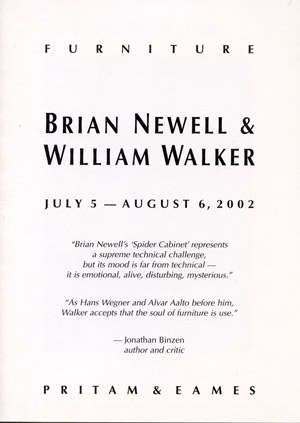
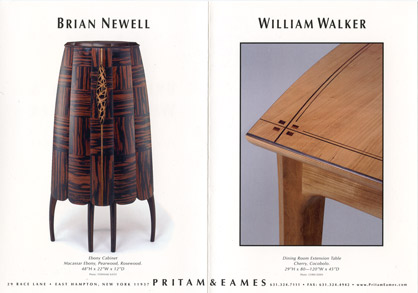
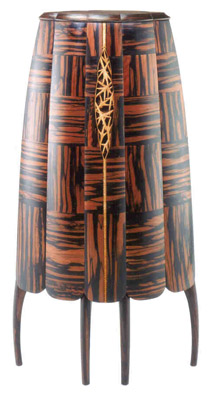
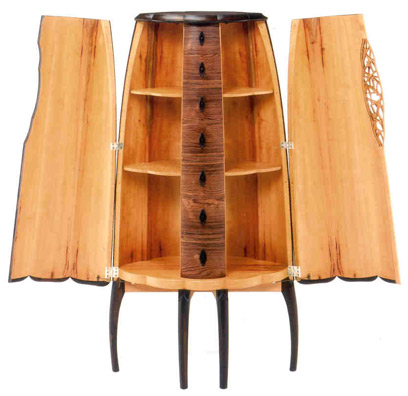
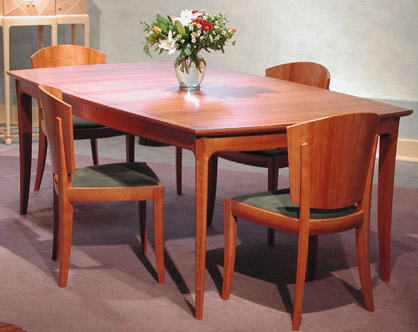
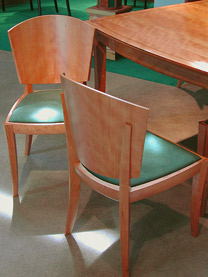
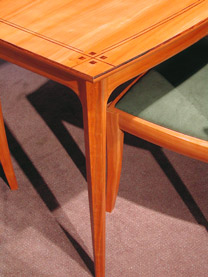
by WILLIAM WALKER:
Cherry, cocobolo; sueded fabric.
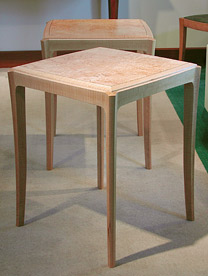

Kerilian/Masur birch, fiddleback maple, cocobolo.
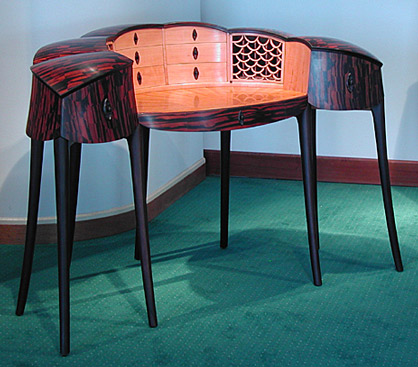
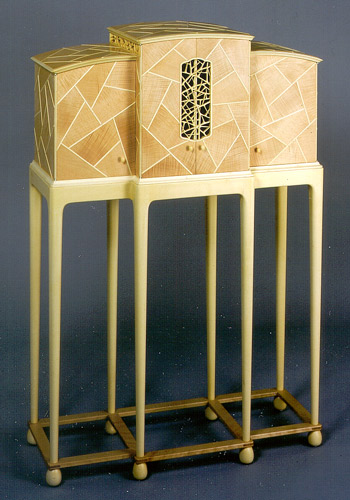
There is a pierced carved grillwork in the center of the Thorn Cabinet that holds the first look. It is carved through in a pattern of thorns. The cabinet sits on a proportionately tall stand, its eight legs descending without curve to their small eggplant-shaped feet. The effect is to have the cabinet itself sitting high as if in an aerie world all of its own, while projecting by means of the bottom leg stretchers a floor plan of the building above. And the sense of that cabinet is cathedral, with a central nave and left and right transepts.
Looking again at the central pierced carving, it becomes an arched porthole to the interior. The thorn pattern of the carving is expanded into a “cracked ice” pattern on the façade, but it is also used to create “clerestory windows” at the top of the central compartments sides.
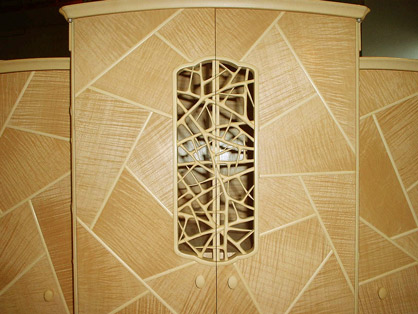
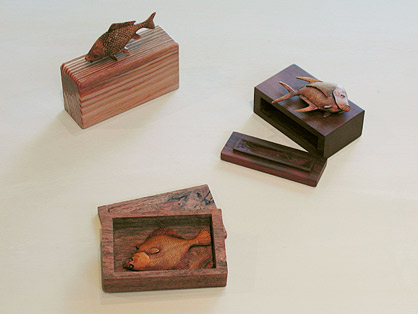
Lookdown: Boxwood; isu noki. / Flounder: Boxwood; teak.
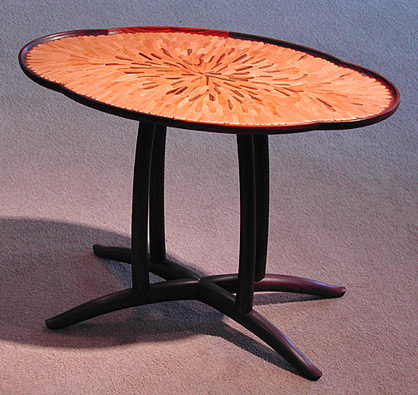
The six-legged table has the tops of the legs snug into the intersection of each of the six petal forms. The second table has an arched cross base with four posts midway into the intersection.
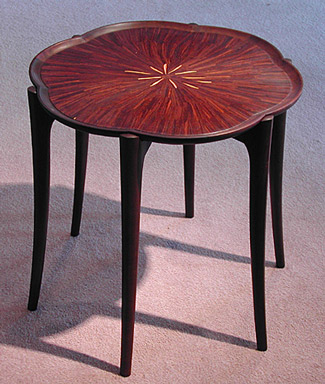
WENDY MARUYAMA: Turning Japanese - 2002
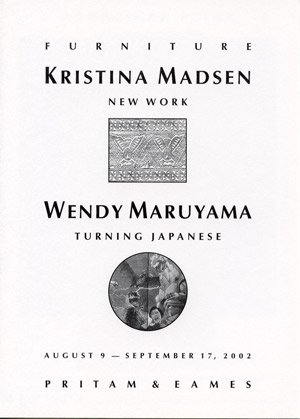
KRISTINA MADSEN: New Work
WENDY MARUYAMA:
Turning Japanese
August 9 -- September 17, 2002
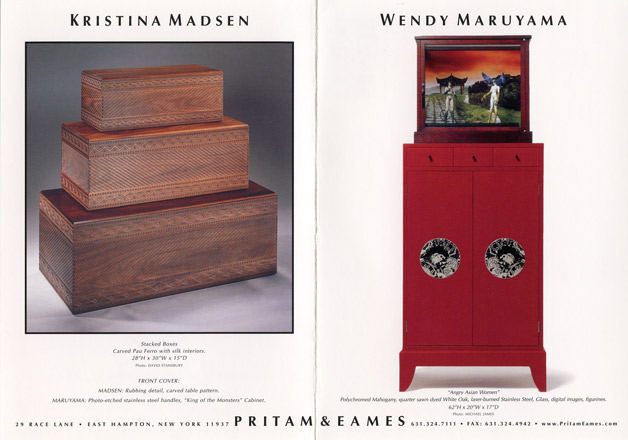
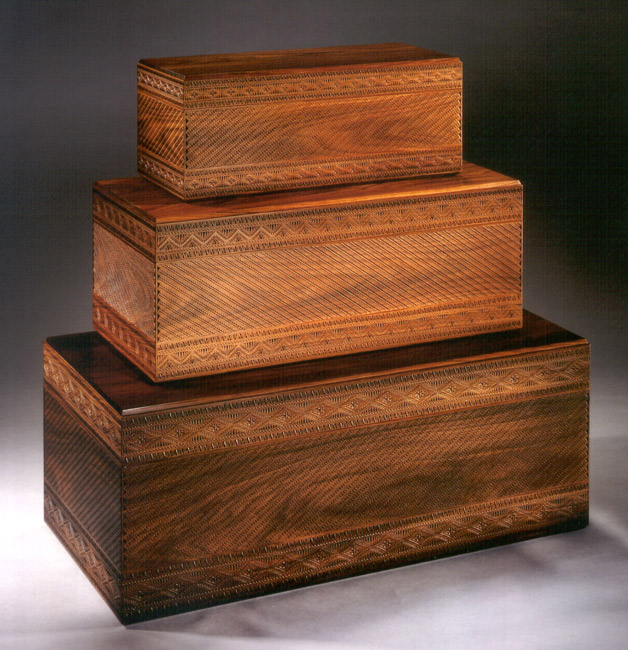
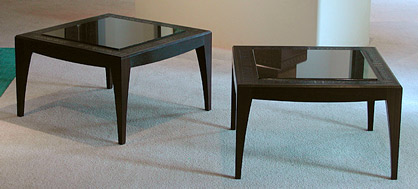
NOTES: This exhibit is the fifth show at Pritam & Eames to feature the work of Kristina Madsen. Her major work for the exhibit, reminiscent of Shaker storage boxes, is a stack of three lidded chests, each chest successively smaller. The four sides, but not the tops, of the chests are carved. The patterns are prompted by the repetitive, geometric patterns of lace work: on each case, an upper and lower border of high complexity frames a broad mid-section of diagonal lines done with a toothed pattern. The grain of the pau ferro wood shows through the patterns and gives the illusion of moiré silk or a double weave.
Other Madsen work in the show included a pair of square low tables combining tops of black granite with carved wenge borders. This time the pattern is based on the repetition of a moth-like figure. In her 1995 show, she had used a grasshopper figure in gesso on a small chest of drawers to wonderful effect. This time the black dyed pearwood border has an under layering of pau ferro to reveal red tones through the black.
Her small stool was a canvas for new bold pattern work to come. The carved surface is divided into rectangles, with each rectangle divided again by a diagonal, creating a repeat of right angled triangles. In a single rectangle, the pattern work in one triangle is based on spherical lines carved into the bubinga of the stool. The complementary triangle is composed of black stripes inter- spaced with stripes in white gesso in a repeat pattern that is suggestive of Roman numerals. Madsen has said that textiles offer her endless richness and diversity as sources of inspiration.
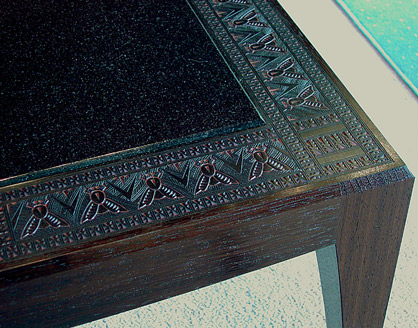
Wenge, pau ferro, dyed pearwood, black granite.
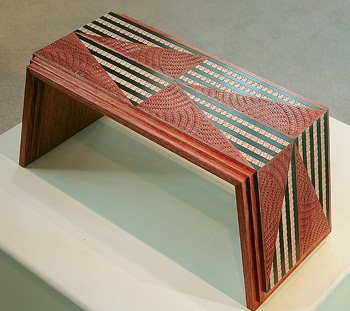
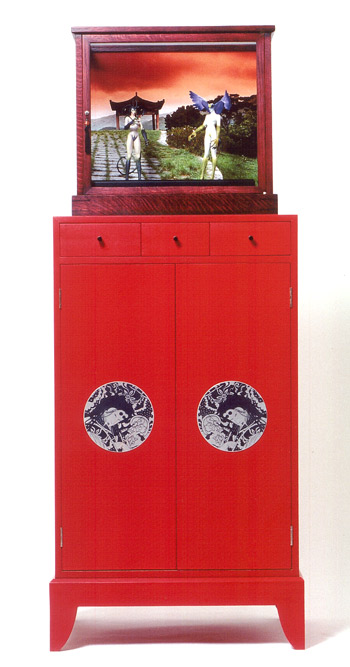
WENDY MARUYAMA:
Turning Japanese
NOTES: Though she would exhibit an occasional piece at Pritam & Eames over the years, Wendy Maruyama's work was not a major presence at the gallery since her two person exhibit with Ed Zucca in 1983. Both artist and gallery thought it was time to remedy this. Maruyama was ready with an idea that had been germinating since the 1990s for a new body of work. The Turning Japanese cabinet series juxtaposes icons of Japanese pop culture like Hello Kitty paraphernalia, a Harley Davidson motorcycle mirror, female warriors and Godzilla figurines, Devilman comic book series, and "hentai" (Japanese slang for perverted) comic books with antique prints of samurai, women in kimonos, temple gardens, and images of the great Kamakura Buddha.
The new cabinets are about the myths and contradictions she discovered when she visited Japan in the 1990s. Maruyama says these cabinets represent a complete contrast to the doll cases of her childhood and are a more accurate depiction of what she sensed in contemporary Japan.
The floor standing cabinets are glass display cases on simple, painted cabinetry. According to Maruyama, this design relates to the traditional Geisha doll cases she remembers from childhood where the porcelain doll was encased in glass. The King of the Monsters cabinet, with its elegantly proportioned case, supports a glass top with a diorama featuring a Godzilla figurine stomping through a Japanese city with a laser print image of Mount Fuji in the background.
In contrast to the quiet green of the Monsters cabinet, Angry Asian Women is a brilliant vermillion red. Its diorama presents two Devilman comic book female warriors standing in front of a photo montage of an ancient Japanese temple, its overgrown steps appearing to descend towards the figures who stand with glowering consternation. The sky is threatening. The doors of the cabinet have two lazer-burned tonsui-like plates of a geisha with a hand inside her kimono, an image from a 17th-century Ukioye wood block print. “I saw this woman as sure of herself, assertive, and a dangerous character. I love the depiction of women through these modern idioms. It’s a complete contrast to the geisha dolls in their glass cases from my childhood.”
In addition to these floor standing cabinets, there were nine wall hung cabinets and prints cases. These cabinets winkingly reference the Tokonoma alcove in traditional Japanese homes that house scrolls, flower arrangements, and other art. Chick-Chicky Boom-Boom, with its Harley Davidson mirror functioning as the cabinet pull, stands in stark contrast to the classical intent of the Tokonoma.
Although their work is a study in contrast as far as style, material, and focus, Maruyama and Madsen share a background of rigorous training in furniture making as well as status as among the most prominent figures in the American studio furniture movement. Also, Maruyama and Madsen have been friends since the early 1980s when they both exhibited at ArtPark in Lewiston, NY.
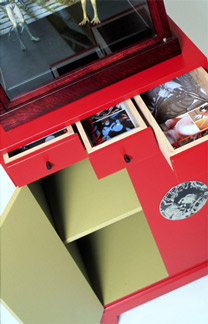
Polychromed mahogany, quarter-sawn white oak, laser-etched stainless steel, glass, digital images, figurines.
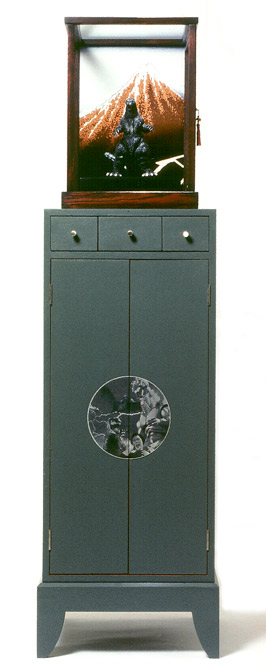
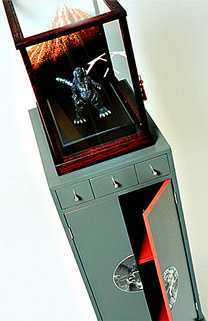
Polychromed mahogany, quarter-sawn white oak, photo-etched stainless steel, glass, digital images, figurine.

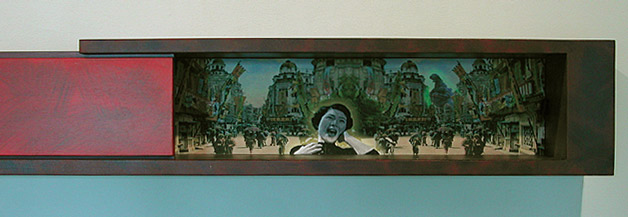
Interchangeable backgrounds.
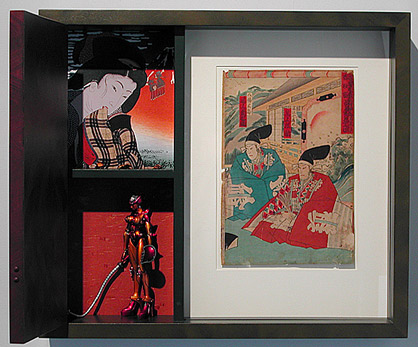
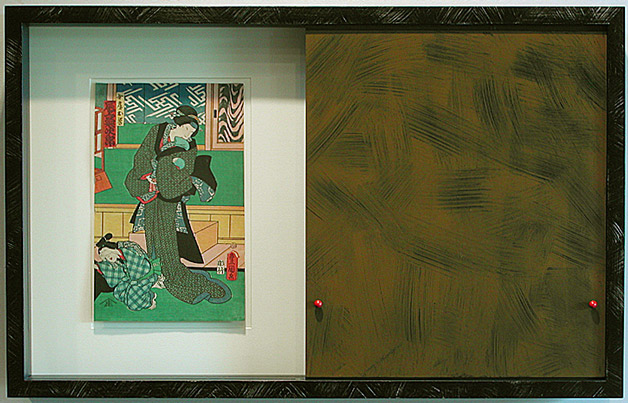
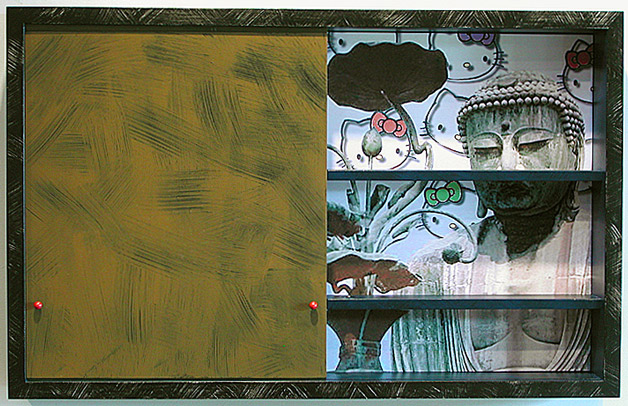
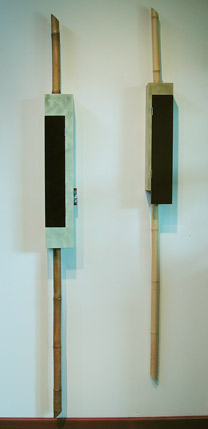
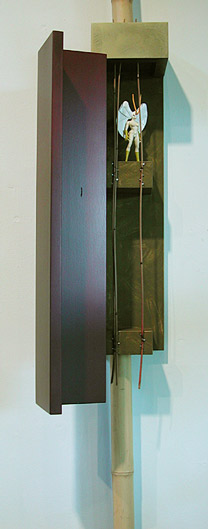
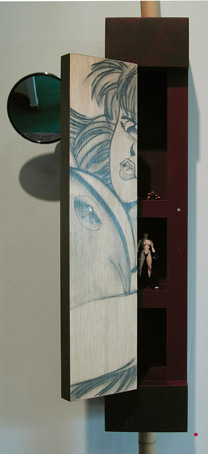
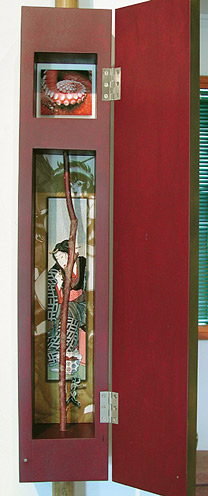
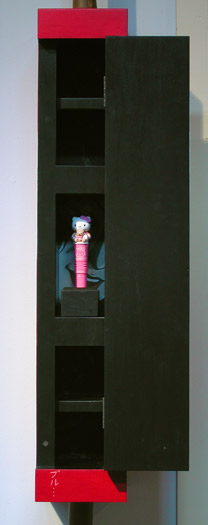

EARLY SPRING SHOW 2003
Michael Cullen, David Ebner, Duncan W. Gowdy, Janene Hilliard, Kim Kelzer, Tony Kenway, Gary S. Magakis, Greg Smith, Craig Vandall Stevens, Fran Taubman, Joe Tracy, Rick Wrigley
NOTES: Duncan Gowdy's three wall-hung cabinets evoke a homesteading motif that seems to run through his work. His careful choice of material, imagery, and color, all lend themselves to charming effect.
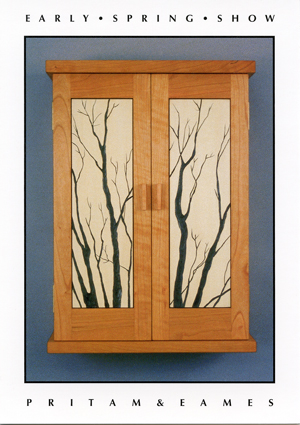
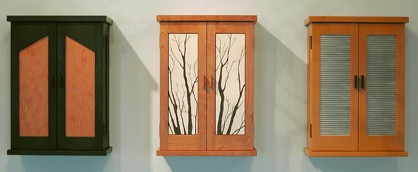
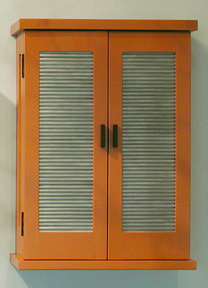
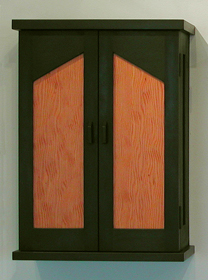
Poplar, aluminum, paint.
Walnut, salvaged Douglas fir, dye.

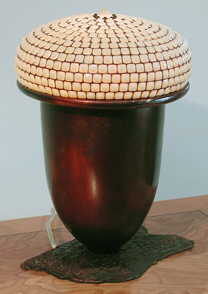
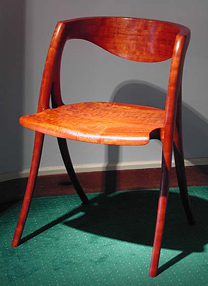
Figured mahogany.
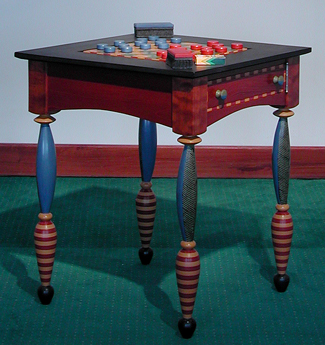
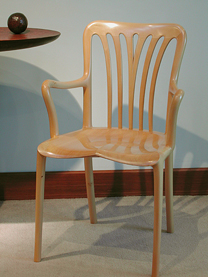
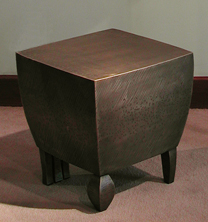
Tasmanian huon pine.
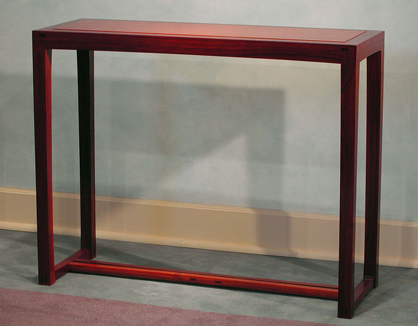
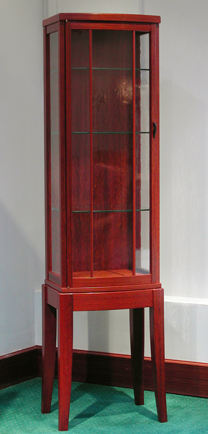
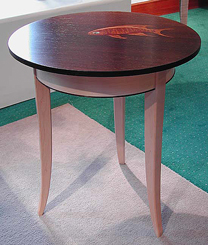
by CRAIG VANDALL STEVENS:
Wenge, maple, marquetry woods: pau ferro, pear, maple, bloodwood,
quilted mahogany, mother of pearl.
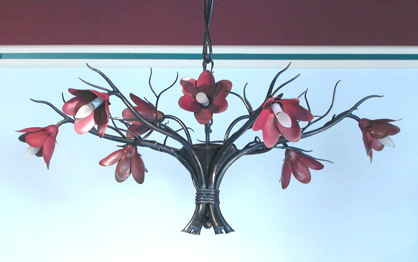
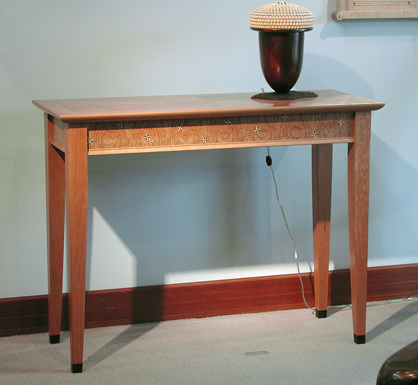
STUDIO FURNITURE 2003
Dale Broholm, Andy Buck, John Eric Byers, John Dunnigan, David Ebner, Noel Hilliard, Thomas Hucker, James Krenov, Kristina Madsen, Judy Kensley McKie, Brian Newell, Richard Scott Newman, James Schriber, Greg Smith, Fran Taubman, William Walker
NOTES: Kristina Madsen's bench is simple in structure and spare in sculptural detail, but it continues her use of this genre as a canvas for pattern exploration. Here the use of triangular form yields an aggressive design while the use of black and white tones within the context of the natural wood color, accentuates their pattern. Note how the canted sides control side-to-side stresses.
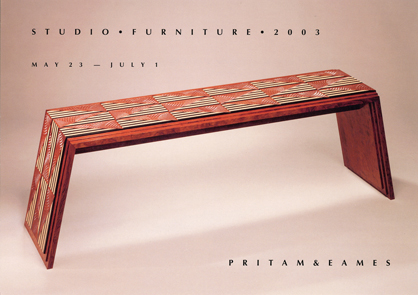
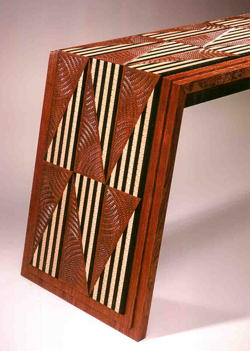
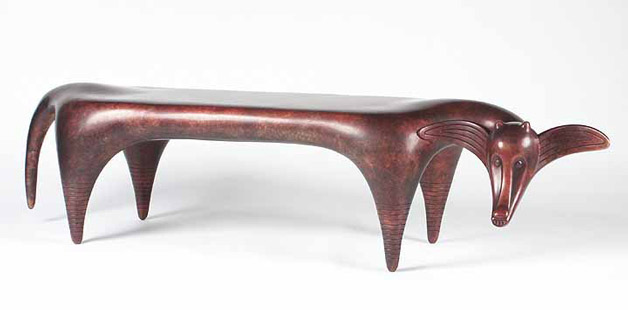

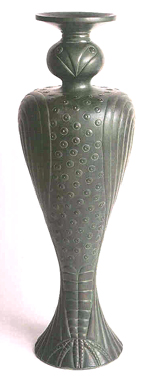
Cast bronze.
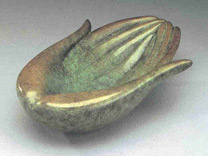
by JUDY KENSLEY McKIE:
Cast bronze.
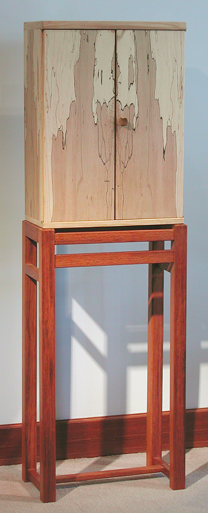
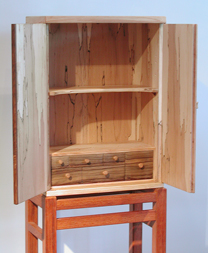
From California, James Krenov sent a small cabinet in his continuing family of cabinets on stand. Its simplicity in style gives presence to his sensitivity for wood selection, while the asymmetrical layout of the six small drawers inside add visual interest. Krenov liked to place features on his cabinets asymmetrically to suggest an unplanned aspect to his cabinets.
The cabinet by Greg Smith, who studied with Krenov, exhibits his teacher's sensibilities, but also his own direction with a two-level, footed but door-enclosed base, and the use of glass in the two top doors. Krenov occasionally used glass in cabinet doors, especially his small wall-hung designs, but he also used open, wood-framed space, as well as curved to vent door panels to give a cabinet openness. Smith's cabinet is slender, accentuating its height, and follows his teacher's lead in the use of claro walnut for the top section and kwila and yaka in the lower section.
William Walker and Brian Newell once studied with Krenov at the College of the Redwoods. Newell was already a carver by personal inclination; his contribution to this show was a miniature Lookdown Fish carved from boxwood. Newell's time spent in Japan makes one think of the netsuke carving that might have influenced him to make this piece.
Walker's pair of bubinga side tables has handsome functional proportions, but also an elegant slenderness with their gently arched aprons and legs set into the corners at 45-degrees.
Spalted beech, kwila stand, laurel and Cedar of Lebanon drawers.
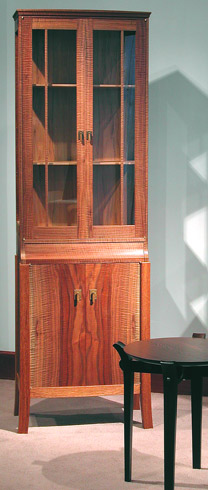
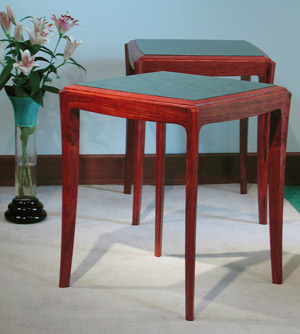
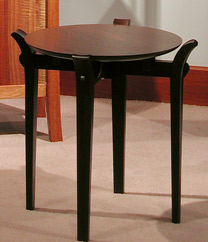
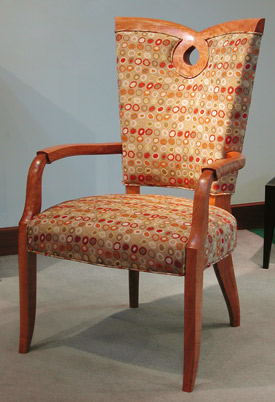
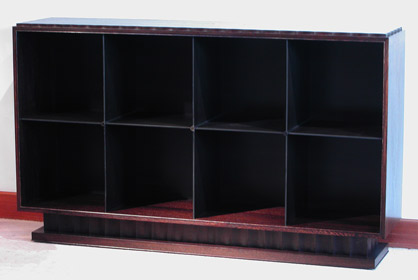
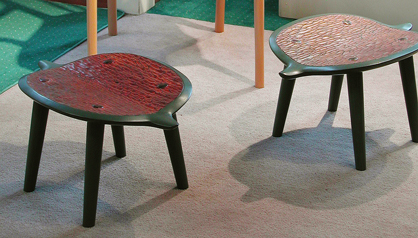
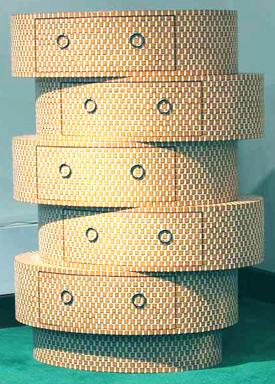
African mahogany, Honduras mahogany, hand-forged iron, milk paint.
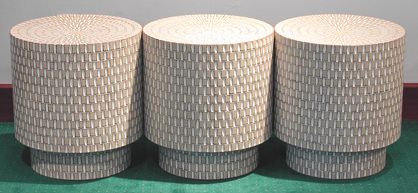
African mahogany, Honduras mahogany, milk paint.
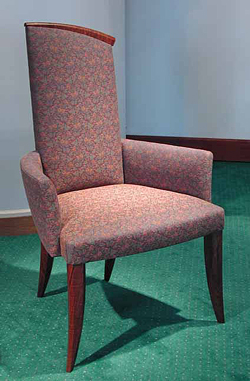
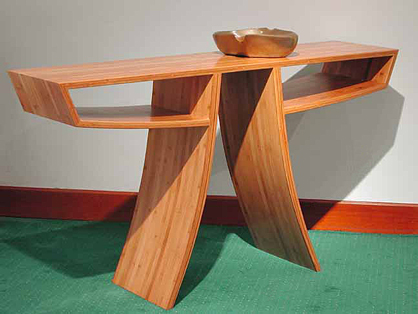
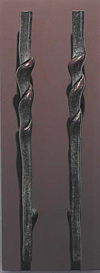
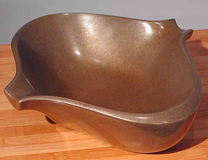
Cast bronze.
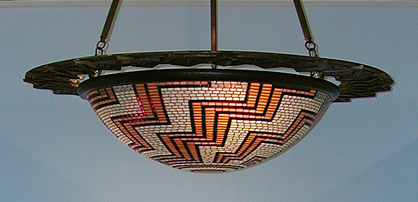
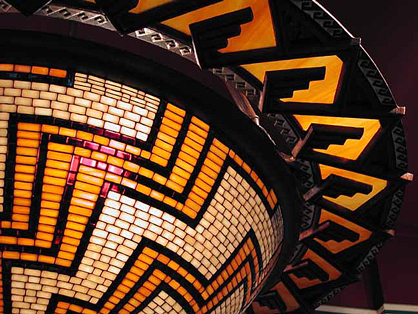
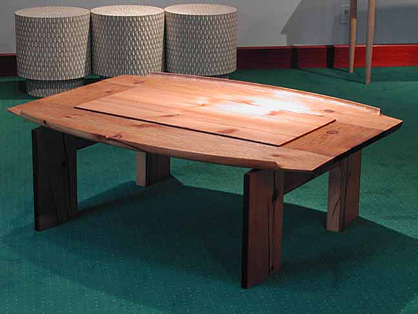
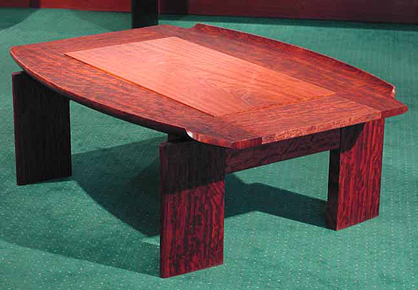
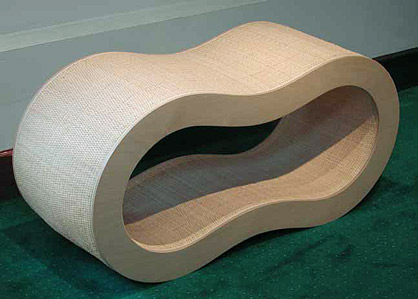
Baltic birch plywood, pre woven chair cane, Poly-fill.
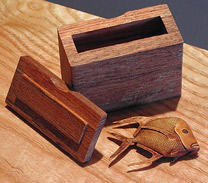
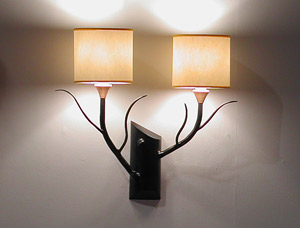
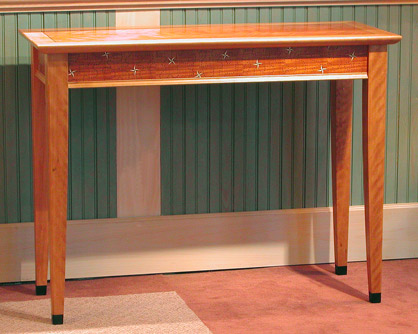
Hall Table by RICK WRIGLEY:
Cherry, makore, ebony, holly.
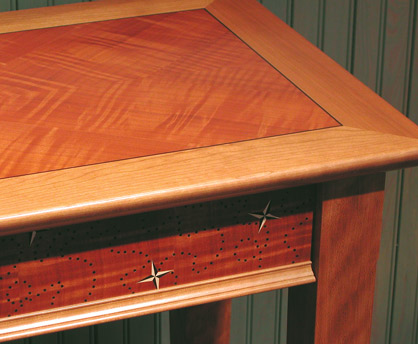
DEAN McILWAIN - 2003
Wall Bowls
NOTES: Dean McIlwain's carved and milk-painted Wall Bowl series combined form and function: the bowls, carved from various woods, could be used as a table top accessories or hung on the wall as decorative objects.
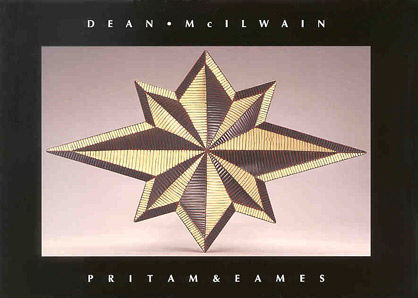
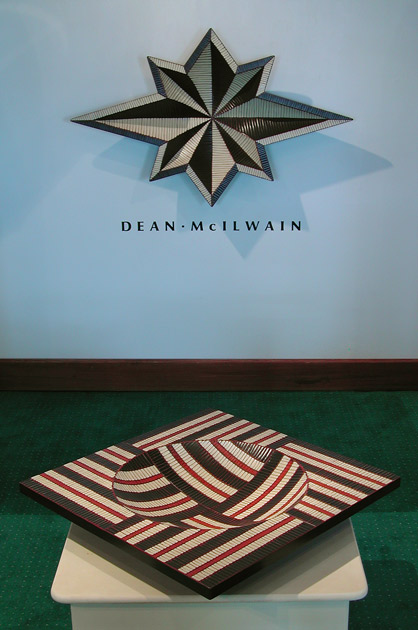
Banded Square Circle: Poplar, milk paint.
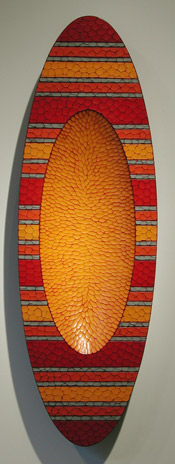
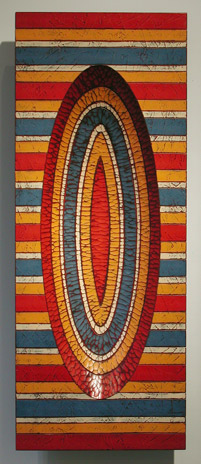
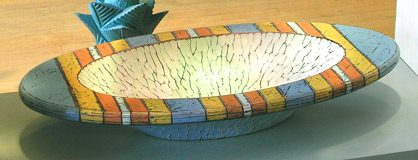
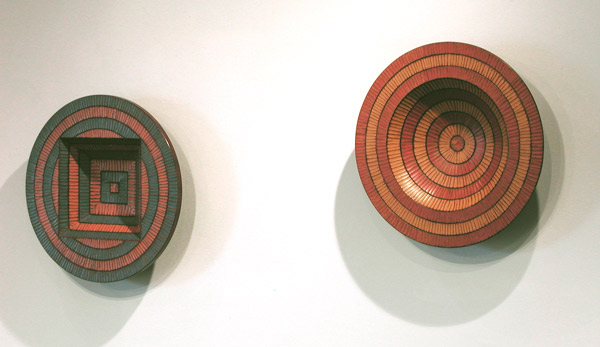
Mahogany, milk paint.
Mahogany, milk paint.
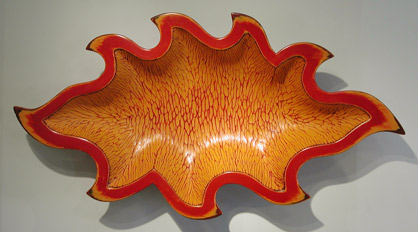
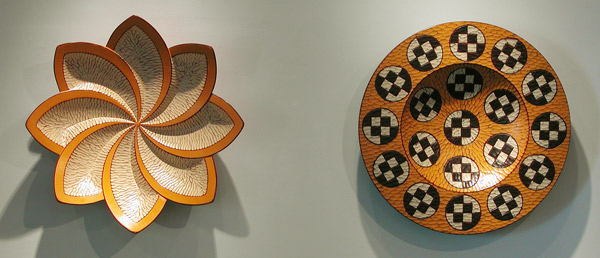
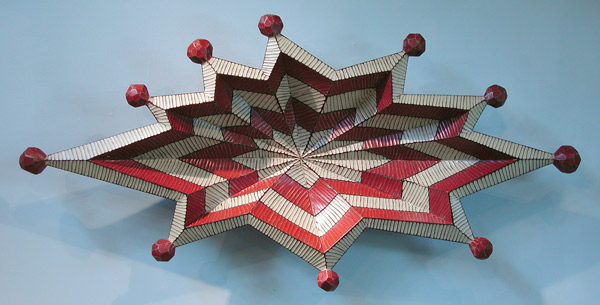
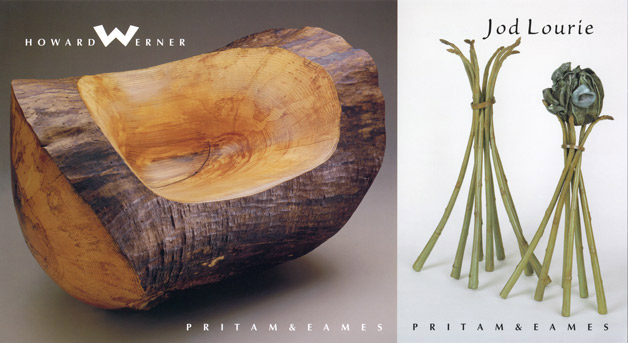
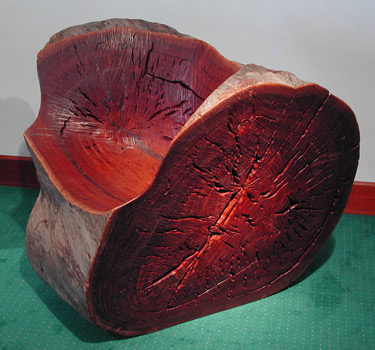
HOWARD WERNER - 2003
Heroic Furniture, Vessels & Sculpture
NOTES: Pritam & Eames began exhibiting Howard Werner’s work in a 1985 show titled Subtractive Work. In that show, the Star Dining Room Table particularly illustrated Werner’s skill in chain saw carving. The carving combined fine external texture work with parallel internal planes that are very difficult to achieve. The earlier show presaged the flow of strong work that would come from Werner's upstate New York and Arizona studios.
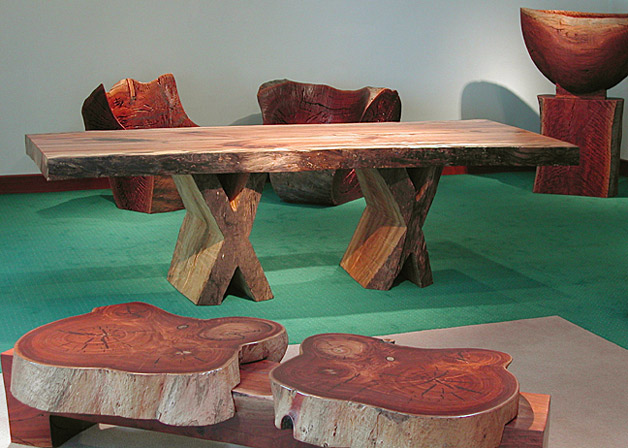
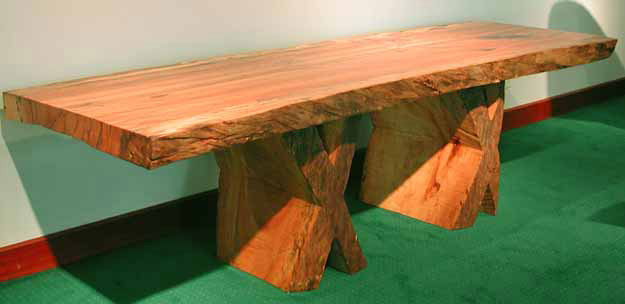
The two Eucalyptus chairs, although in practice surprising comfortable due to the sensitive sculpting of the bowl forms that create the seat, step more dramatically into the realm of sculpture. Here the bowled interiors are nicely set off by the exterior planes of the sides and back.
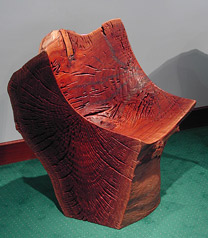
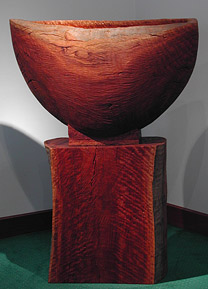
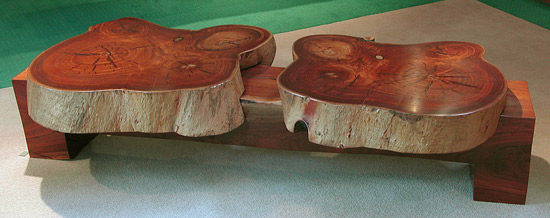
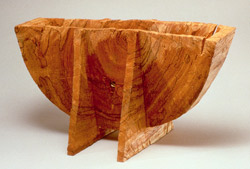
The show also included two low tables. The Double Pad Table also succeeded through its use of contrasting forms. In this piece, the stolidity of the minimalist bench support is saddled by two pad forms which straddle, and yet float, on this base. While the one form is purely geometric, the pads are encircled by the live edge of the eucalyptus log from which they were sectioned.
There were also four vessel forms that rounded out the show, each vessel was sculpted from a different wood in Werner’s investigation of pure form.
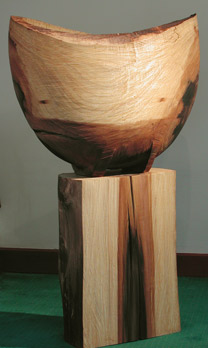
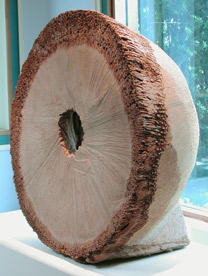
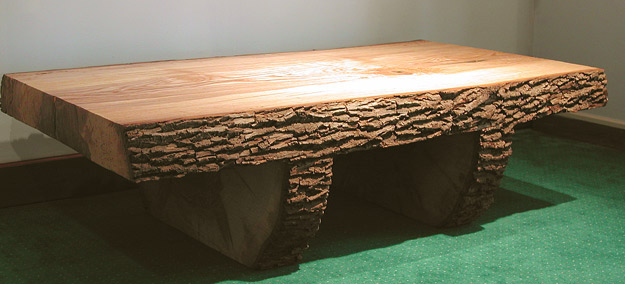
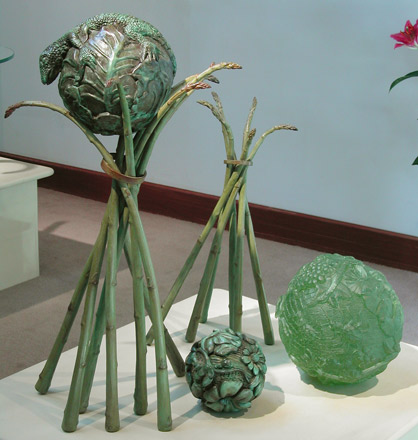
JOD LOURIE - 2003
Appetites:Tables & Garden Objects
(Bronze editions of 12)
NOTES: Trained as a sculptor and ceramist, Jod Lourie chose bronze and glass as her mediums for this show. Her fine arts background notwithstanding, Lourie made a decided effort to include utility as an added attraction to these delightful sculpted vege-tables and stands for the garden and home.
Lizard Ball: Bronze / Flower Ball: Bronze / Beetle Ball: Glass.
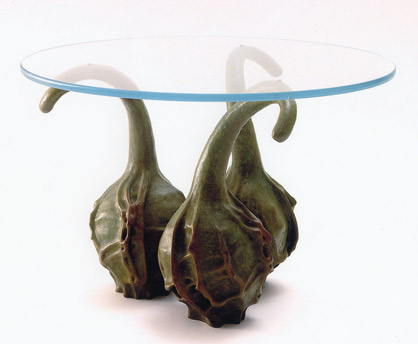
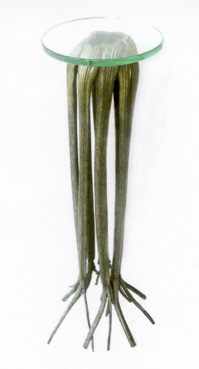
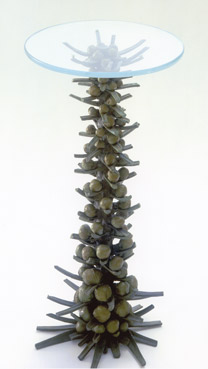
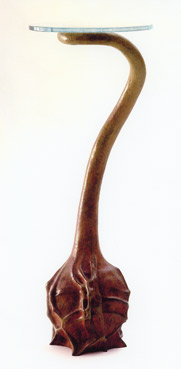
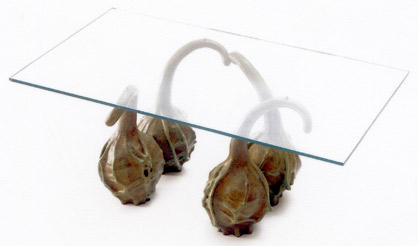
JERE OSGOOD - 2003
NOTES: The title of Osgood’s chest of drawers in this show was Semaine et Deux. A semainiere is a French term for a chest that has a drawer for each day of the week; typically, the semainiere holds lingerie. In this piece there were nine drawers; often it was referred to as the Tall Chest. The claro walnut used in its case and drawers was handsomely embellished with faux ivory pulls. This piece joins Osgood’s historical family of chests of drawers including his high chests, low chests, and now this tall elegant form.
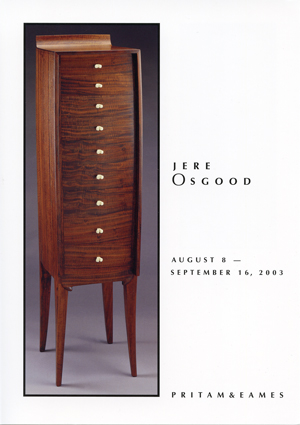
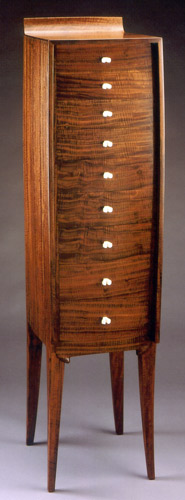
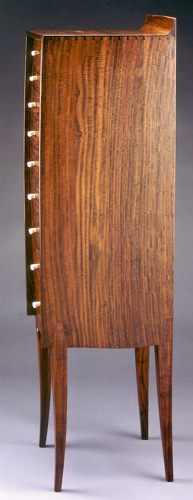
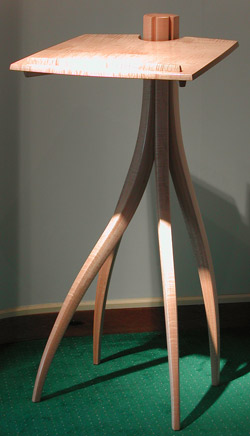
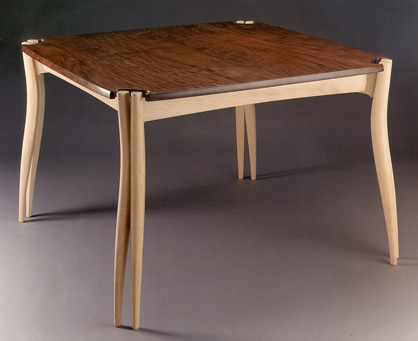
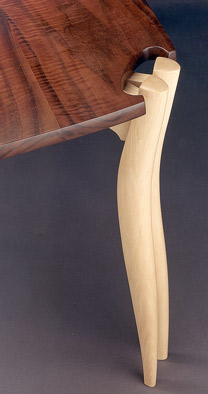
Table for Two by JERE OSGOOD:
European hornbeam, claro walnut.
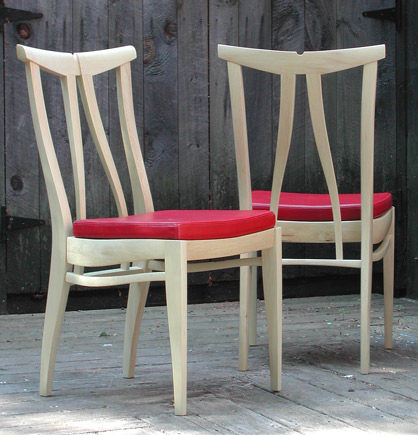
His pair of chairs, also made in European hornbeam, continue the theme of a split branch design and is used in both the design of the side aprons with their accompanying stretchers as well as the design of the back support. One note about the form of the back support: although this split tendril design has appeared before in Osgood’s chair work, in these earlier chairs the termination of each tendril from the crown was at an acute angle into the rear leg. In these chairs, he instead uses a slight stretcher between the rear legs that allows a more satisfying structural termination and which alleviated the tendrils traveling all the way to the two sides.
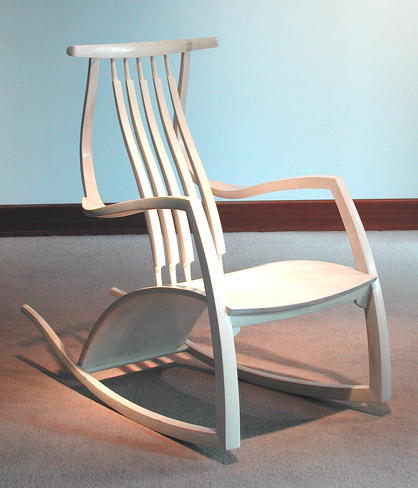
THOMAS HUCKER - 2003
NOTES: Tom Hucker introduced a new rocker in pickled maple in this show. There are a number of striking features about this chair starting with the seat that curves all the way to the floor where it joins into the rocker base. At first this appears to be a familiar shield-like form that Hucker has used before, but here the seat begins in a concave form which gradually flattens as it curves towards the floor. The concavity for the comfort of the human form, the flattening allowing for the downward bend. Equally audacious was the continuous ribbon form of the arms which extended from the back’s crown through the vertical rise of the front leg in a seemingly continuous form. The delicacy of this first rocking chair attracted a number of women who happily tried it. Later versions were re-dimensioned to accomplish more universal comfort.
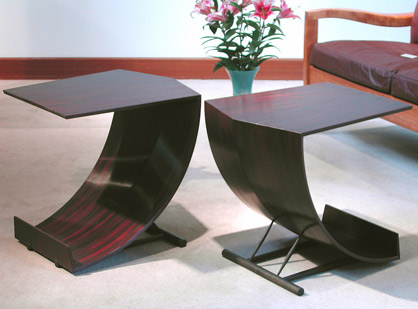
The vertical members of this side table by Hucker represent another example of a complicated puzzle that he likes to take on, which has its roots in his novel structural designs. This bent shield begins in a gentle chevron shape as it joins with the top but, as it sweeps down to its foot, ends as a straight line. The gentle chevron gives him necessary triangulation for his joint with the top, while the foot creates a simple modernist terminus. The shield, or forms using bent planes, occur throughout Hucker's work.
In the 1990s, Hucker came across salvaged 200-year old pine boards that had come from the king post of the renovated Philadelphia Academy of Music. He turned this material into a series of furniture pieces.
Hucker has always liked to play with opposite tensions -- buoyancy and mass, light and dark, elegance and poverty. He likes translucency in his cabinets but avoids plain glass as a solution. In the Kueihsing cabinet [introduced in 1999] he uses Japanese silk glass, which imparts a misty quality as opposed to the opacity of frosted glass.
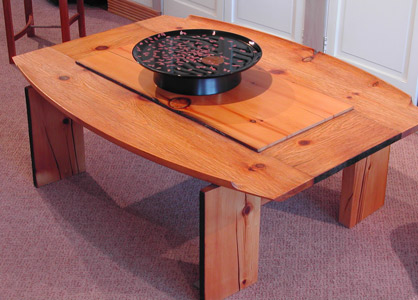
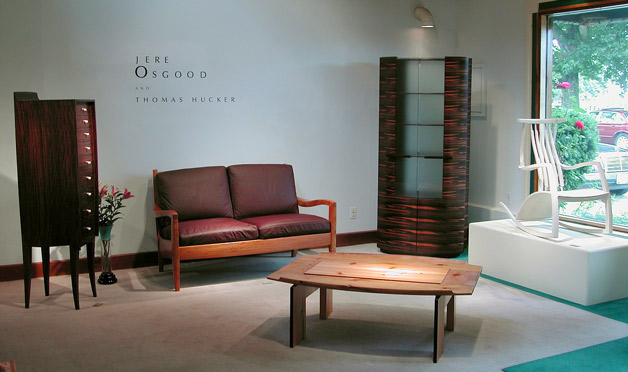
NOTES: It was Michael Hurwitz who introduced the gallery to the work of Yuji Kubo. Hurwitz had apprenticed with Kubo in Japan to learn the traditional art of lacquer-making. Hurwitz called one day and said, "You must have his work!"
Kubo works in the traditional meticulous 45-step process -- taking two months to complete a single piece.
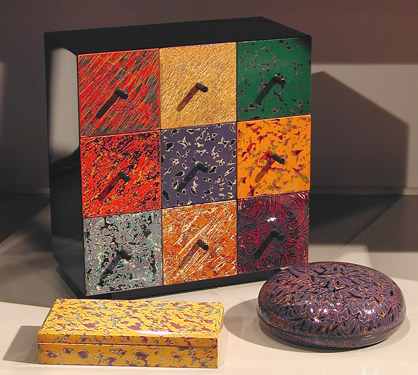
Urushi lacquer.
Round Box: Medium density fiberboard [MDF], potter's wheel molding,
urethane ground, Urushi lacquer.
Rectangle Box: Cypress, plywood, Urushi ground, Urushi lacquer.
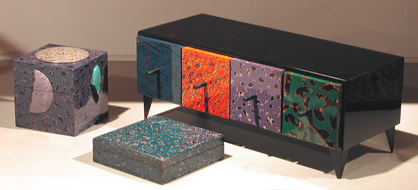
Box: Cypress, plywood, Urushi ground, Urushi lacquer.
Box with Four Drawers: MDF, plywood, Urushi lacquer.
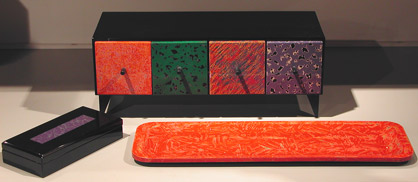
Urushi ground, Urushi lacquer.
Rectangle Box: Cypress, plywood, Urushi ground, Urushi lacquer.
Long Tray: Plywood, urethane ground, Urushi lacquer.
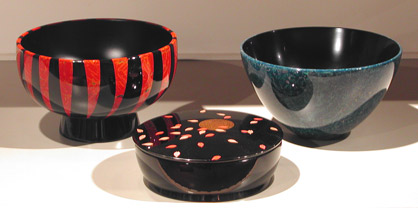
Cherry Tree Round Box: MDF, potter's wheel molding,urethane ground,
Urushi lacquer, silver.
Blue Bowl: MDF, potter's wheel molding, urethane ground, Urushi lacquer.
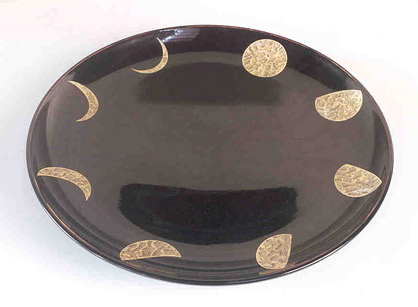

Michael Cullen, David Ebner, Hank Gilpin, Duncan W. Gowdy, Thomas Hucker, Kim Kelzer, Tony Kenway, Gary S. Magakis, Judy Kensley McKie, Jefferson Shallenberger, J.M. Syron & Bonnie Bishop, Rich Tannen
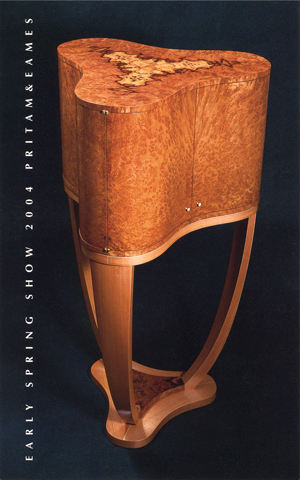
Redwood burl, pear, holly.
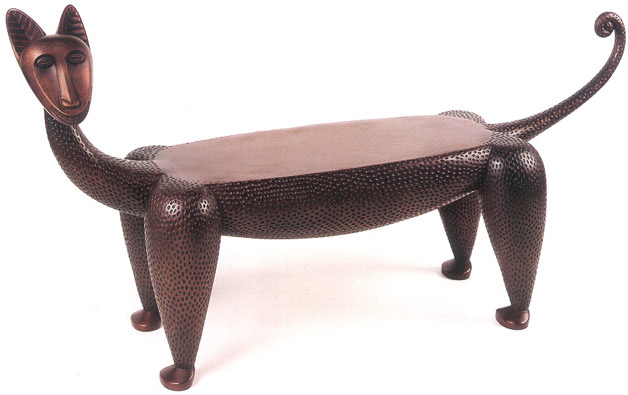
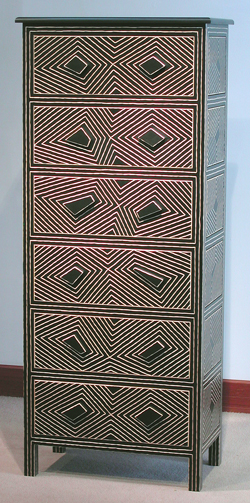
NOTES: Judy McKie's bronze Cat Bench originated as a commission for exterior seating for a children's library in Cambridge, MA. Its form suggests that it can support any burden easily, which its playful, inquisitive attitude seems to invite. There is a continuous arch of strength from the tip of the tail through to the top of the ears.
The show also included McKie's Trapezia Chest. The chest made use of her eye for carved, abstract pattern. The pulls stand proud of the drawer fronts, but set off geometric ripples sympathetic to their shapes. The sides have similar patterns, though their centers rest in the same plane as the side itself.
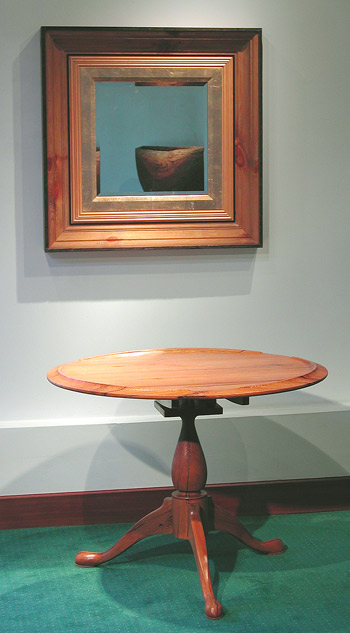
Tom Hucker uses more of the 200-year old pine from the Philadelphia Academy of Music to great effect in his two mirrors and tilt-top table. The tilt-top is one of his favorite historical pieces, Hucker says, because it goes from function to function. He also takes into account that this kind of table would have been in vogue at the time the Philadelphia Academy of Music was built.
The tilt-top table here had carved slipper feet. Also, note the shaped edge of the top is not applied, but carved in relief from the solid top.
Tilt-Top Table by THOMAS HUCKER: Academy oak.
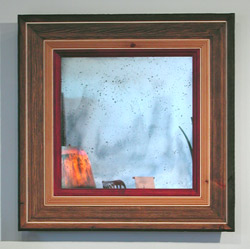
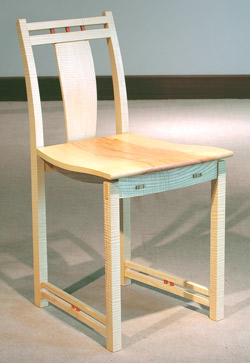
His two side tables, variants on a cross stretcher support design, show how well simple changes can affect the mood and style of a piece.
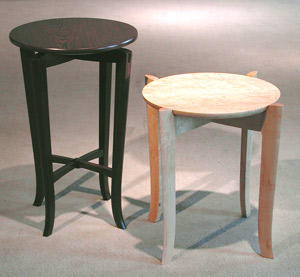
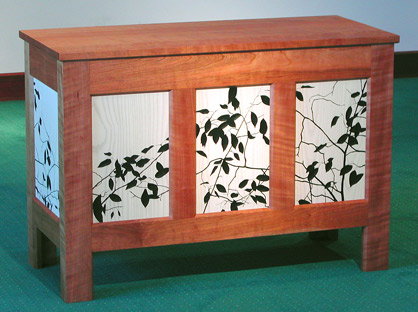
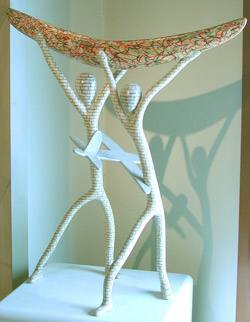
Maple, ash, colored pencil, acrylic, pastel, aluminum.
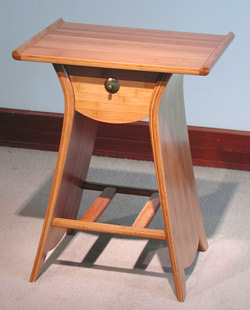
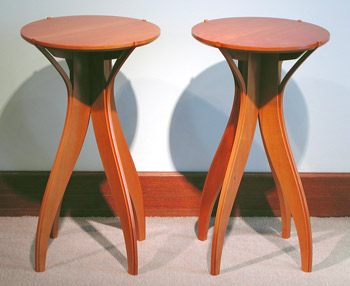
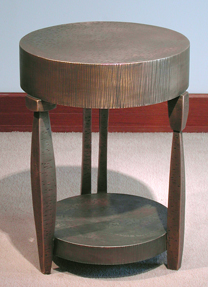
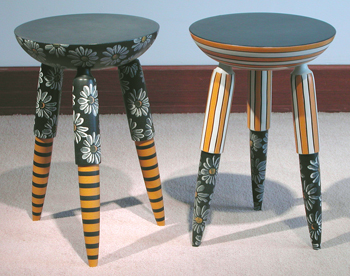
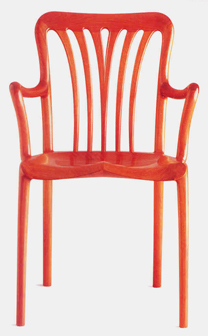
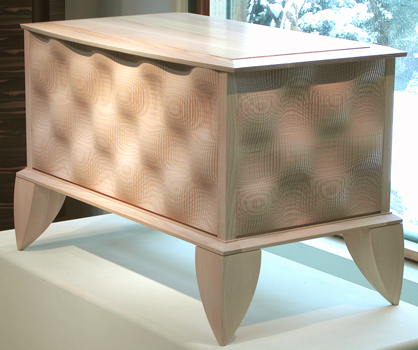
In this turn-of the-century show, Rich Tannen's blanket chest in ash is a fine example of his experimentation with CNC router carving. The suggestion of a checker-board pattern, though made with gentle hills and valleys, allows a wonderful exposure of growth ring patterns in its smoothly mottled shaping. The CNC relief carving is also textured.
Blanket Chest with Till by RICH TANNEN: Ash.
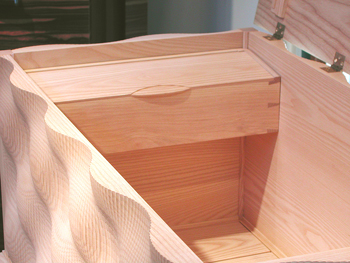
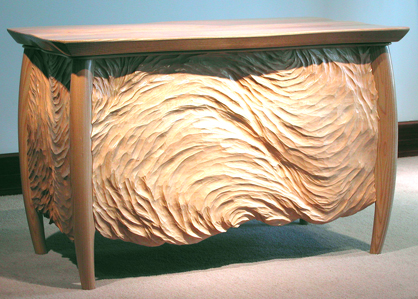
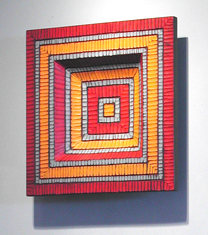
by DEAN McILWAIN:
Port Orford white cedar, milk paint.
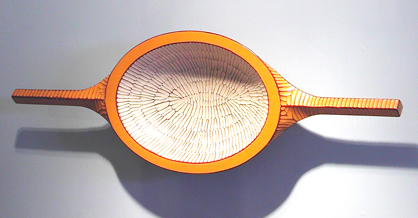
ANNIVERSARY SHOW 2004
Dale Broholm, Jon Brooks, Andy Buck, John Eric Byers, Michael Cullen, David Ebner, Janene Hilliard, Thomas Hucker, Michael Hurwitz, Tony Kenway, Richard Scott Newman, Jere Osgood, Timothy Philbrick, James Schriber
NOTES: The gallery's 23rd Anniversary Show gathered an eclectic array of studio furniture pieces, once again providing testimony to the distinctive individualistic nature of the work.
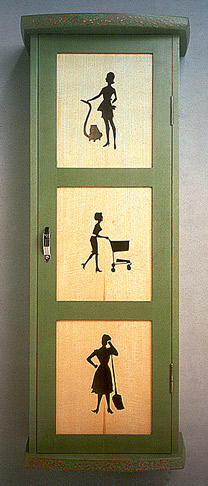
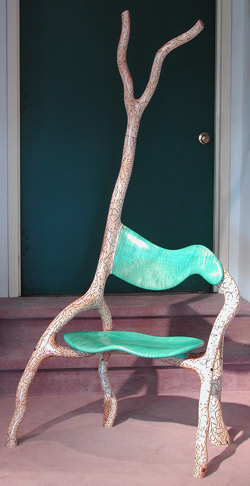
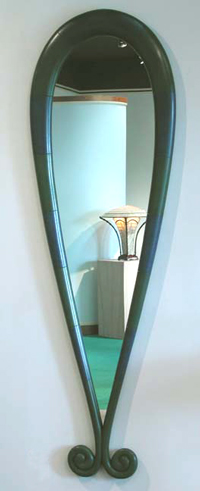
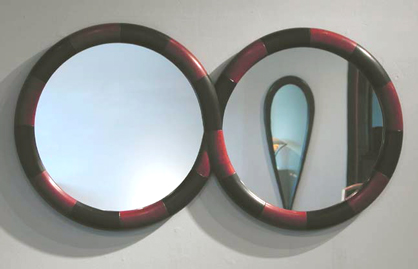
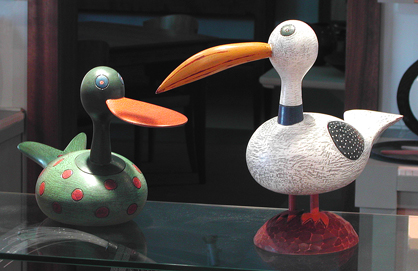
Poplar, basswood, milk paint.
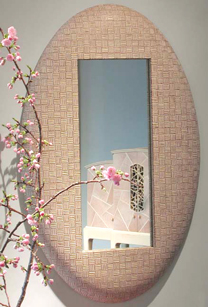

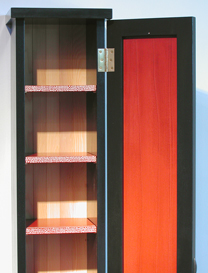
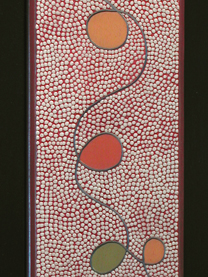
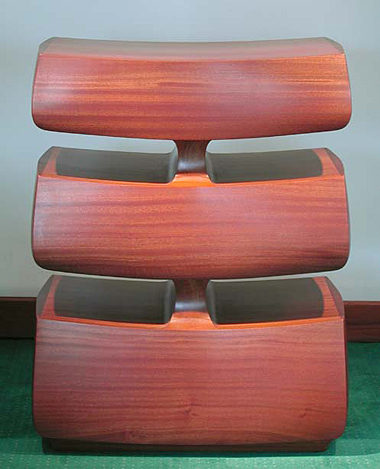
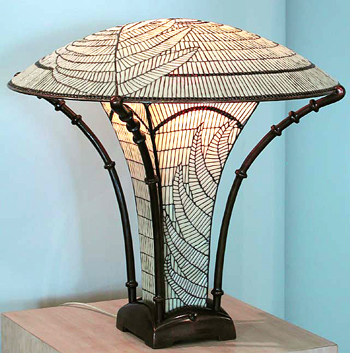
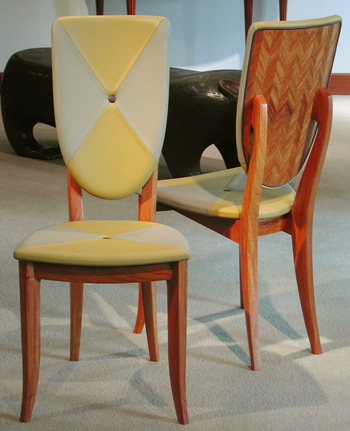
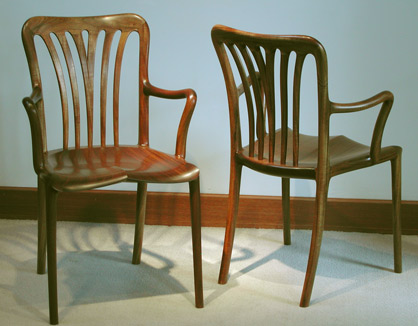
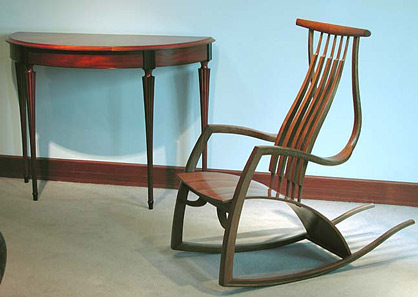
Fumed oak.
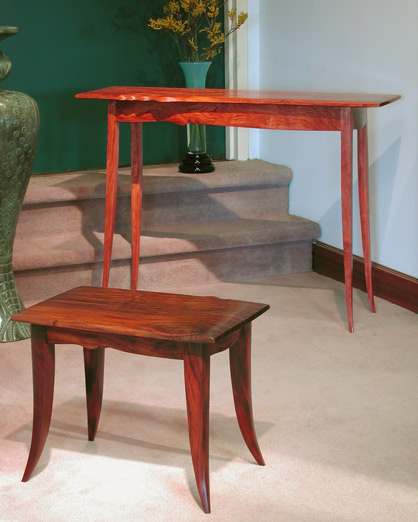
Claro walnut.
Bubinga.
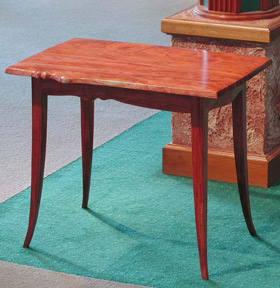
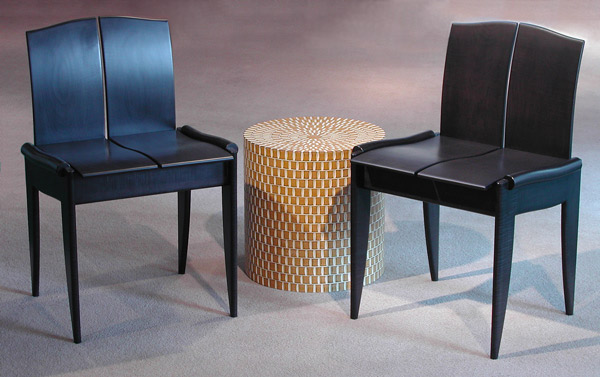
Dyed curly maple.
Mahogany, milk paint.
Furniture 2004
BRIAN NEWELL
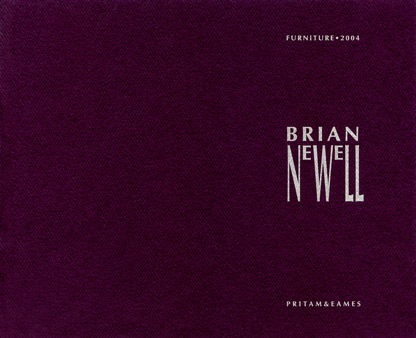
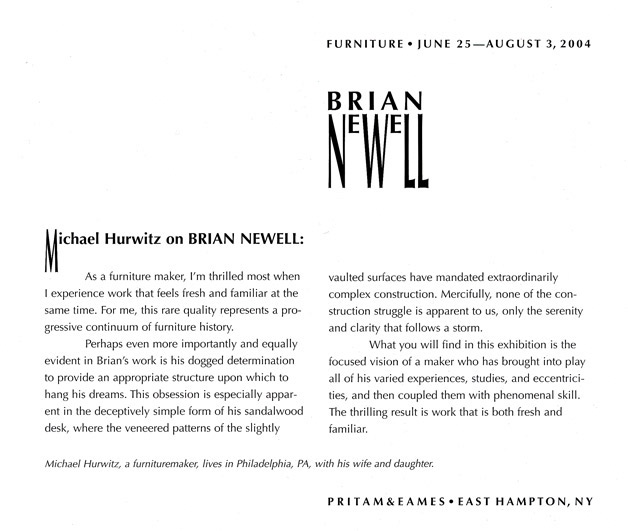
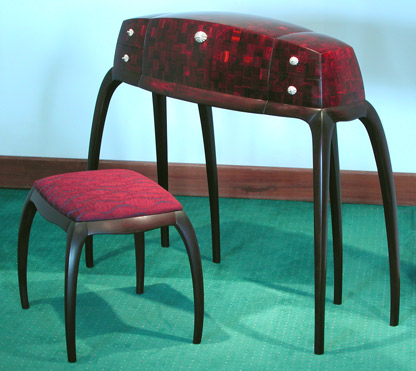
NOTES: The long, arched-legged waiting stance of the drop-front desk is Newell’s metamorphic signature of this period. The companion upholstered bench reflects its kinship. Creating a snug, private workspace, the fall-front itself doubles the writing area. A single interior shelf stretches between two twin pairs of small drawers, the silver pulls on the drawers and the fall-front complete an elegant closed front. Standing back, they create a watching creature’s presence.
The blanket chest, also caught in a stance of frozen mobility, has an ancient feel without any obvious nod to a past period, and is wonderfully focused in the sand-cast latch that was designed by Brian and cast for the chest by a kettle-maker in Japan. Seated on a stand of Macassar ebony, the chest is covered by a material which is, in fact, ancient: jindai cedar that has been harvested from cedar logs which have lain in bog for centuries.

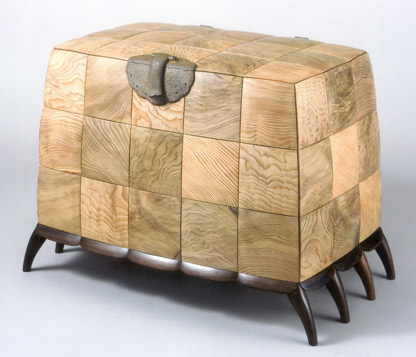
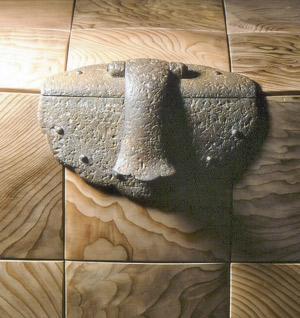
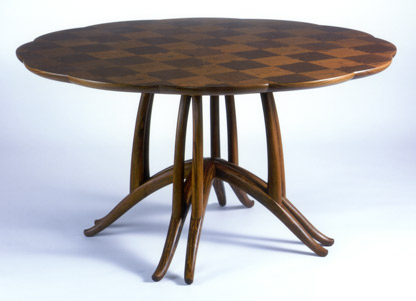
The eight-legged (four discrete pairs) small dining or breakfast table has a parquetry pattern top of large squares, which along with the scalloped edge of the top, give the piece a fresh and informal air. A central intersection of the four pairs of legs obviates the need for a central post. The table’s companion four chairs have an aerie simplicity which obscures a firm grasp of structure. Given the continuous form of the chair, the seats themselves offer only the firm comfort of cushioning on a flat plane; they are, however, comfortably wide.
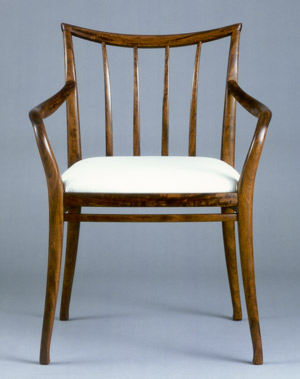
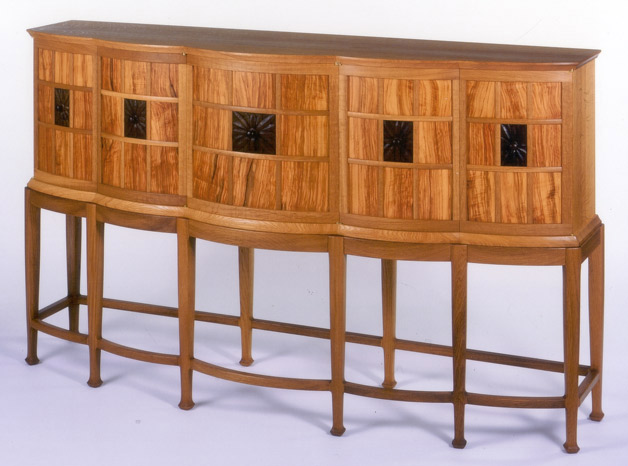
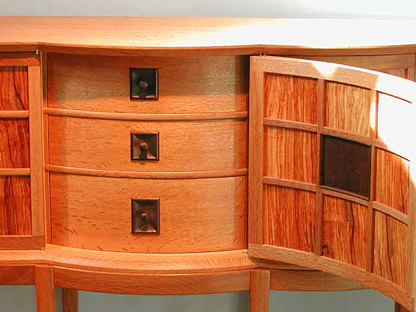
The show’s third carcass piece was a five and one-half foot wide sideboard. Its richness was created by a successful pairing of a Japanese white oak stand and carcass frame with the lushness of olive panels in its five doors. The visual strength of the piece was amplified and focused in the carved imbuya pulls. Notice the ascending door width from the sides to the center.
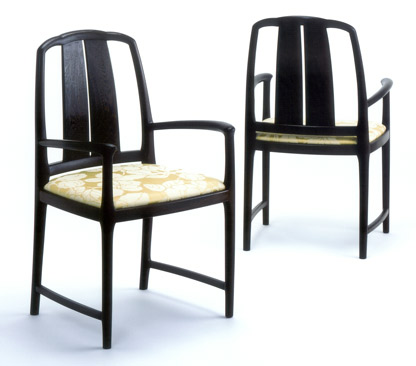
A large oval dining table was made intricate by its striking top surface which was composed of almost a 1,000 feather-shaped pieces. The feather shape offered the possibility of both inter-locking and expanding in number as the pattern radially expanded from the table’s center.
Occasional use of the blackwood’s light sapwood gave the illusion of radiating, shooting stars. The six-legged pedestal arched and junctioned mid-point again allowed the foregoing of a central post. The companion dining chairs for this dining table were simply framed and well-structured with seats of ample width but minimal cushion comfort. The floral design of the chairs’ fabric added to the attitude of a Chinese scholar’s chair.
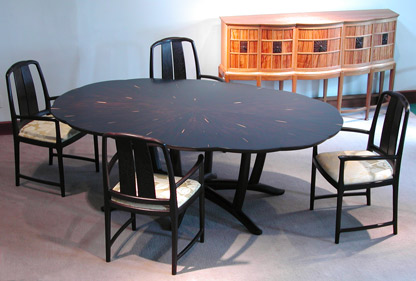
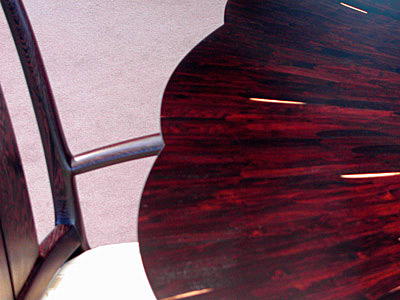
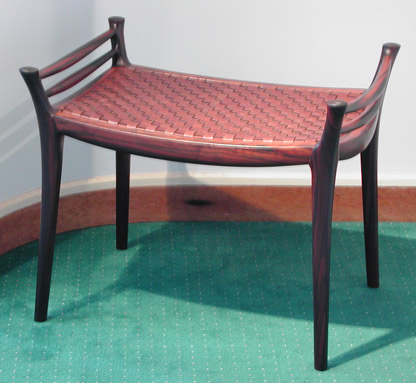
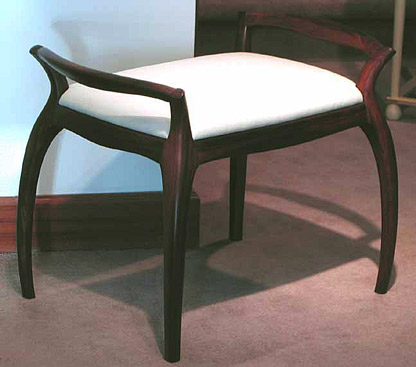
Brian Newell’s group of forms was rounded out by two additional small benches, and two exquisite boxes, one of ebony and the other of jindai cedar with an eye-catching, pierced carved African Blackwood top pull.
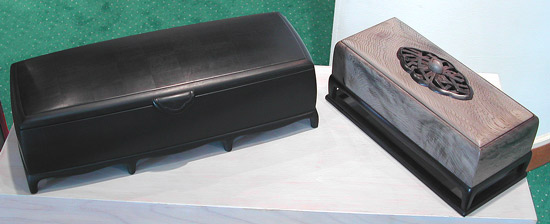
The Furniture Art of
JUDY KENSLEY McKIE
2004
NOTES: The 2004 show of Judy Kensley McKie’s work at P&E was her seventh one-person exhibit at the gallery. The background of the exhibition catalogue’s cover was a detail of the Drum Table, one of the six bronzes in this show. The pattern was used in the piece as a dense and arresting visual texture for the revolving side of the table. It is an unusual pattern suggestive of the layering and folding of material. The form of the table was like a bobbin or cable spool; this piece captures attention between movement and permanence.
Of the 13 pieces of furniture in the show, six were bronzes, five were wood, and the last was her first attempt to create a furniture piece of scale in resin. Molded plastic furniture has, of course, been around since the 1950s, but with resin, McKie saw workability similar to bronze. By carving a model, she could create a mold into which resin could be poured for a replica. McKie pushes new material boundaries with her Ivory Couch in resin.
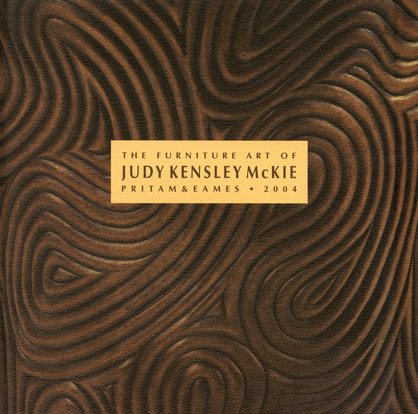
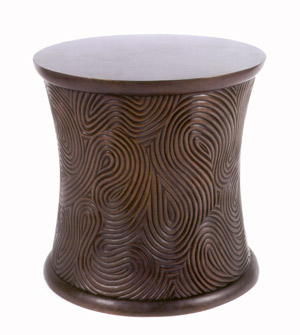
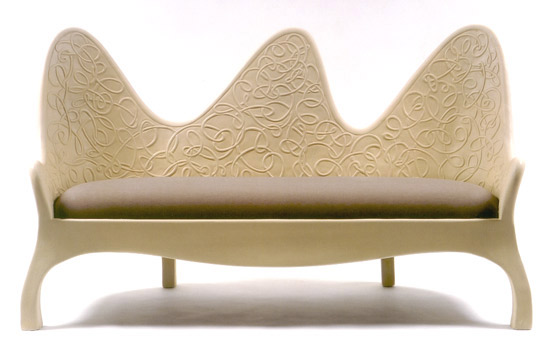
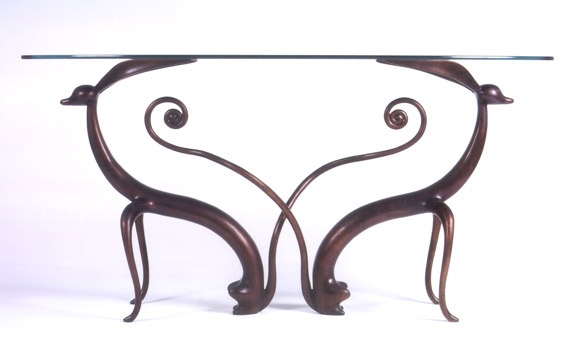
A second bronze piece, the Rabbit Sideboard, used a long standing theme in McKie’s consoles: twin animal figures with interlacing tails. In the gallery opening show in 1981, the glass top console table with two dogs, each dog held a bone in its mouth, the end of which supported a glass top. In the Rabbit Sideboard, it is the wind swept ears that support the top. More important is the difference in sculptural form in this sideboard. Every curve supplies the suggestion of movement in these rabbit creatures, from the swept-back ears, to the forward inclined heads, to the coiled hind quarters. They are delightful as interlocking forms, reminding one of the best gestures of Art Nouveau or the flowing energy of Rococo.
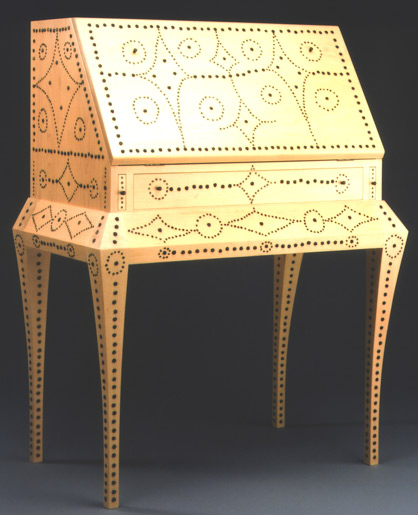
Lady's Writing Desk is a fall-front in function. With its two-fold expansion of the horizontal area when opened, and its off limits private space when closed, it is a powerful classic form. This desk, with its armored, nail-patterned exterior and severely angled form, delivers a character of a different sort from the Rabbit Sideboard. Stature and self-assurance give way only at second glance to more feminine details: the canting of the apron hints at hips and the spare designs of the nail-headed patterns suggest female anatomy. Closed, the pulls are sufficiently minimal to be absorbed by the nail-head pattern. With a user’s familiarity, pulls can be discerned: two for the full-out supports for the fall-front and the two for a wide drawer. On the canted surface of the fall-front, two more pulls can be found to open the writing the surface. The writing surface supports vertical file cubbyholes and two central drawers.
Lady's Writing Desk:
Maple, nails, leather.
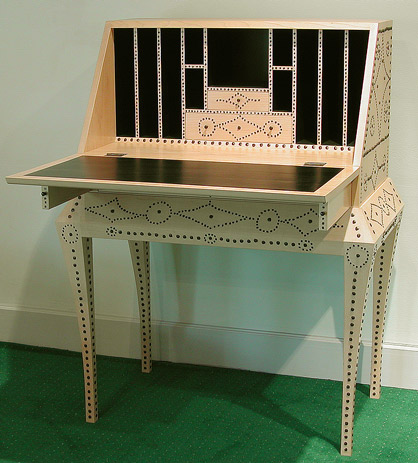
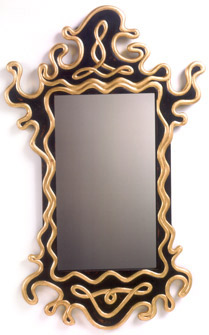
The two mirrors in the exhibition were related in both size and form, and both mirrors were flamboyant in character. The Burning Mirror was not concave and had no means to focus light onto the unsuspecting onlooker, unlike Archimedes’ mirrors. It did have a gloriously baroque frame of gold leaf in flame. Its cousin, the Ribbon Mirror, was also surrounded by a baroque frame only this time the reference was to ribbon and an amusing take on the classical use of ribbon as a decorative element.
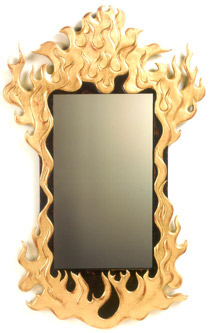
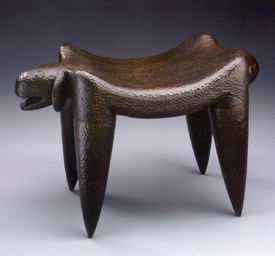
Sometimes a supporting actor steps in and steals the show. The Pet Stool comes from a family of McKie’s animal forms that is strongly identified as a McKie creation by her public. Its gouged, carved surface suggests the material wood, but the flowing line and hidden joinery create a strong sculptural form that transcends the “pet’ of its title.
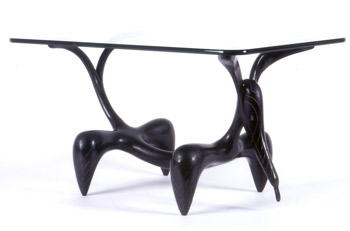
Also using an animal form to produce a strong sculptural presence was the Anteater Table. In this piece, bronze was the material. McKie certainly had bronze in mind when she designed the piece: a glance at how this creature supports its glass top with slender tail and ears shows the reason for the use of bronze. As a low table, its top dimensions were ideal for apartment or intimate space.
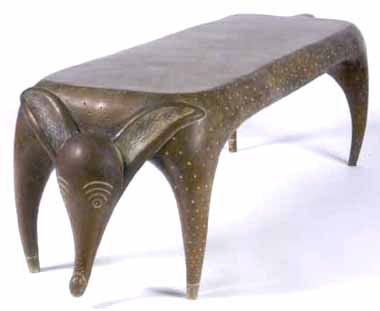
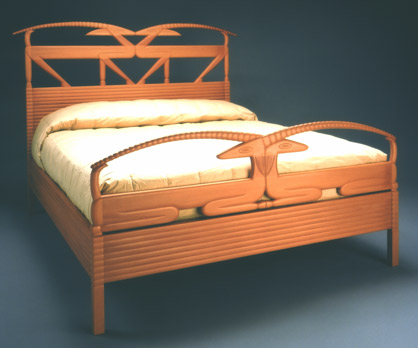
The third wood piece in the exhibition was the pearwood Antelope Bed. A queen-sized bed, designed for the traditional comfort of box spring and mattress, the frame was made from carved pearwood. The mood is benign and nocturnal with sleeping antelopes at the foot and a second pair kissing at the head. McKie returns to her use of interlocking pairs, interlocking in form as well as embrace to create the presence of this piece. The arching crest rails created by the antelopes’ horns in turn define a protected and secure space for repose.
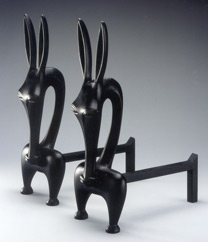
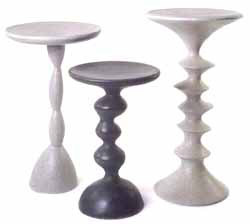
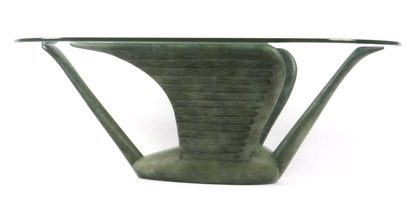
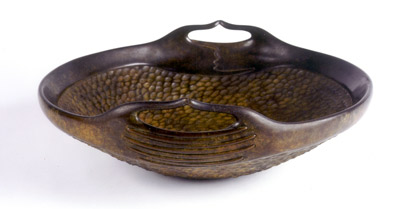

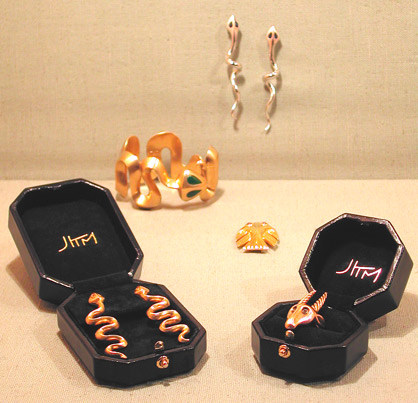
Flounder Pin: 18K yellow gold bloomed, cabochon rubies; Ibex Ring: 18K red gold, brown diamonds;
Sidewinder Snake Earrings: 18K yellow gold bloomed,
natural intense orange diamonds;
Sidewinder Snake Bracelet: 18K yellow gold, jade.
Also in the show were five more bronze pieces: the Timid Dog Bench; the Ibis Demilune; the Swan Table, another low table; and the beautiful Arms Bowl. The Horse Andirons were in cast iron and there were three bird baths in cast stone. To complete the show, McKie introduced her high karat gold jewelry, which was a collaborative effort with jeweler Tim McClelland in which McKie designed the pieces and McClelland fabricated them.
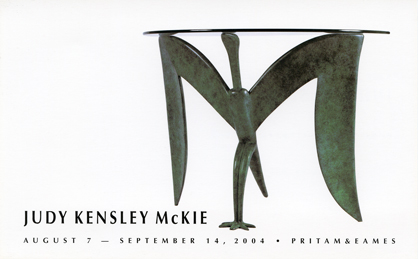
EARLY SPRING SHOW 2005
Ted Blachly, Andy Buck, John Eric Byers, Tim Coleman, Michael Cullen, Duncan W. Gowdy, Gary S. Magakis, Don Miller, Jefferson Shallenberger, Greg Smith, David Zatz
NOTES: The announcement piece was made by Ted Blachly, a New Hampshire furniture maker, who often assisted Jere Osgood with his work. This finely proportioned small chest of curly sugar maple is supported by a stand of East Indian rosewood -- a nicely contrasting choice of wood. The slight arching of the top is visually tensioned by the arching of the apron and stretcher in the stand.
Andy Buck contributed a bench and a pair of footstools that highlighted his use of carved patterns in tones of milk paint. The colors are deep in the bench, and Rousseau-like, while still subdued in hue.
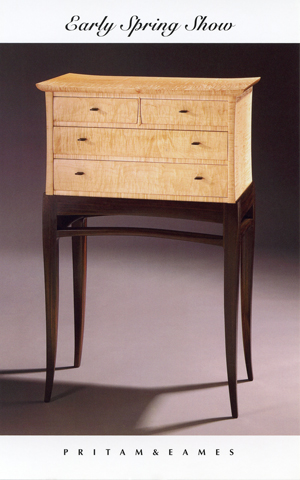
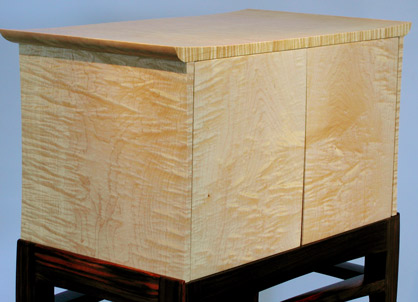
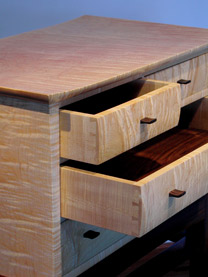
Curly sugar maple, East Indian rosewood, quarter-sawn white oak, walnut, Brazilian rosewood.
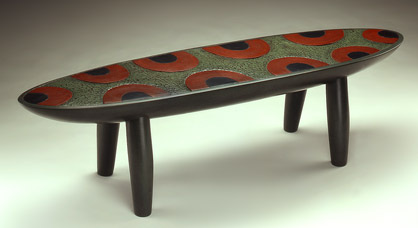
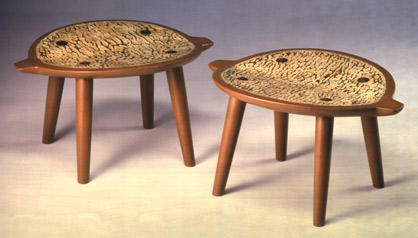
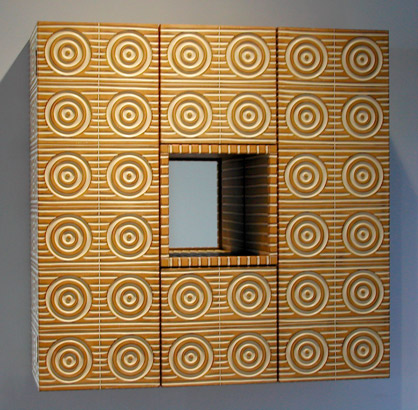
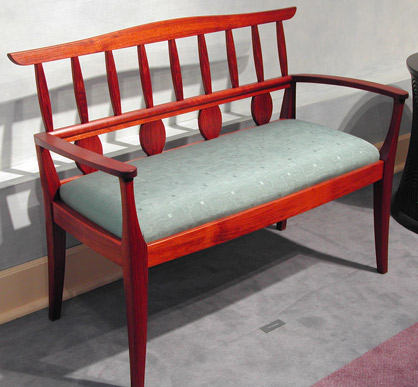
A dainty settee in Jatoba by Tim Coleman is made comfortable by an upholstered seat. Coleman worked first in the shop of William Walker in Seattle before traveling south to study with Krenov at the College of the Redwoods in the 1980s. His work has appeared in the gallery since that time.
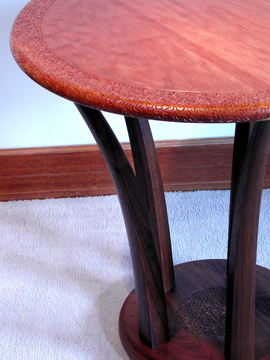
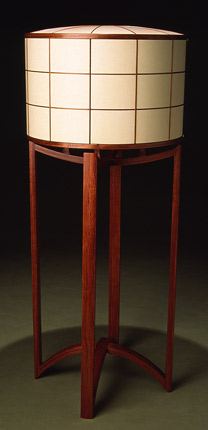
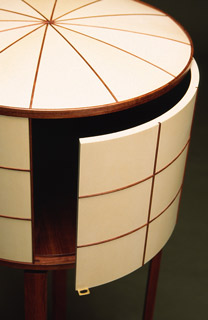
Two other Krenov-trained furniture makers contributed work to this show: Jefferson Shallenberger and Greg Smith. The round white cabinet-on-stand by Shallenberger reflects earlier work by other Krenov students: Zivko Radenkov and Tim Morrow.
The low table by Greg Smith is a decidedly friendly design in doussie that evidences his usual elegant restraint, such as the delicately bowed lower stretcher.
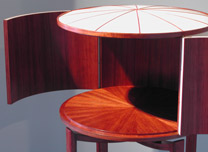
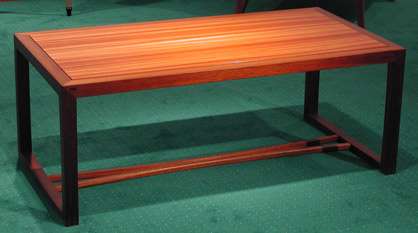
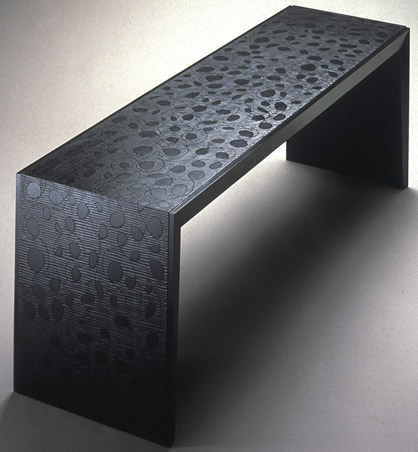
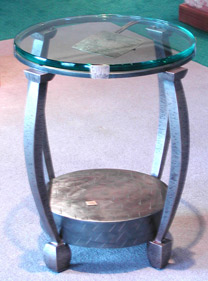
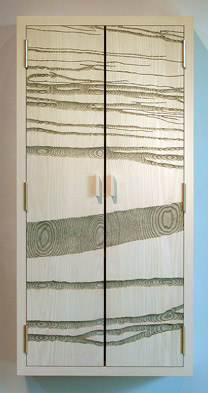
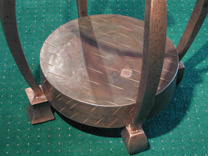
DUNCAN W. GOWDY: Ash, quarter-sawn white oak, stain, paint.
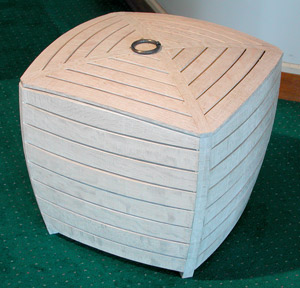
The clothes hamper in ash was the first piece from Don Miller exhibited at the gallery. Both the sun-bleached tone and the intentionally natural texture of the surface offers another approach to bringing the exterior inside. Both the exterior staving, as well as interior framing, have a minimal mass to them. This kind of thinking reflects Miller's background in musical instrument making as well as high end interior built-in cabinetry. Miller would go on to contribute a series of designs that retained this light, airy quality.
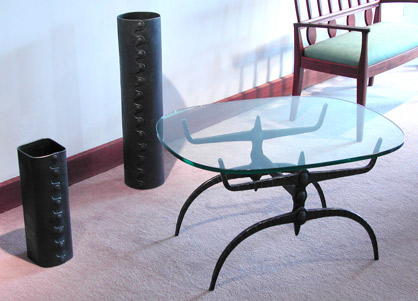
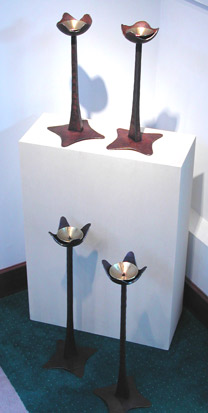
Medium Rolled Square Vessel: Forged steel.
Tall Meandering Line Vessel: Forged steel.
Table: Forged steel, glass.
Forged steel.
MATERIAL WORTH:
The Celebrated Object
2005
Furniture: David Ebner, Hank Gilpin, Michael Hurwitz, Thomas Hucker, James Krenov, Judy Kensley McKie, Tom Odell,
Jere Osgood
Jewelry: Ellen Baumritter, Jacqueline Myers, Tom Odell, Joan Parcher, Eleni Prieston, Robin Quigley, Michel Royston, Barbara Seidenath,
Leonard Urso
Glass: Sam Stang, Tom Stoenner
Ceramics: James Makins, Hiroshi Nakayama, Ikuzi Teraki & Jeanne Bisson (Romulus Craft)
Lacquerware: Yuji Kubo
Metal: Tom Odell, Leonard Urso, David Zatz
NOTES: Michael Hurwitz's tall table combined its unusual proportions (36" x 36" x 36") with several exciting features. Hurwitz, a former student of Osgood’s, makes the connection to his teacher in this Tall Table made of narra, padauk, and wenge. The two-tiered laminated stretcher system gives the piece an elegantly arched form that is capped by an inspired use of color in the surface parquetry or basket-weave pattern. The arching stretcher system is trademark Hurwitz. Note how simply the outer edges of the legs branch off into small arching stretchers that attach to the top at the apron. First, the visually stunning basket-weave illusion of the top created by marquetry using the different tonality of various woods. Its two main arching stretchers intersect their diagonal paths to crate a strong foundation as well as the visual enjoyment of their tapered tension. The tapered lamination is a clue to Hurwitz's background training with Jere Osgood at the program in Artisanry at Boston University in the 1980s.
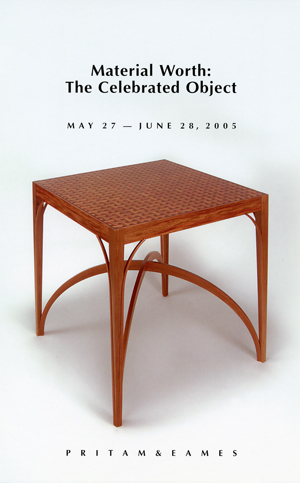
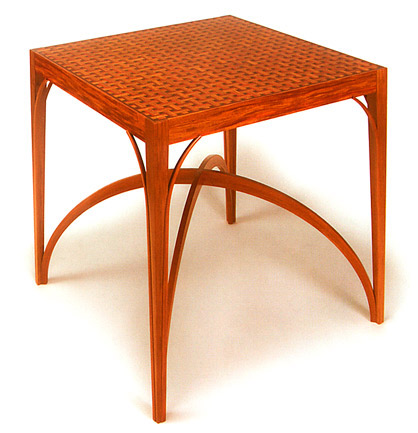
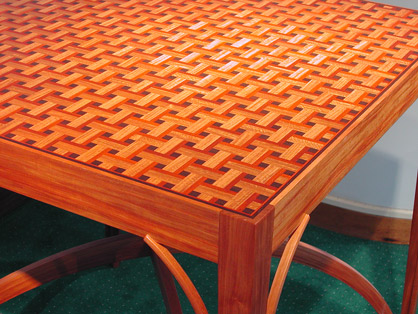
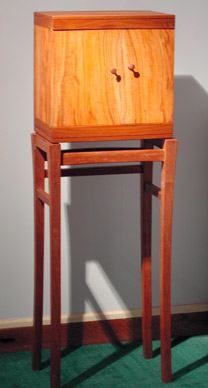
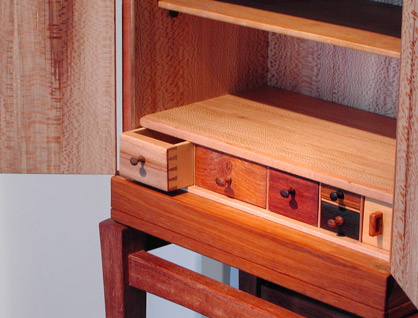
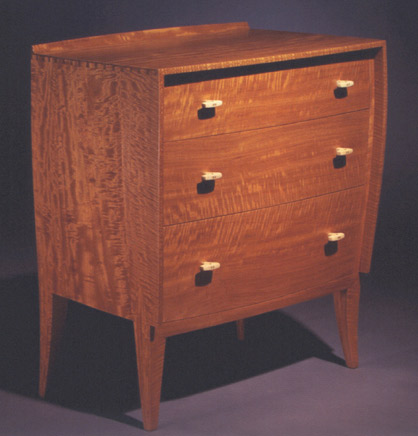
The teak and Appalachian cherry cabinet from the legendary James Krenov, now 84 years old, demonstrates that the old master can still cut dovetails by hand with more skill than many. This cabinet was the last one the gallery received from Krenov.
Jere Osgood’s fiddleback mahogany and European hornbeam chest of drawers proves once again his consummate mastery of the curved furniture form.
ebony, white oak, Lebanon cedar.
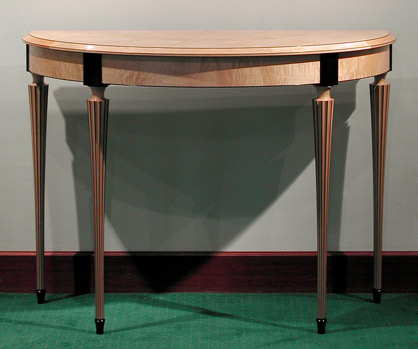
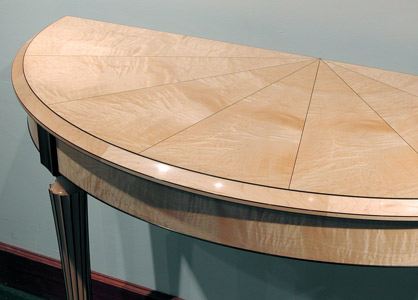
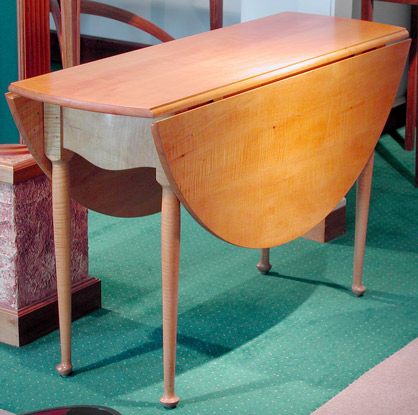
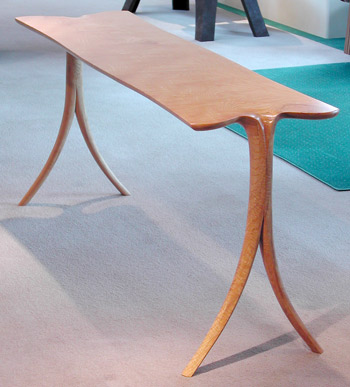
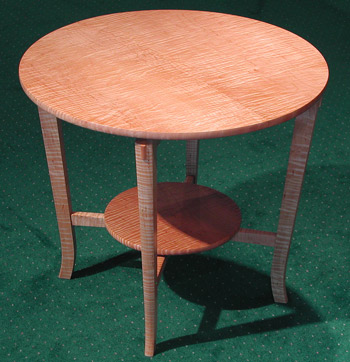
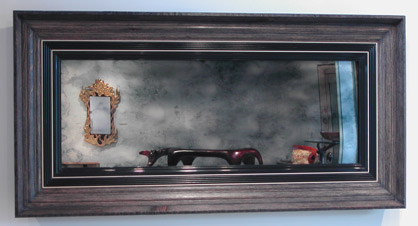
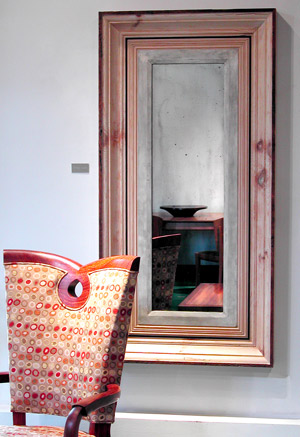
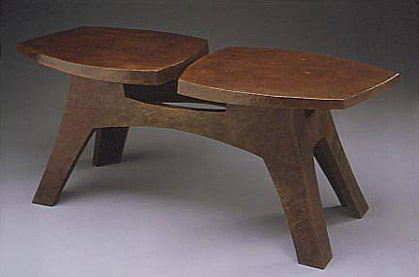
Still Lives by IKUZI TERAKI & JEANNE BISSON (Romulus Craft) - 2005
NOTES: Over the years Romulus Craft, the ceramic studio of Jeanne Bisson and Ikuzi Teraki provided the gallery with beautiful, functional porcelain work. In this series of still life settings, the Romulus partners created compositions of individual functional porcelain elements to represent Water, Earth, and Fire.
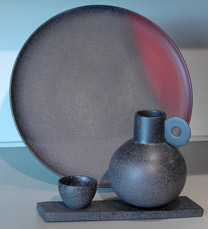
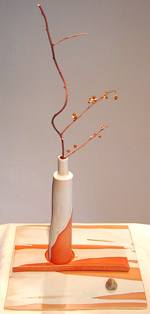
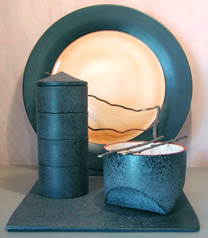
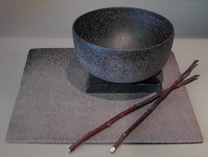
Furniture by DAVID EBNER
2005
Featuring New Work in Bamboo
NOTES: David Ebner was among the first of the studio furniture makers to use bamboo as a material of choice in his furniture.
Some of his trademark pieces also appeared in this show, such as his Lingerie Chest and a bronze version of his Bench and Renwick Stool.
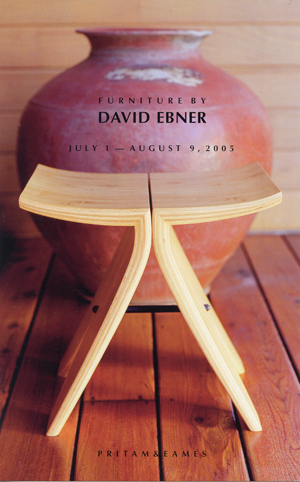
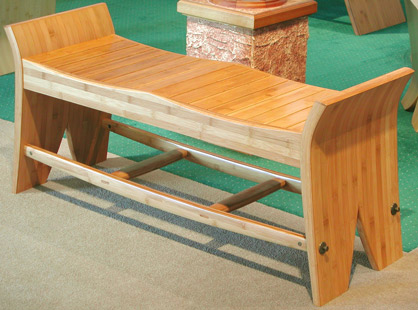
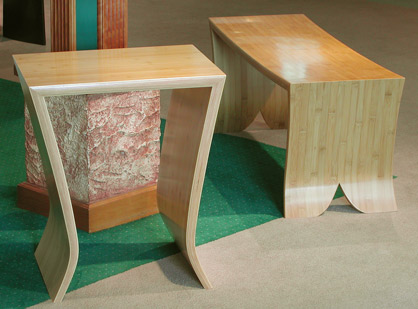
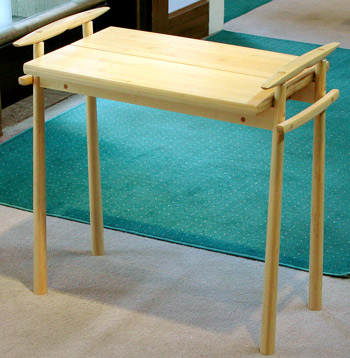
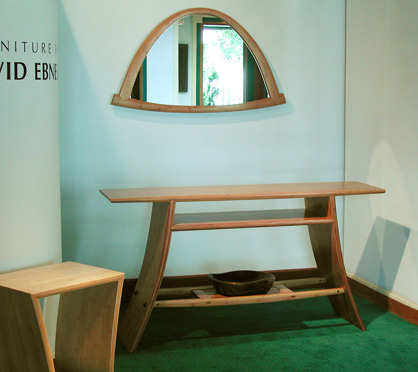
Side Table: Bamboo.
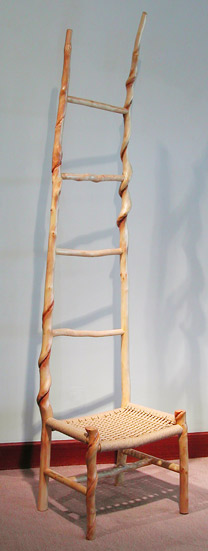
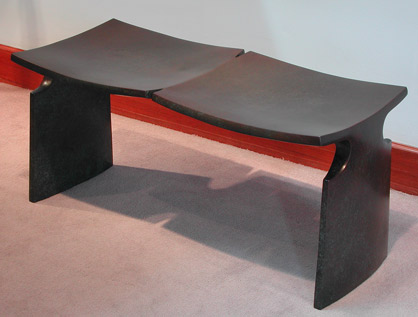
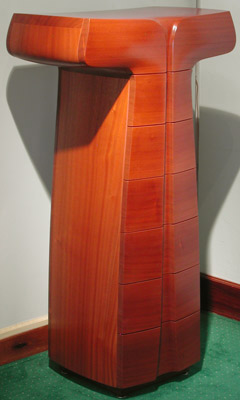
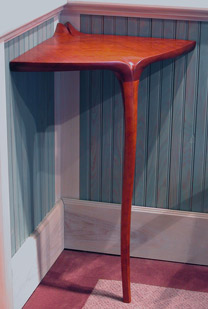
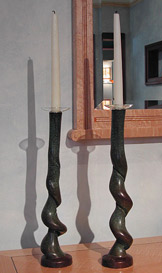
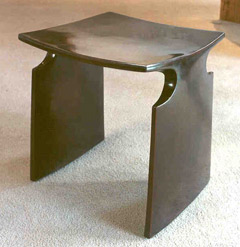
Men in Kimonos
Series by
WENDY MARUYAMA - 2005
Wall-hung Cabinets with Ultrachrome Digital Collages
NOTES: Wendy Maruyama and James Schriber met as students at Boston University’s Program in Artisanry in the mid-1970s, and have remained close friends ever since. Their mature work, however, reflects the divergent paths these two influential makers took since leaving school.
Maruyama has taught throughout her career, and is currently professor of furniture design and woodworking at San Diego State University, where she was recently named the outstanding teacher in the arts. Although Schriber has guest lectured at schools, he considers himself a furniture maker, first and foremost, and has maintained his furniture making shop in western Connecticut since the 1970s.
Maruyama’s Men in Kimonos, is a series of wall-hung cabinets that embrace large format ultrachrome digital prints based on her collection of 1940’s black and white photos of Kabuki actors. She acquired these photos on trips to Tokyo flea markets. At first, she thought they were geisha until she noticed the size of some of the subjects’ feet and, in some photos, an Adam’s apple. It was then that she realized these were stage photos of Kabuki theatre performers, or onnogata -- men in drag. This work allowed her to work in a new digital medium, and still use a furniture form to embrace the prints.
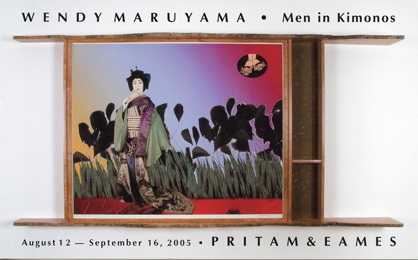
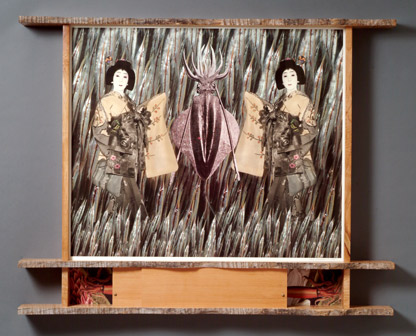
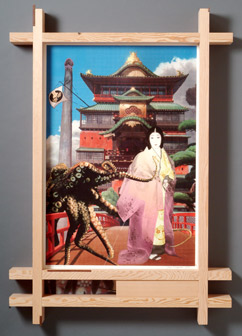
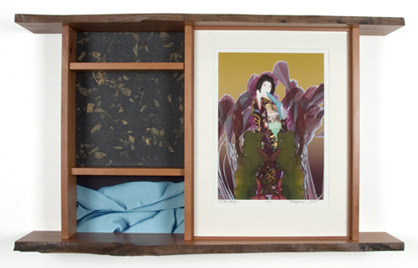
Pearwood, Ultrachrome digital collage, handmade paper.
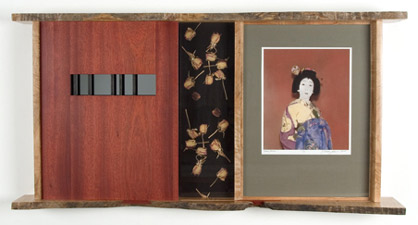
coconut palm, Ultrachrome digital collage, mirror.
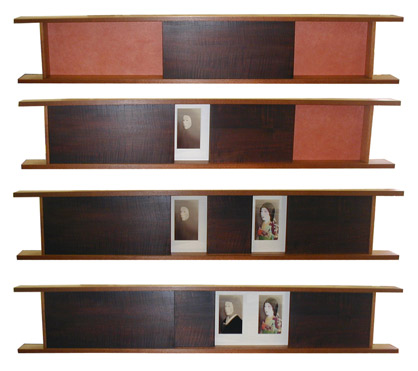
Ultrachrome digital collage.

Ultrachrome digital collage.
Furniture - 2005
NOTES: James Schriber belongs to a group of furniture makers whose work has been exhibited at Pritam & Eames since its opening in 1981. In fact, Schriber designed and installed the entrance door to the gallery. He demonstrated then an ability that continues to underline his furniture making today: that is, to create distinctive furniture designs that integrate seamlessly into existing situations. This ability was honed in Schriber’s early work with a group of young architects in Vermont, developed further with training under Jere Osgood and Alphonse Mattia at Boston University’s PIA program, and put to practical use in his partnership with an architect and builder in a design and construction shop, called Full House, established first in Vermont, and then in Connecticut. His understanding of the structural as well as aesthetic properties of residential interiors makes him an ideal choice in almost any commission situation. Another important attribute is Schiber's facility to work with a range of materials, many of them man-made, 21st-century, materials. A third strength was probably formed as a result of being around his father’s and uncles’ sheet fabrication business in Dayton, Ohio, where he grew up. There, he witnessed work that required a high degree of collaboration among the men in the shop. Collaborating with other professionals is another Schriber strength, and these abilities, combined with a superior design sense, give him an edge in working on commissioned projects.
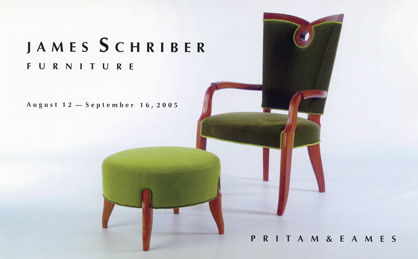
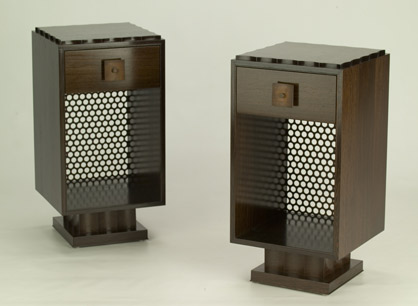
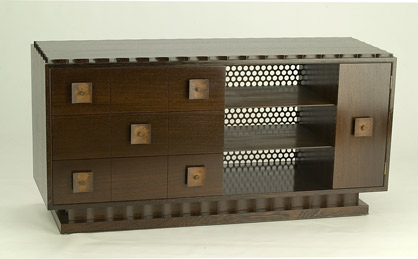
The two wenge side cabinets, along with the console, can be seen as a cabinet suite. The use of a dark toned manufactured steel grill work perforated in a honeycomb pattern, as well as the organically patinaed, shield-shaped pulls, are combined sympathetically with a deep grained, dark brown wenge wood material. The pulls were sufficiently ample in scale and useful in shape that they could be used for both doors and drawers of the cabinets. The scalloped edges of the cabinets’ tops, as well as the scalloped motif of the pedestals’ bases, give these pieces a fine furniture reference. This reference, combined with the more primal qualities of the materials, give these pieces a nice duality.
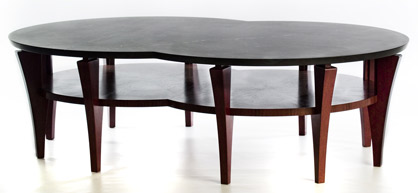
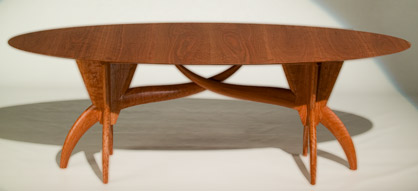
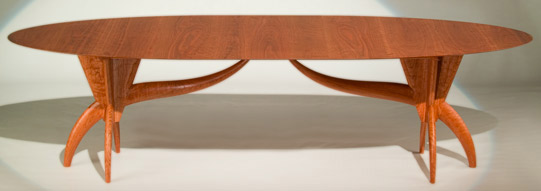
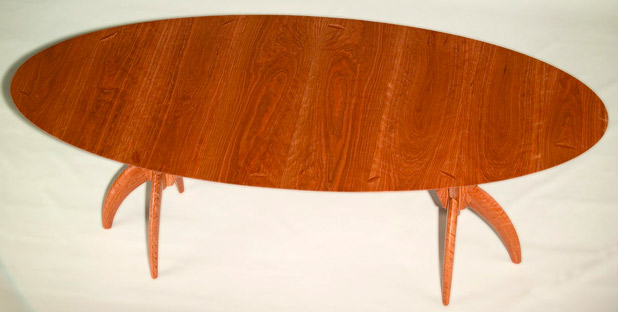
There is integrity in the continuity of the curves that he used throughout the design. Seen closed, the top is a true oval form, and this is the table’s best form. He has created a dual pedestal foundation for the table. These pedestals pull out with the ends as the top extends for the inclusion of its leaves. The unusual design of the pedestals has the end legs appear to go through the pedestal and extend into a reverse curve supporting stretcher that creates the necessary support for the mid-section. In this table, he has created an unusual extension design, as well as one that is aesthetically pleasing.
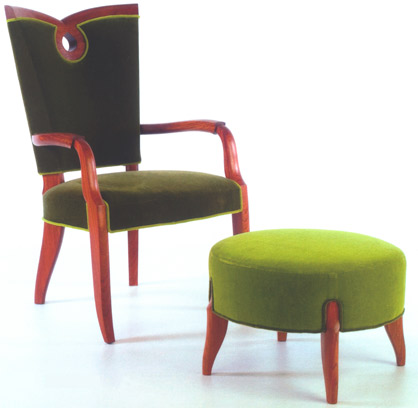
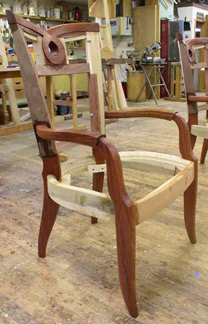
The other design feature to be mentioned was the handing of the junction of the arm and the vertical extension of the front legs. The arms rests themselves need more width and, rather than tapering to the point of transition to the leg, Schriber ends this dimension as if with an over sleeve. This abrupt shape change serves to hide the joint with the vertical element of the front leg. The transition becomes aesthetically pleasing, functional, as well as adding to body comfort.
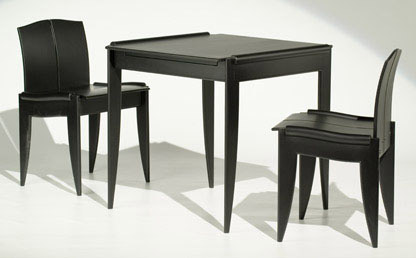
KRISTINA MADSEN
Furniture - 2005-2006
NOTES: Two artisans, also good friends, Kristina Madsen and Rick Wrigley, had concurrent exhibits of new work that celebrated the 50th birthdays of both makers, and the 30 years of furniture making experience each one of them represents.
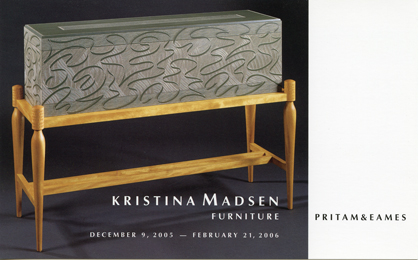
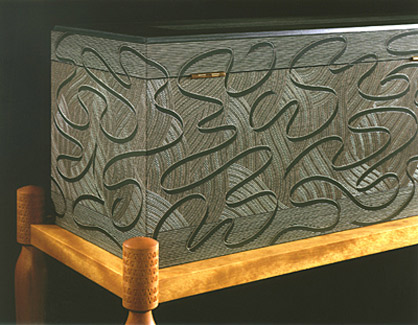
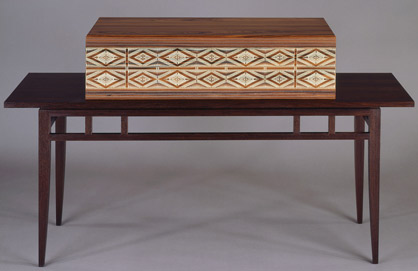
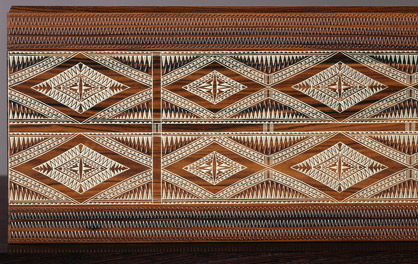
RICK WRIGLEY
New Wall Cabinets
2005-2006
NOTES: For his Pritam & Eames show, Wrigley made a group of wall-hung cabinets, called the Atomic Series, whose door panels provide a canvas for his marquetry. As in the well-known high-Renaissance marquetry cameras, Wrigley’s compositions create magical, three-dimensional illusions.
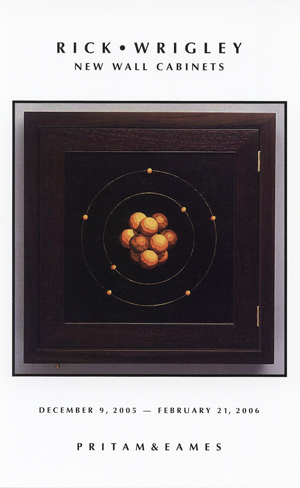
22K gold leaf, oil pigments, brass.
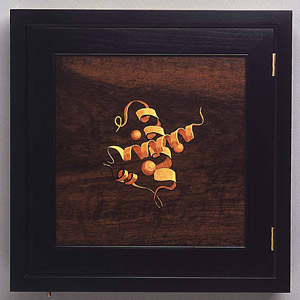
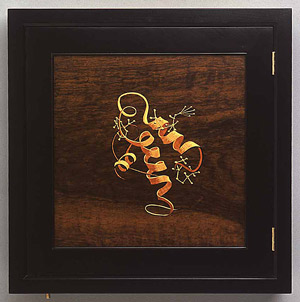
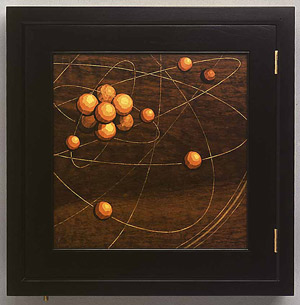
22K gold leaf, oil pigments, brass.
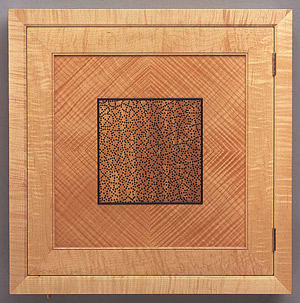
22K gold leaf, brass.
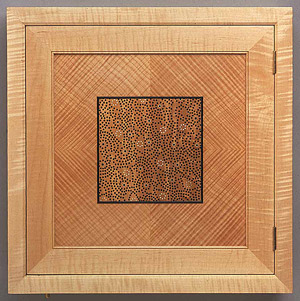
22K gold leaf, brass.
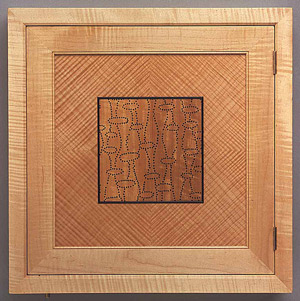
22K gold leaf, brass.
EARLY SPRING SHOW 2006
Tim Coleman, Michael Cullen, Christine Enos, Tony Kenway, Gary S. Magakis, Don Miller, Greg Smith
NOTES: This Early Spring Show at PRITAM & EAMES ushered in the gallery’s 25th year and featured a pair of drum stools/tables by Greg Smith; a pair of Flower Chairs by Christine Enos; a rocker of quilted Tasmanian blackwood by Australian furniture maker Tony Kenway; a steel and bronze side table by Gary Magakis; and Tim Coleman’s Fall Front Desk in Japanese ash, walnut, imbuya, and sassafras.
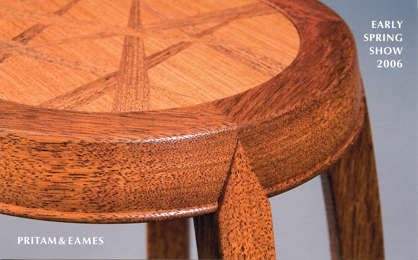
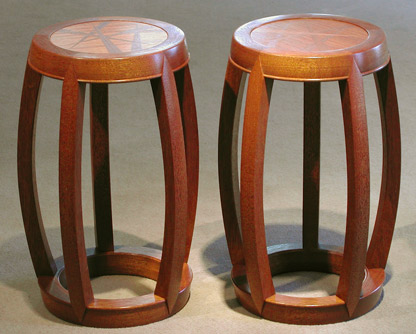
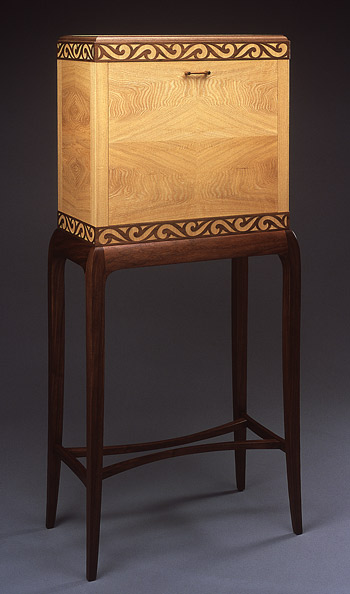
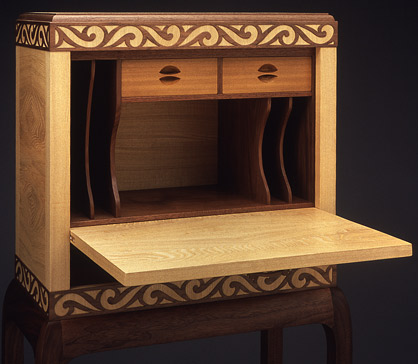
Japanese ash, walnut, imbuya, sassafras.
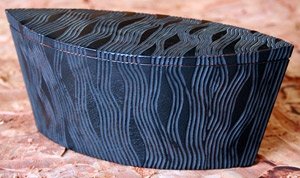
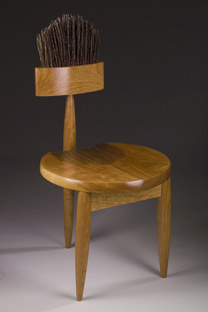
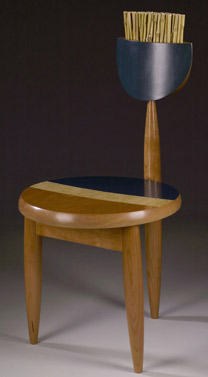
Cherry, birch stick, paint.
Cherry, bamboo, paint, paper.
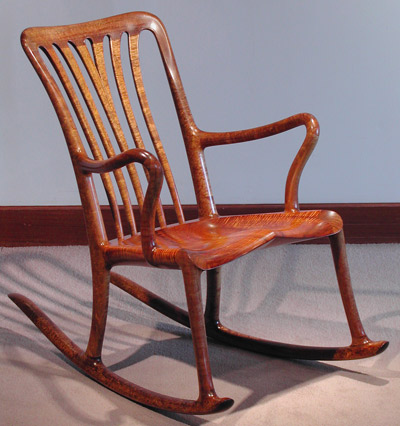
Quilted Tasmanian blackwood (Acacia Melanoxyln).
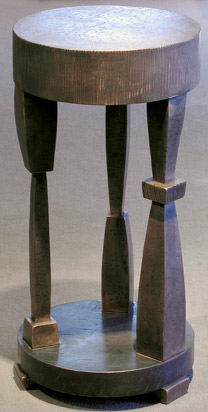
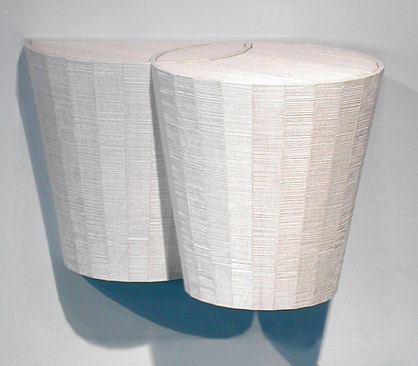
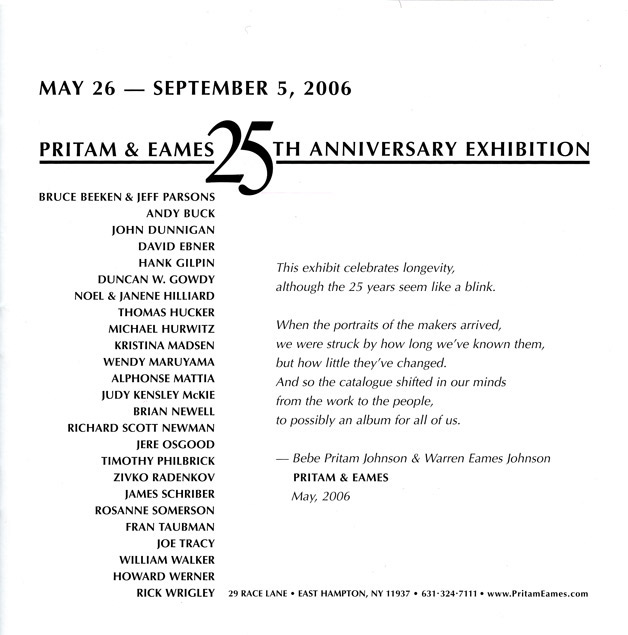
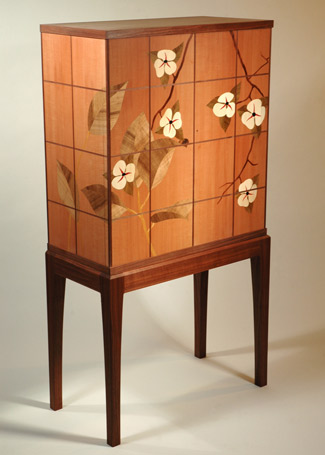
European pearwood, walnut, rosewood, myrtle, holly, ebony, lignum vitae, satinwood.
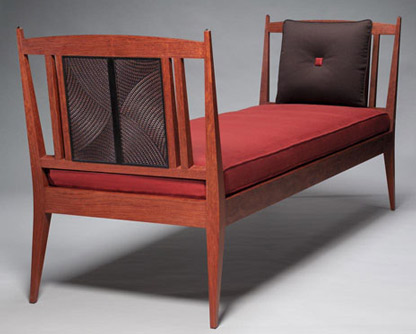
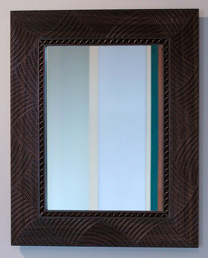
Indonesian rosewood.
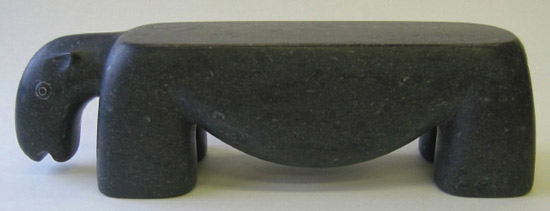
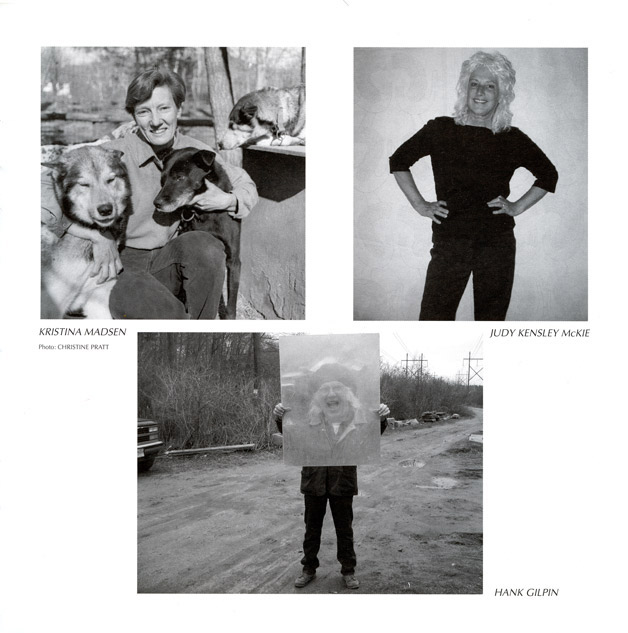
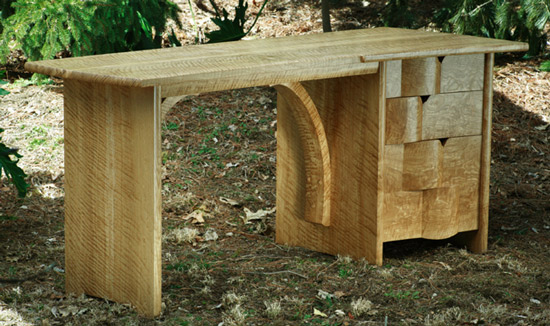
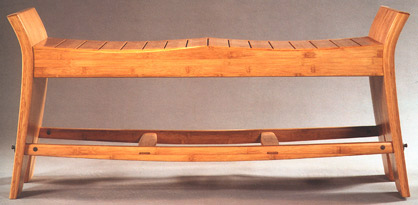
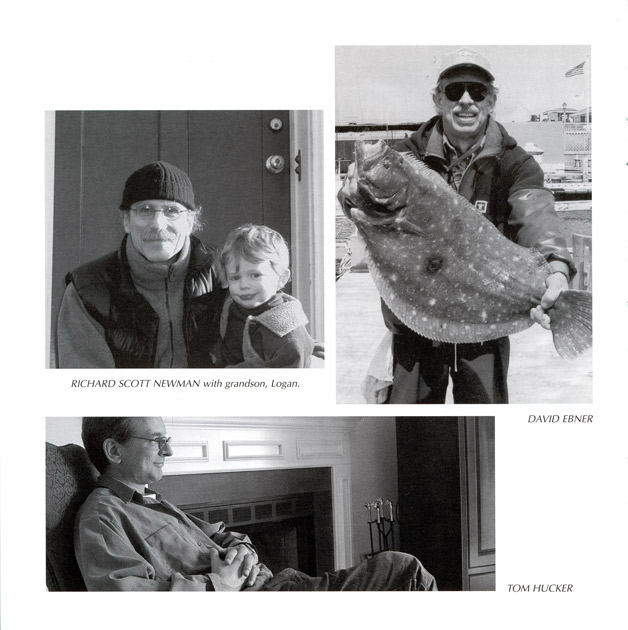
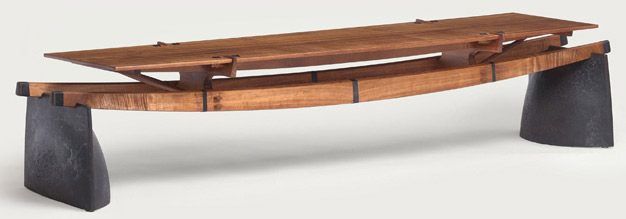
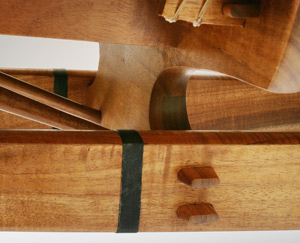
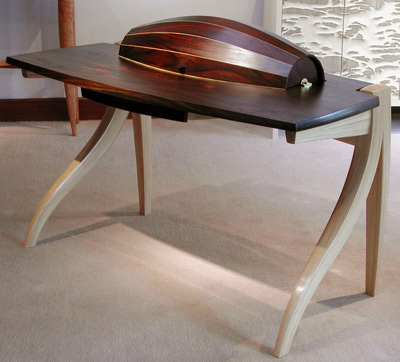
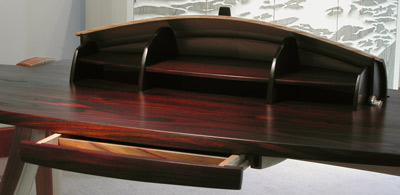
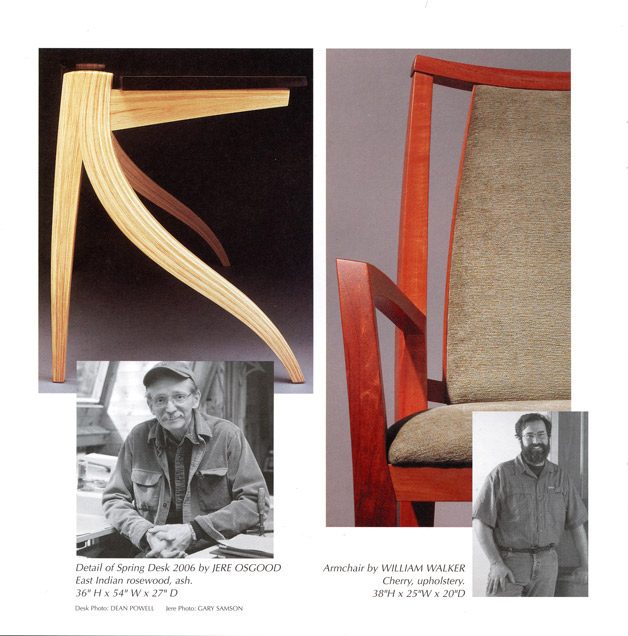
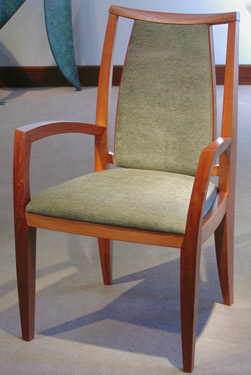
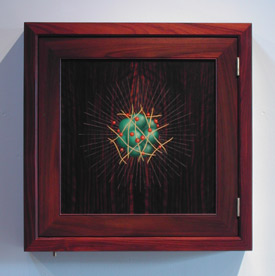
Indonesian rosewood, Macassar ebony, maple, oil pigments, 22K gold leaf, brass.
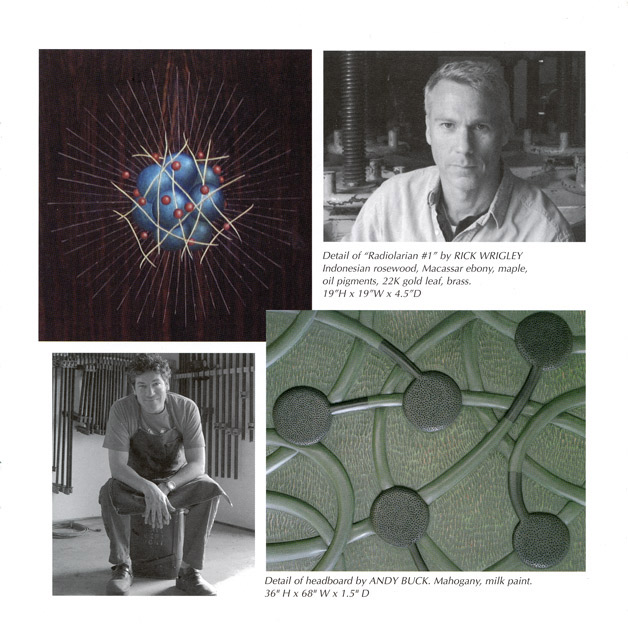
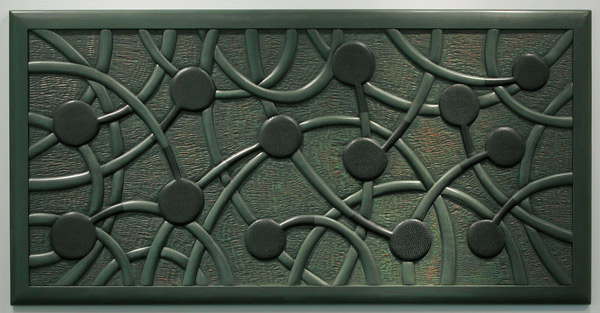
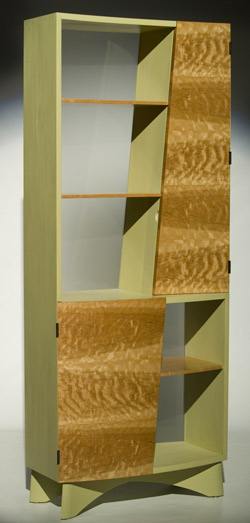
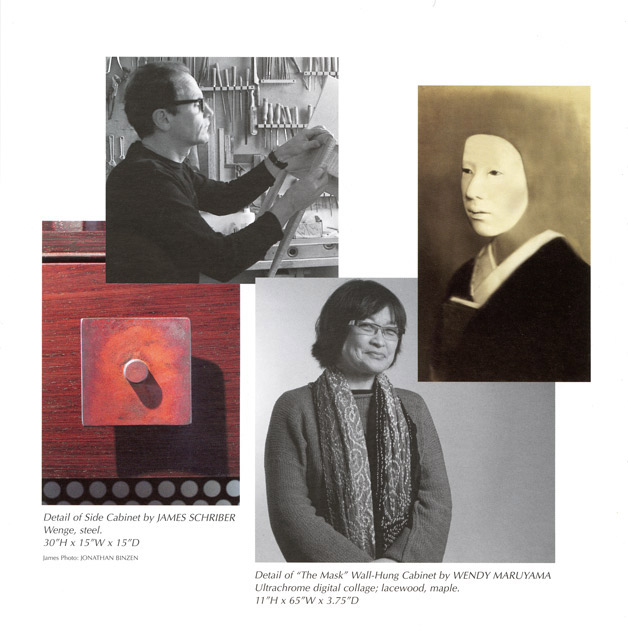
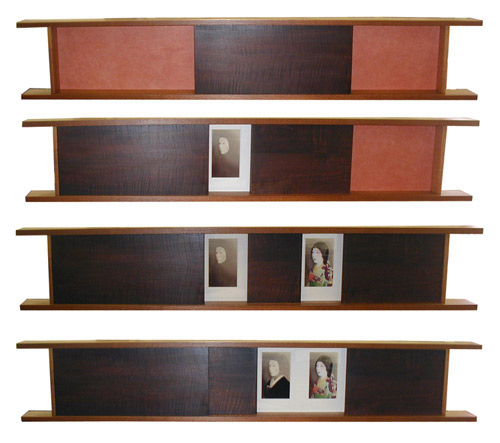
Lacewood, Curly Maple, Ultrachrome Digital Collage.
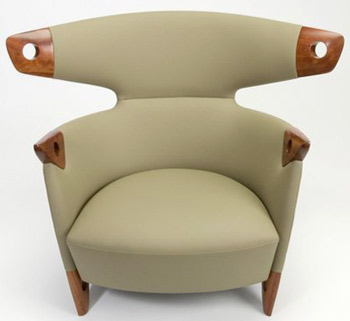
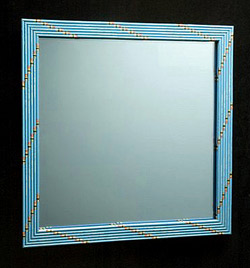

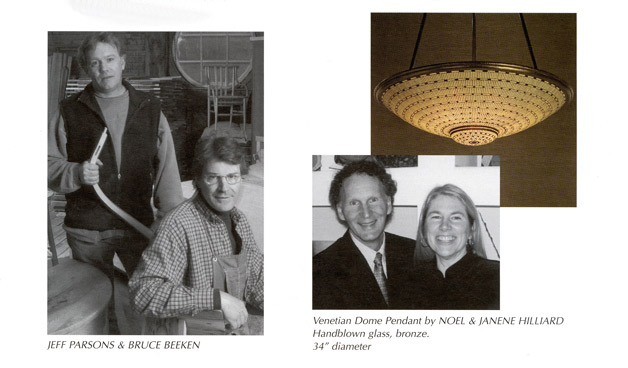
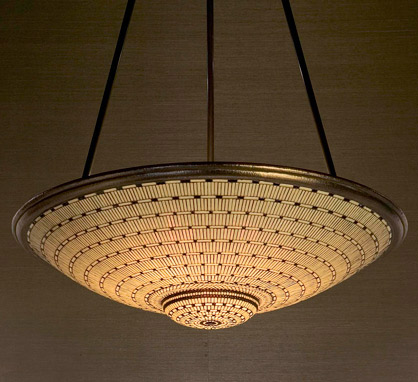
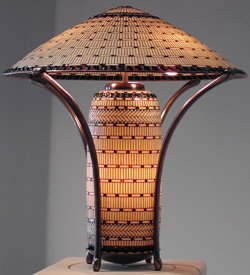
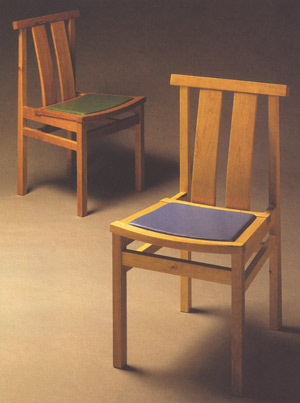
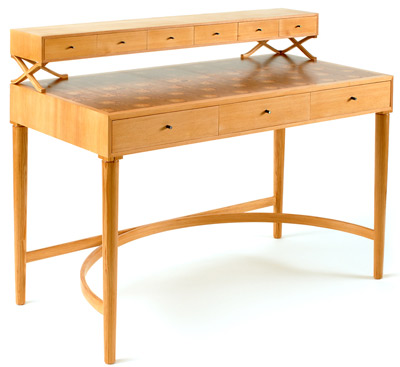
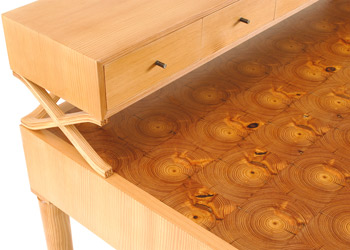
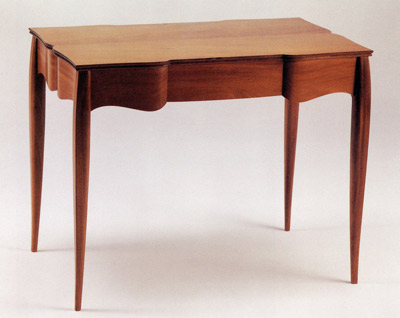
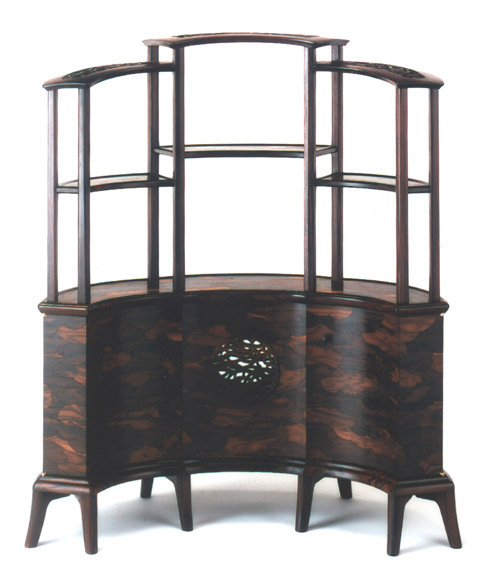
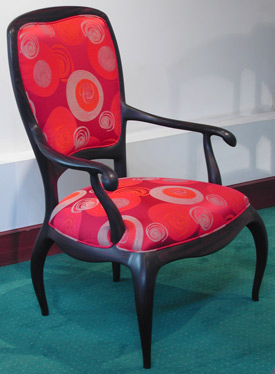
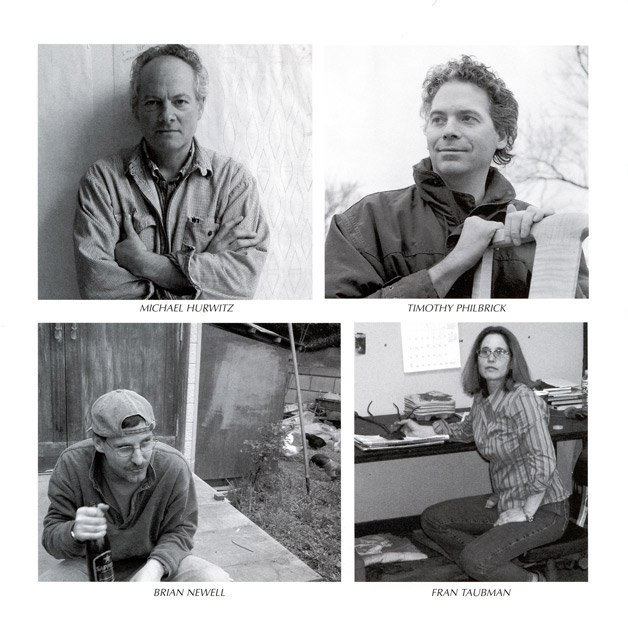
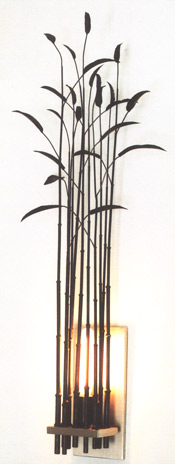
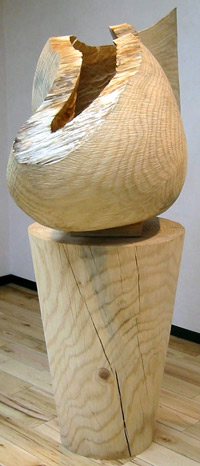
Nickel-plated bronze, bronze.
Aleppo pine.
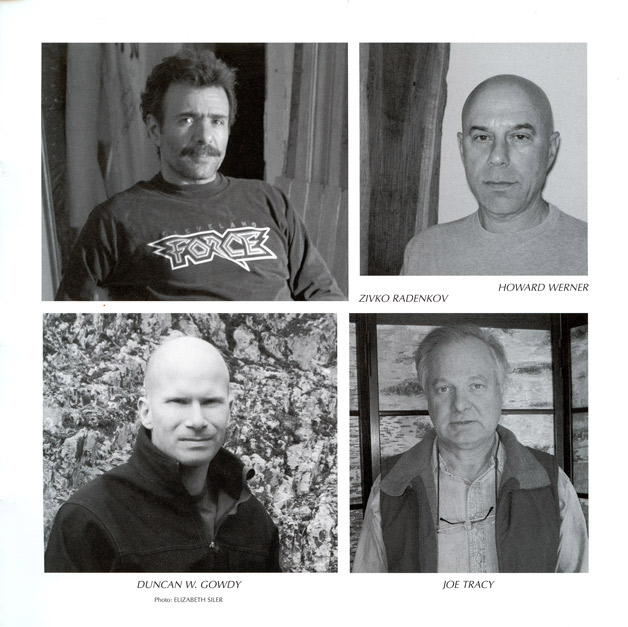
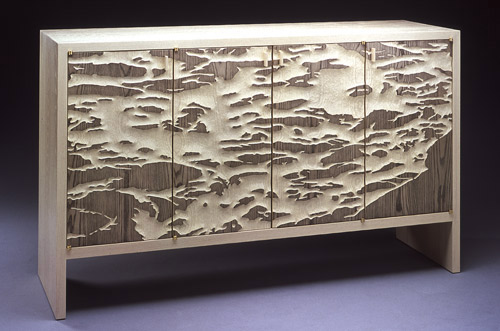
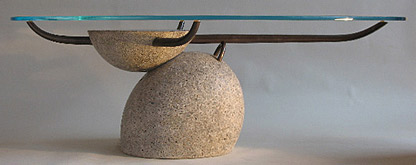
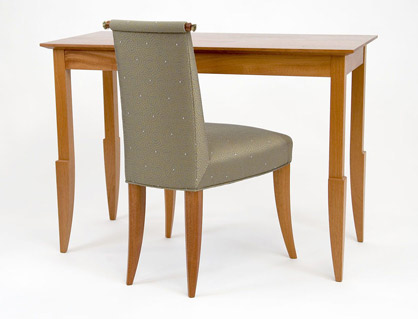
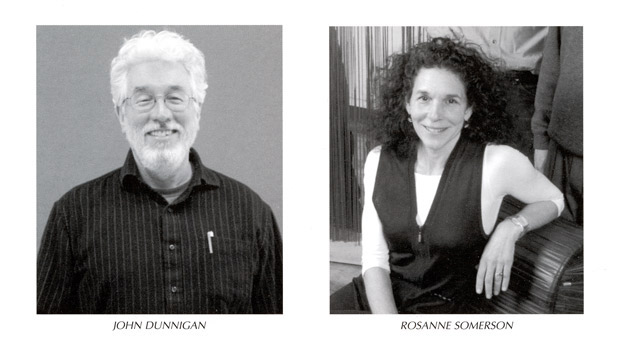
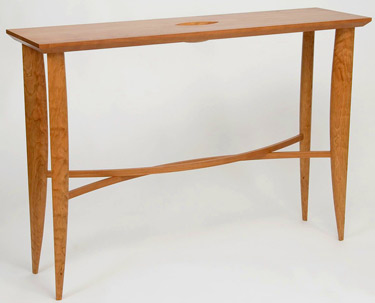
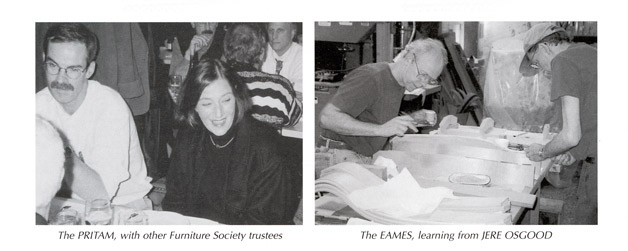
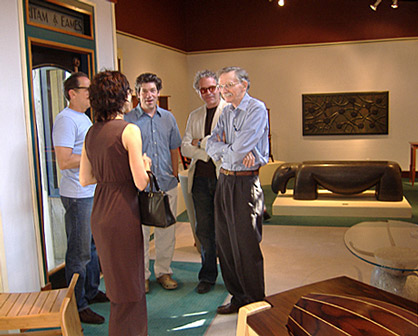
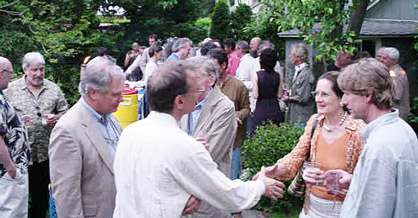
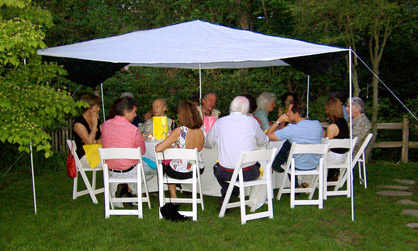
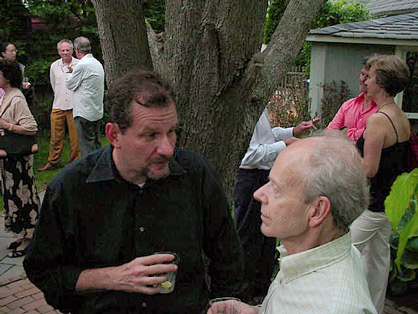
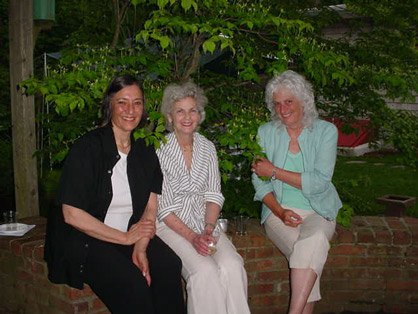
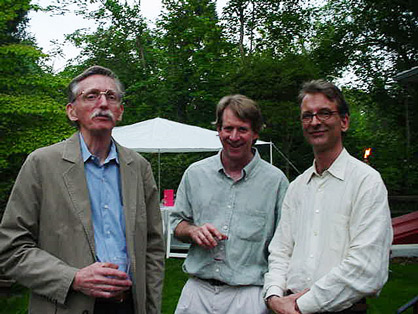
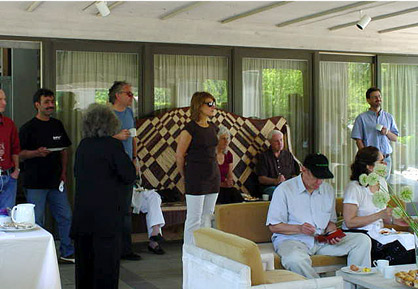
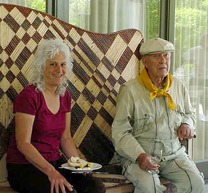
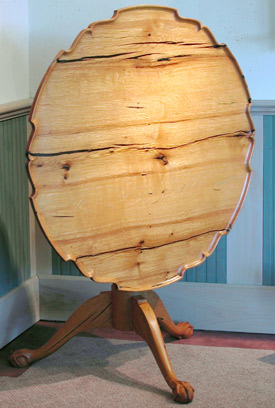
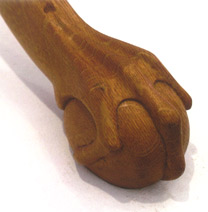
29.5"/50.5"H x 38"diameter
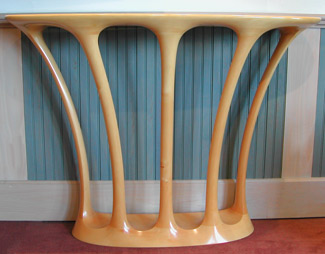
35.5"H x 47.5"W x 12"D
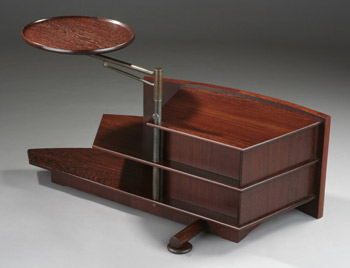
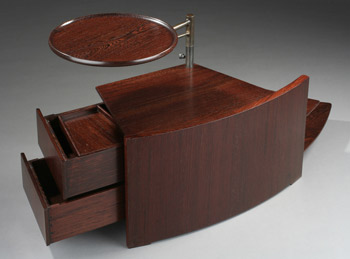
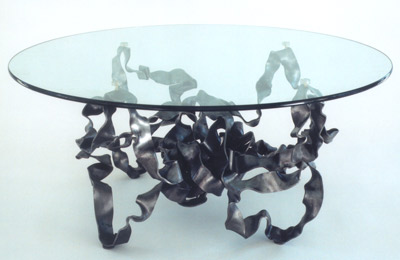
18 ”H x 49”diameter
2007 EARLY SPRING SHOW
James Bacigalupi,John Eric Byers, Tim Coleman, Michael Cullen, David Ebner, Ashley Eriksmoen, David Finck, Julie Godfrey, Duncan W. Gowdy, Gary S. Magakis, Rachel & Timothy Miller, Greg Smith, Rich Tannen
NOTES: Pritam & Eames begins its 26th year with the opening of its Early Spring Show on March 23 through May 22. The exhibit introduces the work of nine furniture makers whose furniture styles range from the bravura computer assisted craftsmanship of Rich Tannen’s white oak cupboard to Ashley J. Eriksmoen’s delightful, upholstered furniture creatures, Adeline and Pablo. Rich Tannen is chair of the School for American Crafts at the Rochester Institute of Technology, NY, and Ashley Eriksmoen received her training in furniture at the Rhode Island School of Design, Providence, RI and the College of the Redwoods, Ft.Bragg, CA.
Others in the show include Arizona lamp maker James Bacigalupi III; Californians Michael Cullen and Greg Smith; David Finck of North Carolina; Duncan Gowdy of New Hampshire; Massachusetts furniture makers Julie Godfrey and Tim Coleman; and the Philadelphia metalworker, Gary Magakis. From Long Island, there was the work of furniture maker David Ebner, and a sister and brother blacksmithing team from the south shore, Rachel and Timothy Miller.
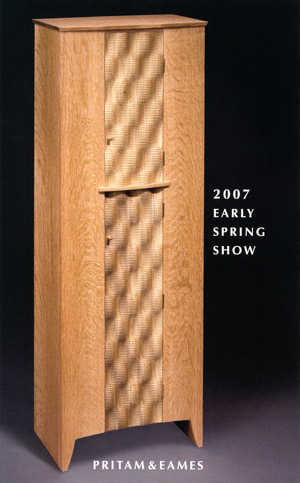
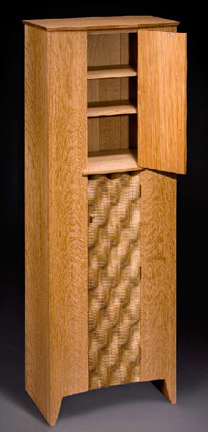
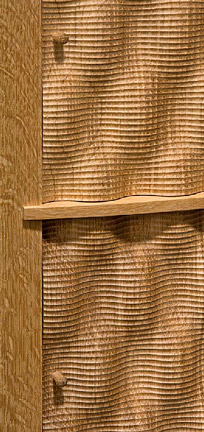
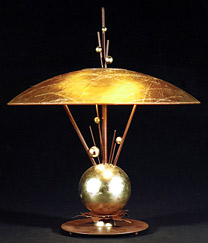
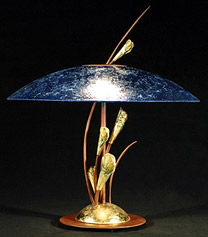
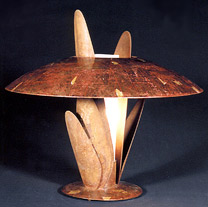
Patinated steel, paint, glass, gold & copper leaf.
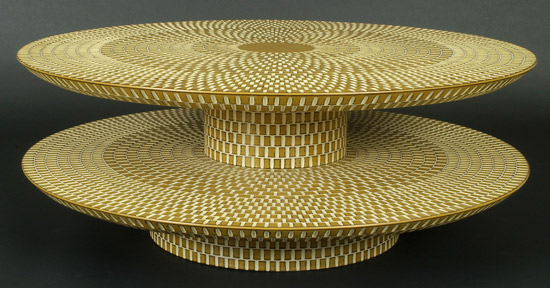
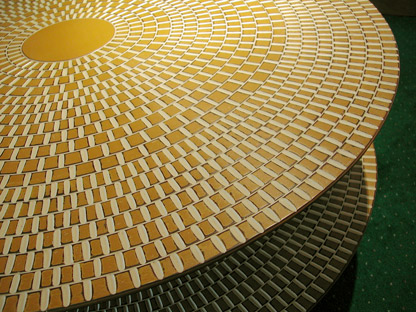
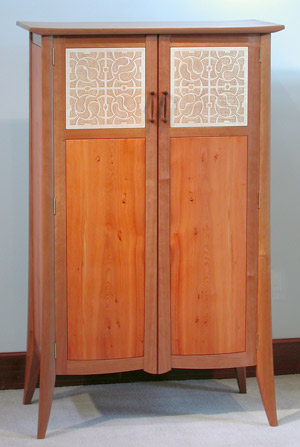
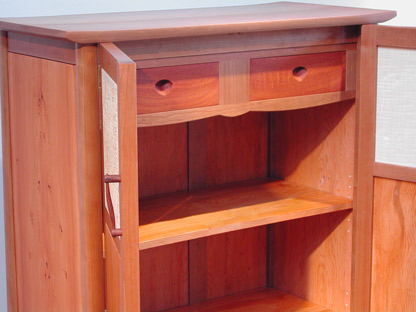
Cherry, western yew, English sycamore, morado, Argentine rose cedar.
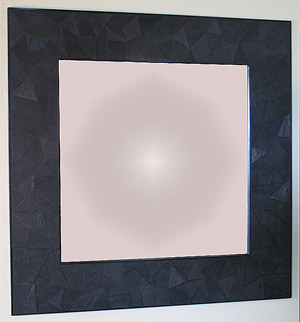
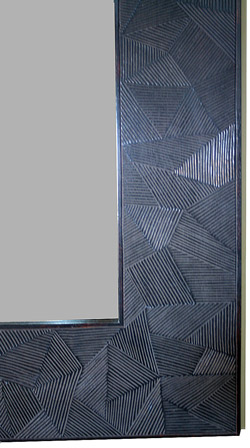
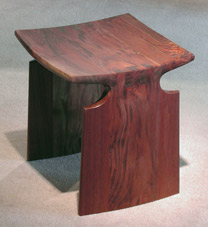
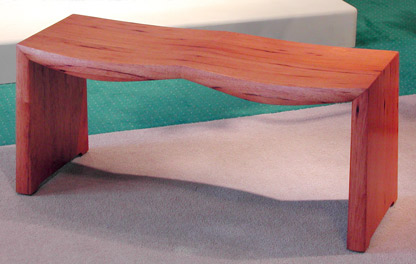
Claro walnut.
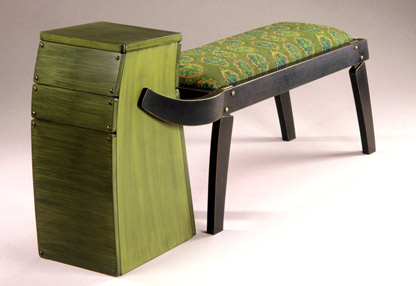
Mahogany, original Jaquard fabric, milk paint.
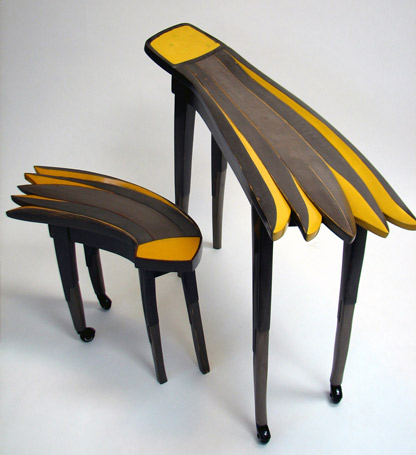
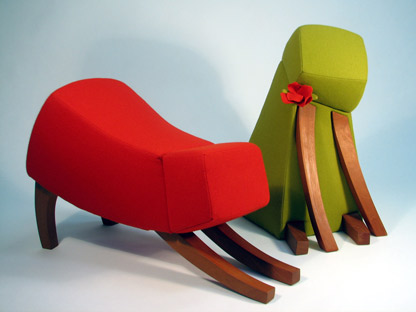
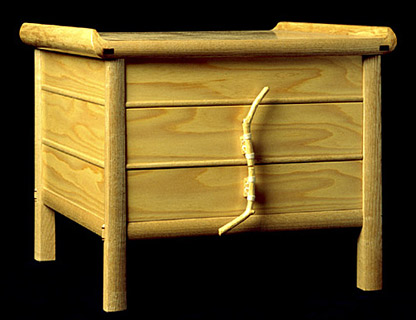
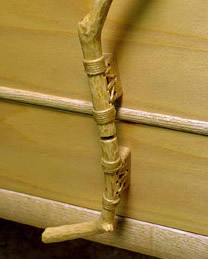
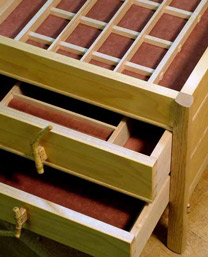
Port Orford cedar, European olive ash, hawthorne twig handle.
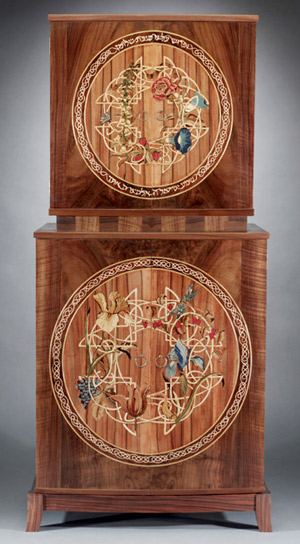
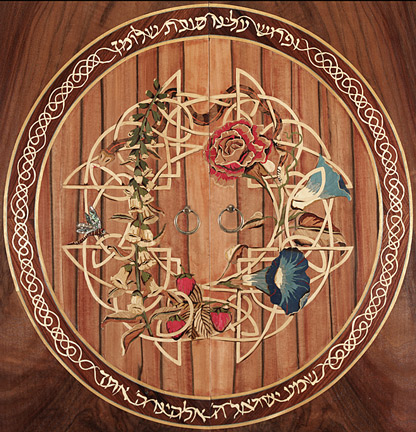
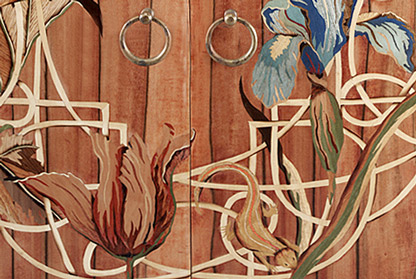
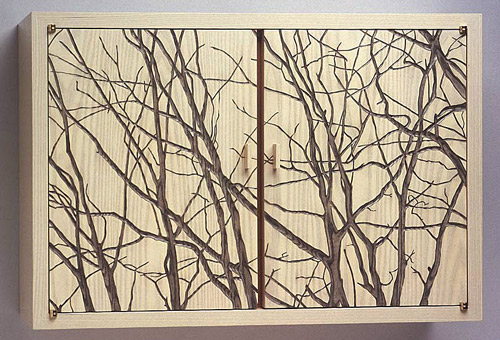
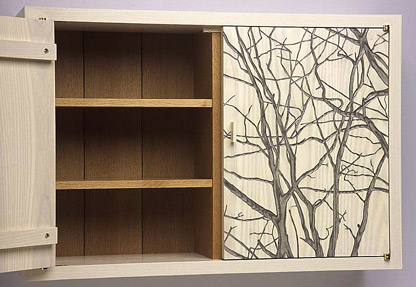
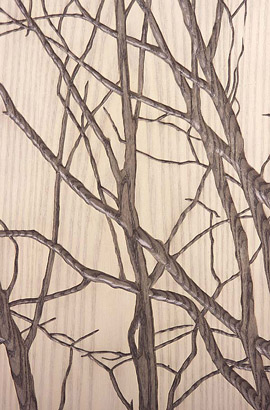
DUNCAN W. GOWDY:
Ash, quarter-sawn white oak, stain.
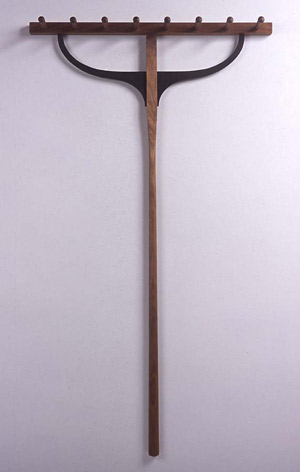
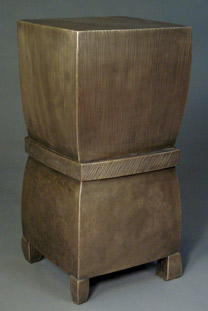
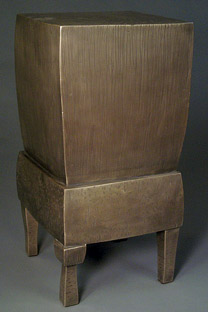
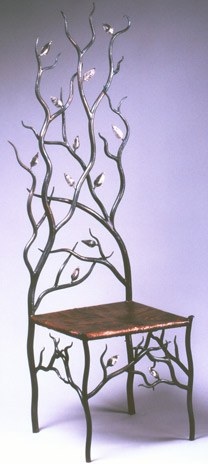
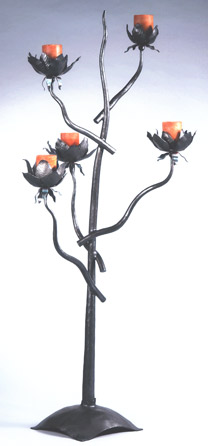
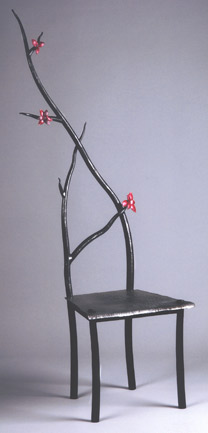
by RACHEL & TIMOTHY MILLER:
Hand forged steel.
heat patinaed copper.
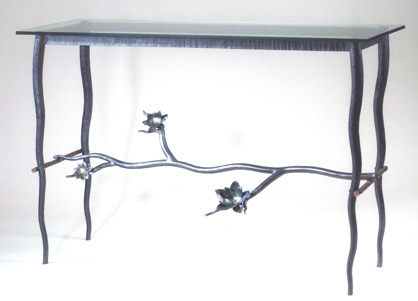
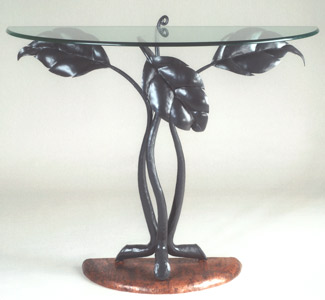
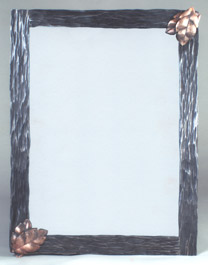
Hand forged steel, copper.
by RACHEL & TIMOTHY MILLER:
Hand forged stainless steel, bronze.
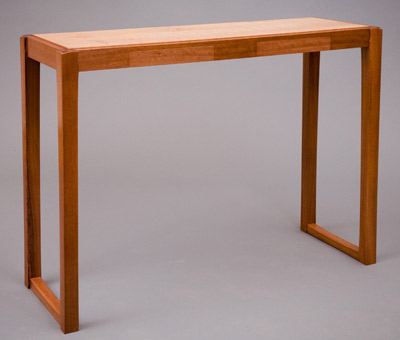
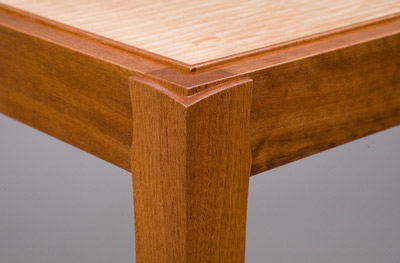
THE HONOR OF USE
PowerPoint Presentation by
Bebe Pritam Johnson
at the Furniture Society conference in Victoria, BC, Canada, June 2007
In June 2007, Bebe Pritam Johnson gave a talk entitled "The Honor of Use" at the Furniture Society conference in Victoria, BC. These thoughts have been the gallery's guiding philosophy about furniture, the home, and the beauty of utility since its opening in 1981. (see After Word)
A North Carolina Tradition: Functional Wood Fired Pottery
COMMON GROUND
A North Carolina Tradition:
Functional Wood Fired Pottery
JULY 27 -- SEPTEMBER 18, 2007
New Work by
JOSH COPUS, KIM ELLINGTON, DANIEL JOHNSTON,
FRED JOHNSTON, MATT JONES,
BEN OWEN III
NOTES: This show celebrates a practice “that traces an unbroken chain of potters from the
present time all the way back to the 18th century,” says Matt Jones, one of the exhibitors.
“The pottery pride we feel in this state is in no small way connected to
our admiration for the excellence of our pottery predecessors.”
"This collection of functional pots is made from clay found no further than the potter’s backyard,” says Bebe Johnson, gallery partner. “The clay in these pots comes from the alluvial deposits found only in the rich soil regions of North Carolina. I came across this work last year when I gave a lecture at the Penland School of Craft in western North Carolina. My host, Andrew Glasgow, executive director of The Furniture Society, himself a connoisseur of pots from this region, introduced me to this work. Ever since, I have been thinking of ways to bring these marvelous pots to our East End audience.”
Mr. Glasgow selected the potters for this exhibit.
Because of the public’s continuing esteem for their work, the North Carolina potters have been able to carry on this craft tradition for generation after generation. For example, Ben Owen III learned his craft from his grandfather. Owen III recalls many shared hours with his teacher, hours that provided not only a strong foundation upon which to build his own pottery skills, but a repository for precious memories of working beside his grandfather.
“The concept that captivated me about North Carolina’s Catawba Valley tradition is the use of local materials,” says Kim Ellington, another show participant. “Besides the tenacity of the natural clay there is something else that goes beyond description -- it’s the difference between a handmade Martin guitar and a plywood copy. They both play music but, beyond the obvious tonal differences, there is an indescribable difference in soul.”
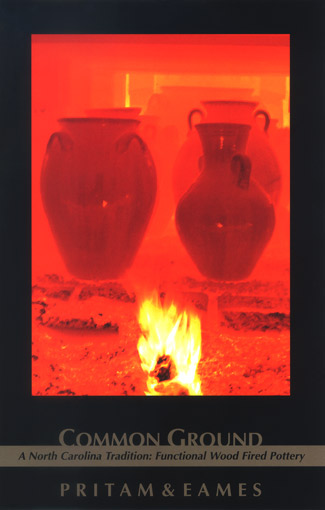
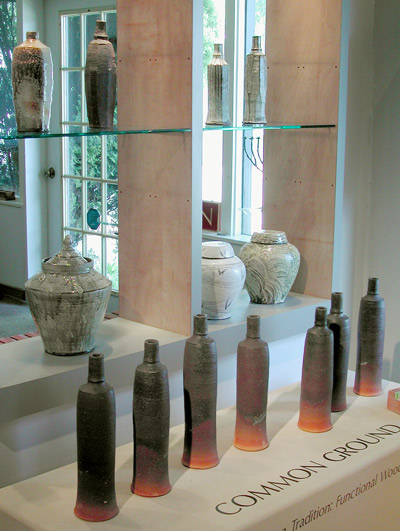
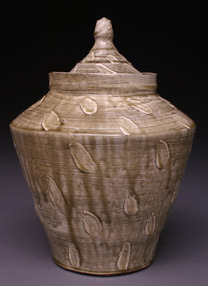
Wood fired local pipe clay, white slip, alkaline glaze.
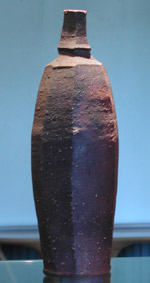
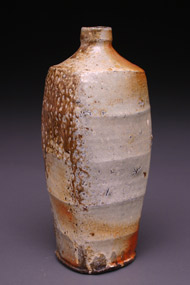
Wood fired local pipe clay.
Wood fired local pipe clay, rice hull ash glaze.

Top shelf: Two Gallon Pitcher, Small Vase, One Quart Bottle
Bottom shelf: Two Quart Flat Side Bottle, One Quart Pitcher, One Gallon Bottle, Two Quart Jug
Wood fired local stoneware clay, wood ash alkaline glaze, glass decoration.
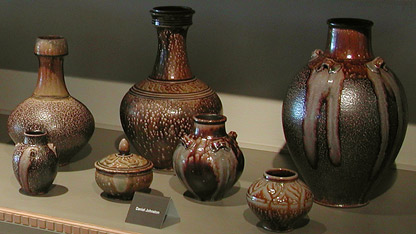
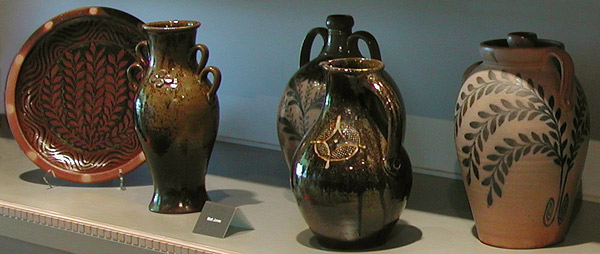
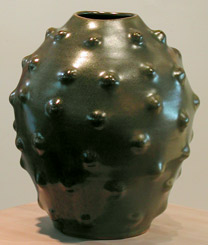
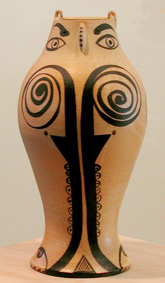
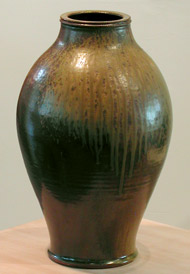
Stoneware, slip, salt glaze
Stoneware, frog skin glaze.
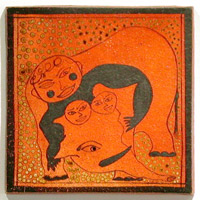
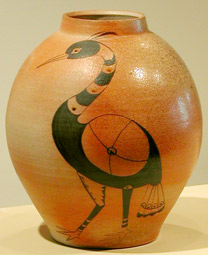
Stoneware, slip, salt glaze.
Stoneware, slip, salt glaze.
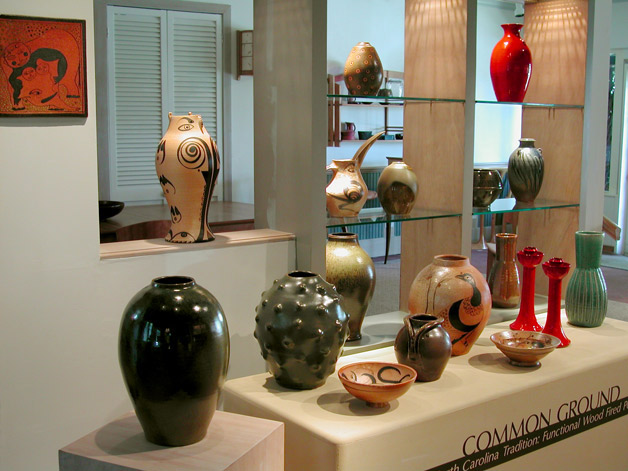
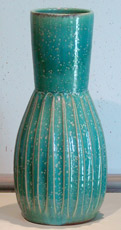
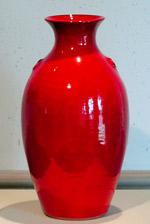
Wood fired stoneware, crystal blue glaze.
Earthenware, Chinese red glaze.
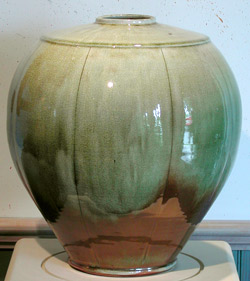
BRIAN NEWELL 2007
NOTES: Newell, a native of Flint, MI, had lived and worked in Japan for the last ten years at the time of this show. Writer/critic Jon Binzen says Newell’s work is a “series of compellingly mysterious pieces that take us into unmapped territory.” The body of work he produced for this exhibit at Pritam & Eames represents the last group of pieces he made before he returned to the United States. He would take up residence in Mendocino, CA, near The College of the Redwoods where he studied furniture making from master cabinetmaker, James Krenov.
In the two most time consuming pieces of this show from a maker’s point of view – the Zushi Cabinet and the Unagi Console -- Newell is working at the very outside with a functional destiny and takes, with a leap of faith, their visual poetry and sculptural energy as the very heart of the work. With this work he is saying, “Don’t quibble with me about function: they do work, but that’s only partly what they’re about.”
Confronting the Zushi Cabinet, you might ask, “A cabinet? Reliquary? Zushi?” Meanings for the term “zushi” have to do with both food and puzzle, and both are apt for this piece: an ample, smoothly rounded base with a mounded confection top. How do we access, and what is its use, brings us to the puzzle part. The whole of the upper carcass is a marvel of pierced, carved surface of African blackwood, the thickness being of sufficient weight to provide structure as well, and, also a canvas for the swirling pattern work. The central cavity is revealed by a single large door roughly two-thirds of the cabinet’s two foot height. This door can be opened only by first taking both carved end compartments upward and off the base completely. Inside one can easily imagine a home for a Buddha figure, a jade carving, or reliquary for family ashes. Before this door is a single drawer of equal width.
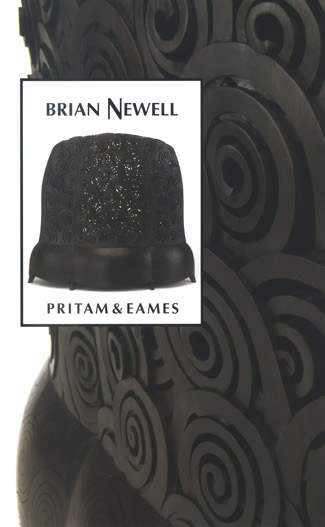
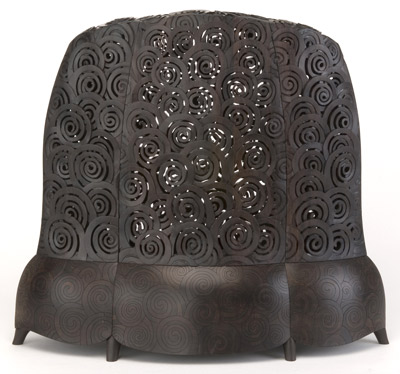
African blackwood, Yaku cedar.
Photos: Yoshiaki Kato
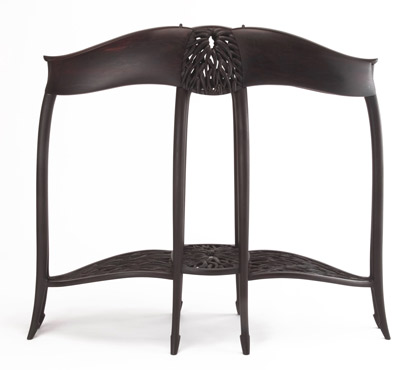
The Unagi Console: "Unagi" means both eel and a state of total awareness in Japanese culture. If you study the composition of the pierced carving, the eel forms become clear. It’s also easy to imagine that the maker must have been in a state of some total awareness to even conceive of this piece. While nodding at function -- it has lower shelves and compartments above -- the nature of this piece has more to do with the travel of life forces. The vortexes drawing in the eels’ flowing patterns are powerful centers in this piece. Nominally a console, as an object it stands complete.
"Unagi" Console
African blackwood, hong mu.
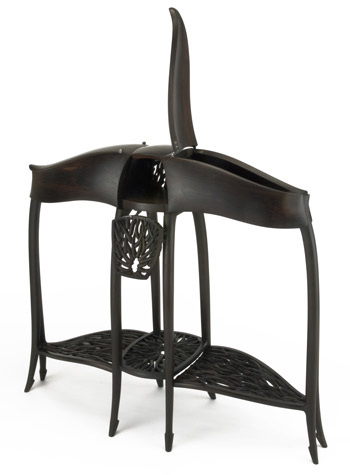


Jindai cedar, black persimmon.
Wall Cabinet in jindai cedar and persimmon. Quite apart from this cabinet’s arresting visage, its design makes experimental use of light and transparency. A view from above reveals an arched structure: the slender body arches away from the wall leaving its mounting to two horizontal facets on either end of the back. Light from above reflected on the wall will illuminate the interior since most of the rear is composed of a pierced carved back. The “squashed scroll” design of the carving admits maximum light. From the front, the only hint of this beautiful carving is seen through the central portal. The entire interior is revealed by opening the four front doors. Here you can imagine a collection of netsuke.
The Black Chest of African Blackwood opens its hinged top lid to reveal a pearwood interior. Closed, it provides an occasional seat, handy if used at a bed’s foot. Though the simplest in functional design of the four case pieces, the Black Chest’s “tiled” surfaces give it a secretive and powerful character. The spacing of the five tiles across is given further definition by six legs to the front and back.
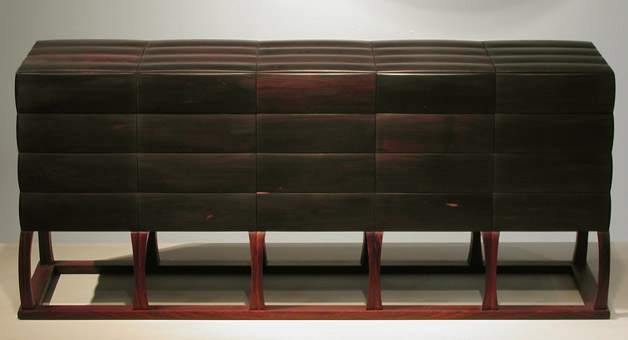
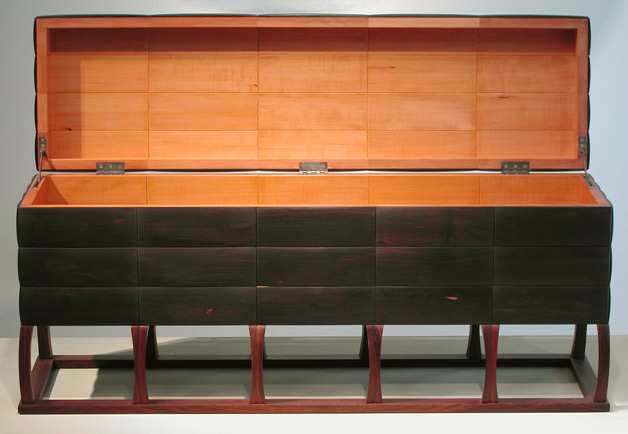
African blackwood, pearwood.
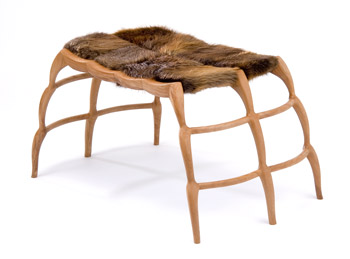
Filling out this show was a group of three benches. The Beaver Bench derived its name from a beaver pelt covered seat. The seat’s platform, with its six legs, was carved from a wood called Himeshara. The bench’s skeletal form heightened the “alive” quality of its beaver pelt seat.
Himeshara, beaver pelt.
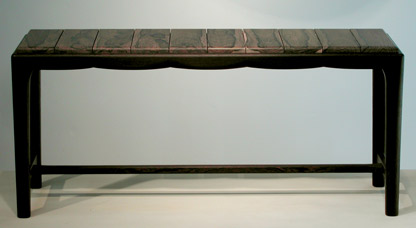
Wenge, ziracote.
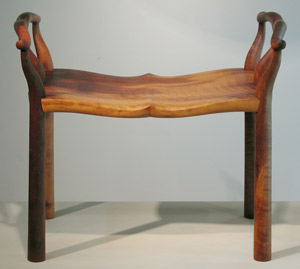
The China Bench was a less audacious, but an equally beautiful bench form. Carved and shaped from imbuya, this bench indicates its single seater function with a saddle-like seat, which has a slight crest in its center. Two horn-like side stretchers join the legs a little above the seat’s surface. The legs themselves thicken as they descend, reminiscent of temple posts.
Imbuya.
JERE OSGOOD
New Furniture 2007
NOTES: Jere Osgood is considered by many to be the dean of the American studio furniture movement. His role as a teacher and author is almost as legendary as his highly distinctive furniture.
For his Pritam & Eames show, Osgood will have a desk, a furniture form with which he is most associated, two small Water tables, a chair, and a jewelry cabinet. “His furniture remains innovative even after 40 years of object making,” says Bebe Johnson, gallery partner. “What Osgood is after in his furniture is a feeling of organic familiarity. He knows that in nature there are no straight lines – not in water currents, not in air currents, not the way a tree grows, nor the way we grow. His genius is that he has created the processes that allow him to chase those shapes he’s after.” Many of Osgood’s published articles center on his technical innovations in furniture making, like tapered laminations and compound bent stave laminations.
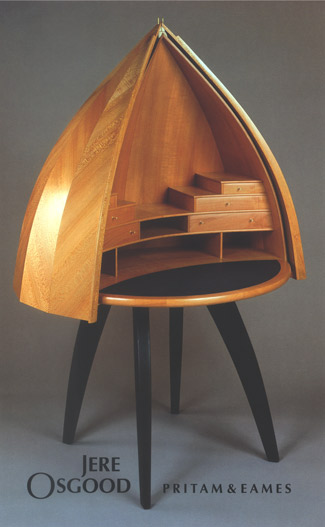
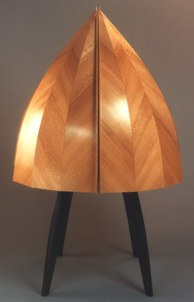
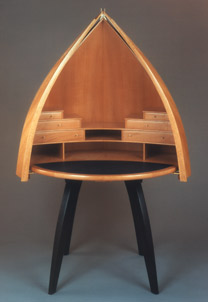
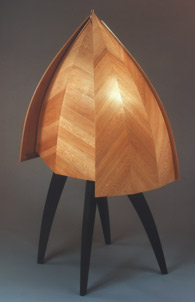
Quarter-sawn sycamore, pearwood, wenge, European hornbeam, African padauk,
bloodwood, leather.
67.5”H x 40 ”W x 31”D
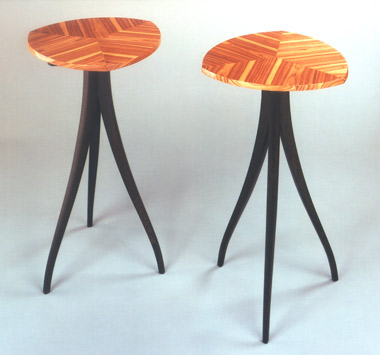
Brazilian tulipwood, wenge.
25”H x 15”W x 15”D
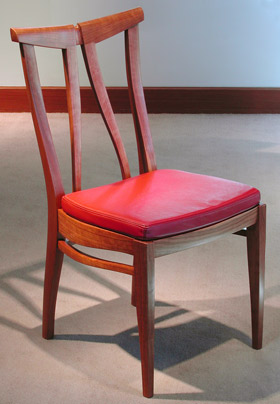
Figured cherry, Dalmarnock antelope leather upholstery by John Gagnon.
35”H x 18”W x 19”D
THOMAS HUCKER
New Furniture
2007
NOTES: This is the third and final time that Tom Hucker would join his teacher, Jere Osgood, for an exhibition of work. The rocker on the announcement was Hucker's latest evolution of a design which began with a bleached white oak version several years ago. Hucker's range in furniture styles goes from the Deco feel of his side table to his provocative breakfast table. In the side table design, he achieves an almost trompe l'oeil effect; it is as if the beading is an outer skin that is slowly peeling downward to reveal a secondary form.
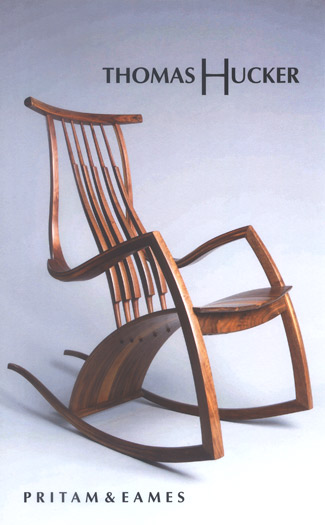
Available in fumed white oak.
39”H x 24”W x 40”D
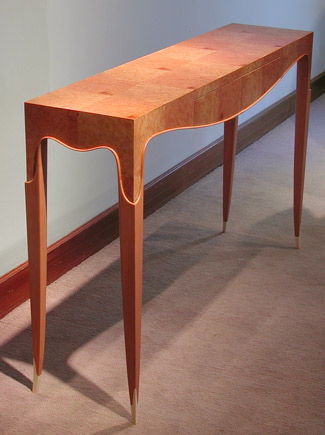
Madrone burl, pearwood, holly.
33.5”H x 52”W x 12.5”D

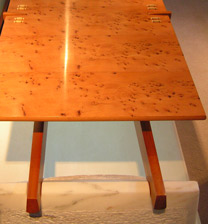
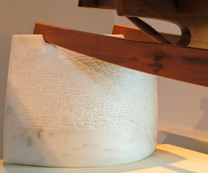
Yewwood, holly, white marble.
16.5”H x 7'W x 18.5”D
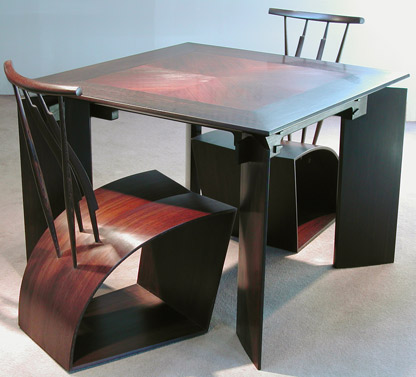
Quarter-sawn wenge.
29”H x 40”W x 40”D
Quarter-sawn wenge.
33.5”H x 52”W x 12.5”D
NOTES: Although there was no announced show with a theme or schedule, a number of pieces arrived in the fall by Andy Buck, Hank Gilpin, Duncan Gowdy, Kristina Madsen, Judy Kensley McKie, Richard Scott Newman, and Joe Tracy.
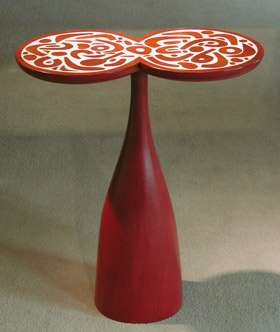
26.5"H x 21.5"W x 10.75"D
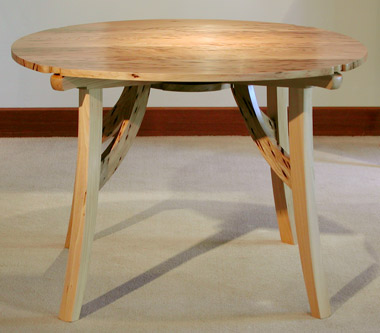
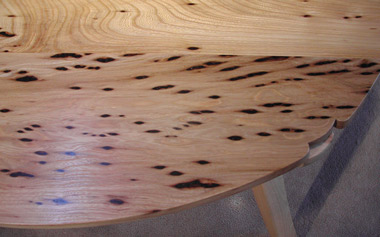
29"H x 42"W x 42"D
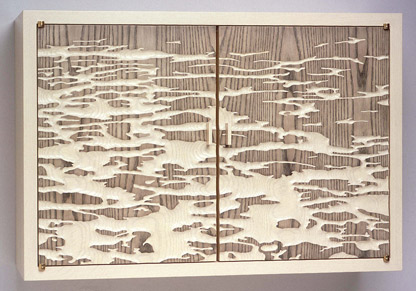
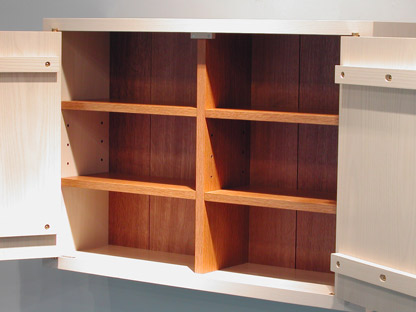
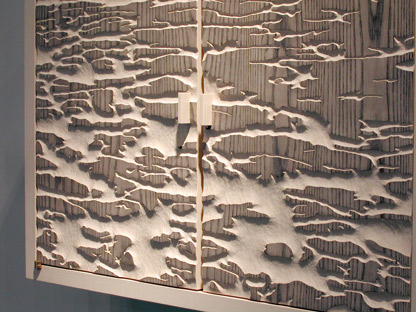
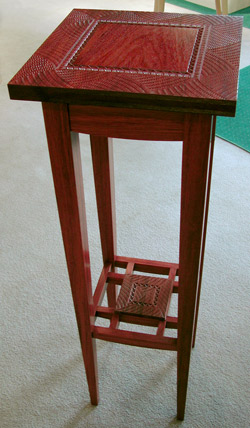
39"H x 13"W x 13"D
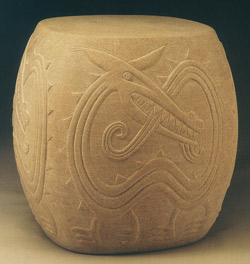
19"H x 20.5"W x 20.5"D
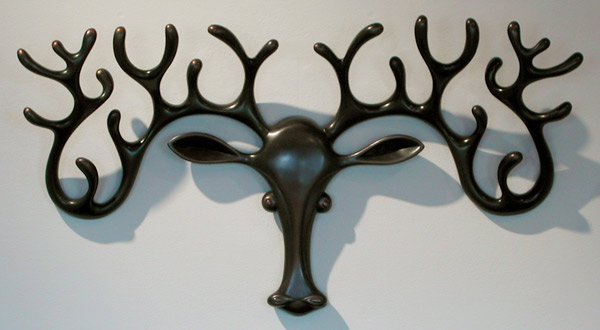
18.5"H x 35"W x 6.5"D
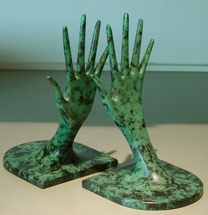
Each 8.25"H x 4.75"W x 4.75"D
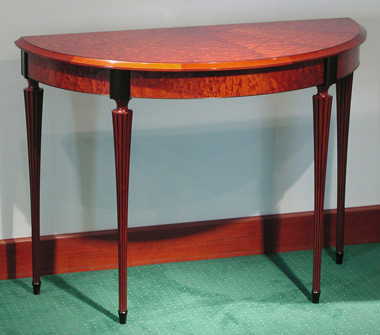
Mahogany, Ebony.
34.5"H x 45.5"W x 20"D
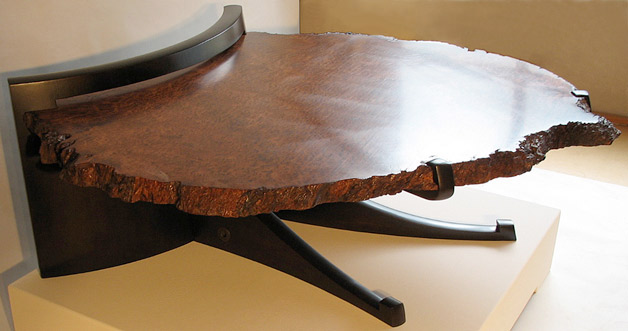
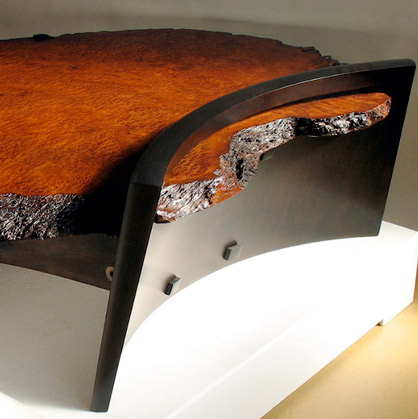
56"W x 52"D x 17.5"H (table top)/20"H (base)
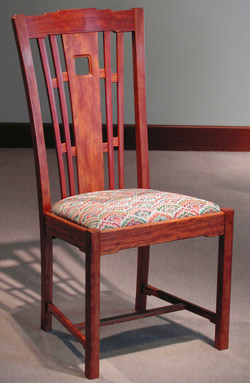
Bubinga, upholstery.
39.5"H x 19.25"W x 19"D
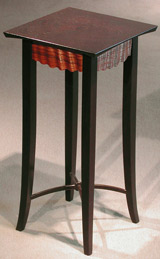
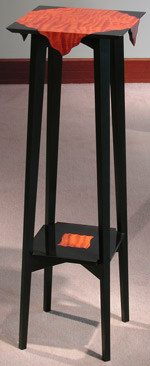
Wenge, split curly redwood.
23.5"H x 12" x 12"
Ebonized maple, curly redwood veneer.
36.25"H x 12" x 12"

26"H x 102"W x 36"D (Seat 18”H)
2008 EARLY SPRING SHOW
ANDY BUCK
JOHN ERIC BYERS
TIM COLEMAN
MICHAEL CULLEN
JOHN DUNNIGAN
GARY S. MAGAKIS
GREG SMITH
FRAN TAUBMAN
NOTES: Work in the Early Spring Show includes Greg Smith’s exquisite Eclipse jewelry case in afzelia, deodar cedar, and brass; Andy Buck’s witty cantilevered Lilypad Table in cherry with inlaid rosewood dots and painted base; and Fran Taubman’s modernist constructed steel low table.
Greg Smith’s Eclipse jewelry case and Andy Buck’s Lilypad Table reflect two different faces of the American studio furniture movement. Although both pieces exhibit rounded smooth sculptural forms, the makers’ approaches are fundamentally different as a result of their training and their artistic quests. Smith’s finely detailed construction technique reflects his education at the College of the Redwoods program under master cabinetmaker James Krenov. Andy Buck’s carved, shaped and painted form displays techniques gained from his training at the Rhode Island School of Design, where he studied with Rosanne Somerson and Alphonse Mattia.
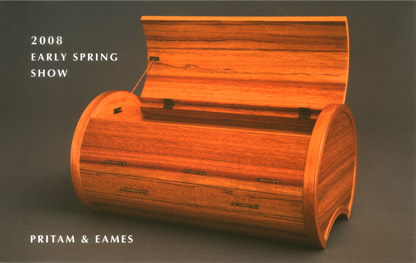
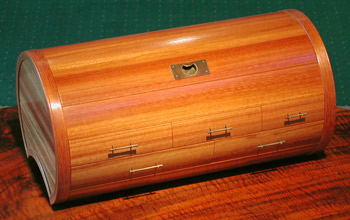
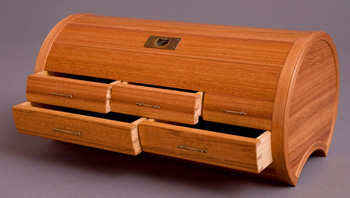
7.5"H x 15.5"W x 8.5"D
Photos: John Birchard
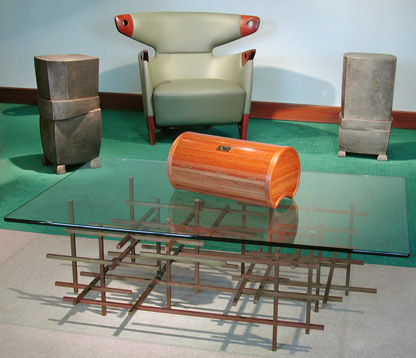
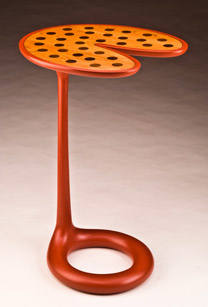
24.5"H x 14.5"W x 16"D
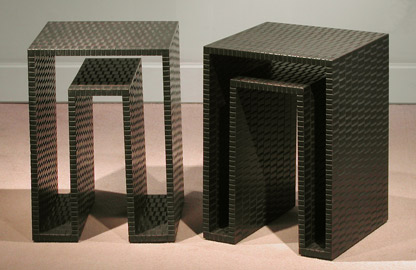
20.25"H x 14"W x 14"D
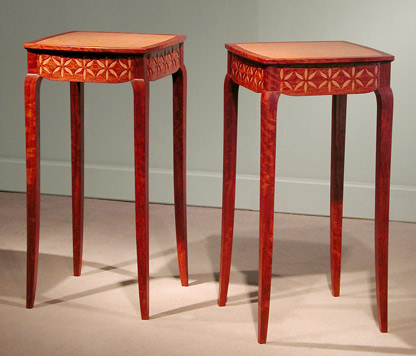
32"H x 16"W x 16"D
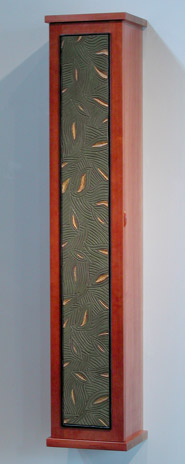
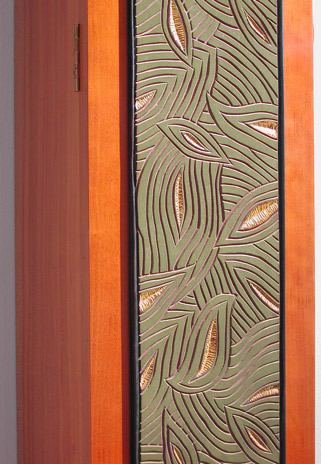
Quartered cherry with sapwood, sugar pine, milk paint.
44”H x 8.625”W x 7.5”
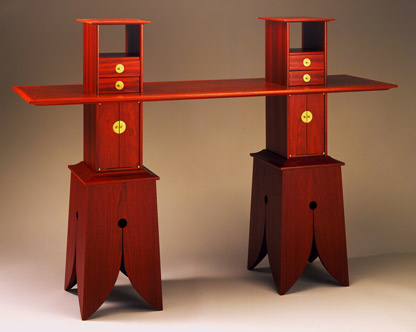
48"H x 66"W x 20"D
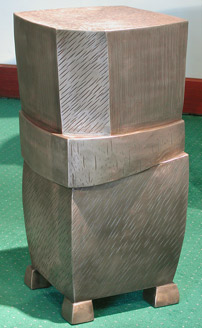
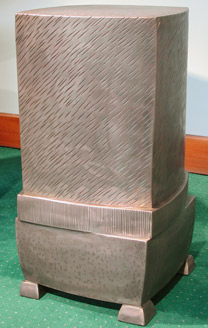
GARY S. MAGAKIS: Bronze.
26"H x 13"W x 13"D
"Sienna" Side Table by
GARY S. MAGAKIS:
Bronze.
26"H x 14"W x 13.5"D
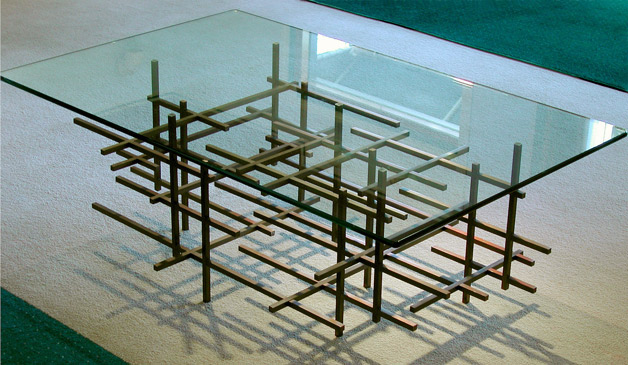
16.5"H x 48"W x 30"D
SAM STANG: GLASS 2008
NOTES: Sam Stang describes the Murrini glassblowing process he uses as follows:"All of my pieces are made by using traditional European glassblowing techniques. With the murrini pieces, I begin by making glass rods which are patterned in cross section. The rods are cooled and cut into thin pieces and arranged on an iron plate which is then heated to fuse the murrini. This is then rolled into a tube on the end of a blowpipe and shaped into the final form."
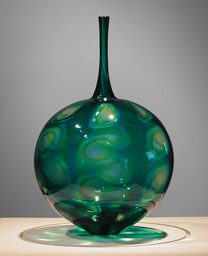
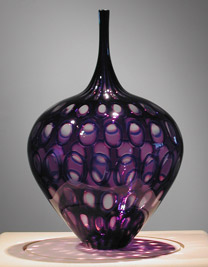
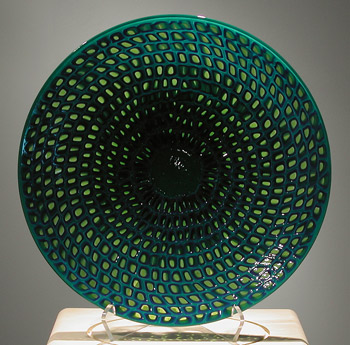
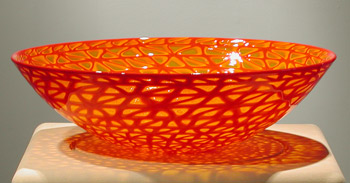
T0P FORM
Furniture 2008
May 23 - June 24, 2008
Andy Buck,
David Ebner, Janene Hilliard, Brian Newell, Richard Scott Newman, Jere Osgood, Timothy Philbrick, James Schriber
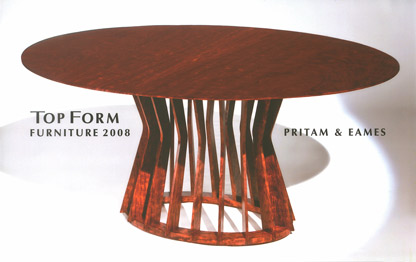
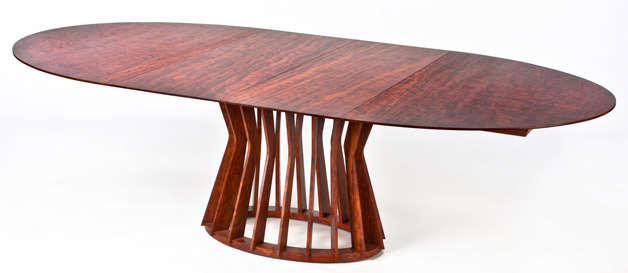
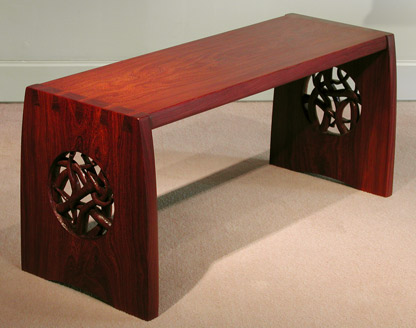
The major piece in the Top Form show was a solid bubinga dining room extension table by James Schriber. The form of the base has a modernist feel but also offers an invitation to the people who will sit around it.
There were three benches from Brian Newell in this show. The Jungle Plant Bench was made from an astonishingly dense plank of Indonesian hardwood. Its jungle plant design exhibits a parallel energy to the twisted eel patterns used in his previous show. Their three dimensional form shows Newell's gift for this kind of vision.
Jungle Plant Bench by BRIAN NEWELL: Unidentified Indonesian wood.
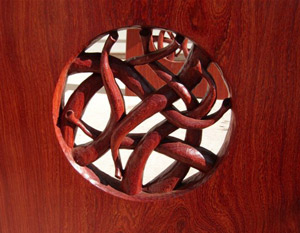
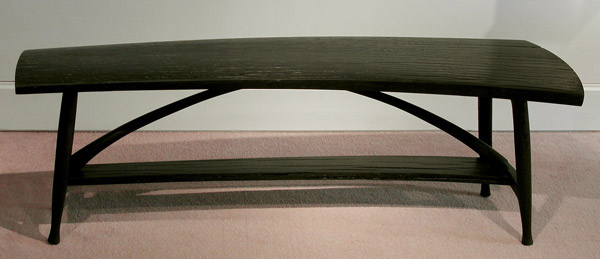
Bog Oak Bench by BRIAN NEWELL:
Bog Oak.
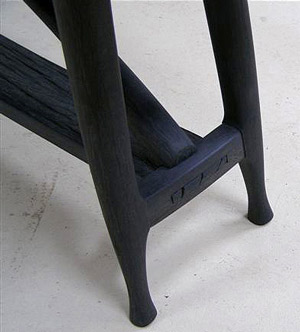
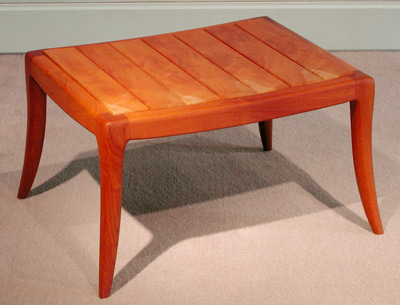
His bench made from bog oak has both a primitive quality to it as well as a sophisticated sculptural sensibility. There is a very strong unity in his vision.
The Keyaki Bench is simpler in form and is a nod to the work of the Japanese furniture maker's with whom Newell became acquainted during his 10-year stay in Japan. All three of these benches were made in Japan.
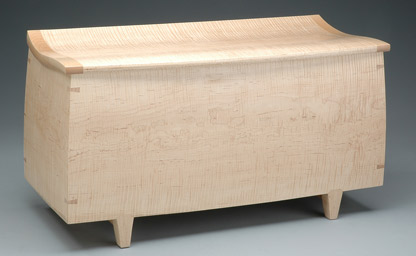
Blanket Chest by JERE OSGOOD:
Curly maple, cedar of Lebanon, leather.
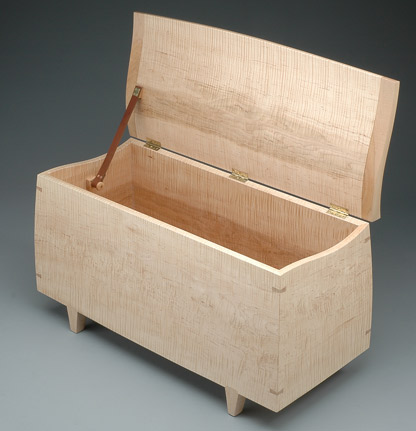
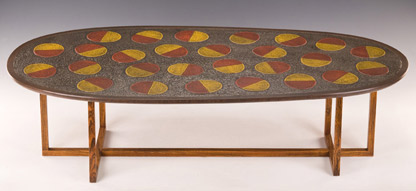

White oak carved, painted and lacquered; base of cocobolo.
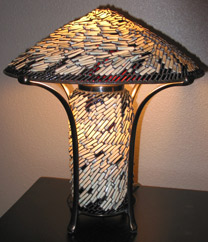
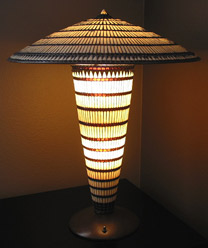
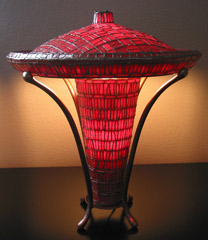
by JANENE HILLIARD:
Hand-blown glass, bronze.
by JANENE HILLIARD:
Hand-blown glass, bronze.
by JANENE HILLIARD:
Hand-blown glass, bronze.
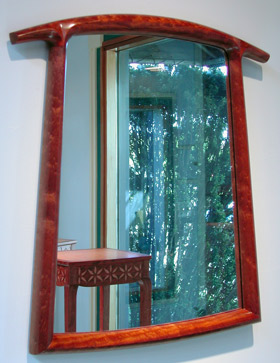
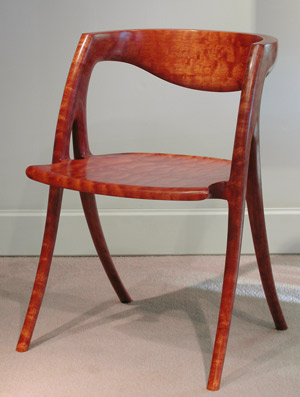
Genuine Honduras quilted mahogany.
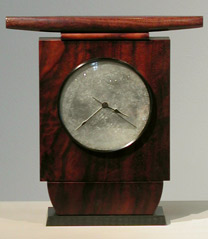
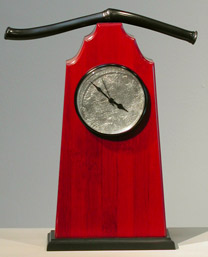
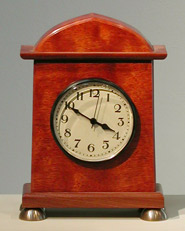
Claro walnut.
Bamboo.
Curly ash, afromosia.
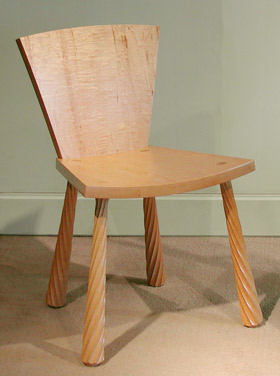
Richard Newman's maple chair refers, in part, to a country milking stool. Its solid members construct a chair made from six major parts. The look of the chair is deceptively simple. The legs are tenoned directly into the solid seat, and the tapered legs are carved with a reverse spiral flute pattern, while the thin outlines of their tenon ends are veneered in cherry. The shaped seat and back are joined together with a dovetail joint.
Tim Philbrick's side table, which doubles as a tray table, uses some of the last of the Macassar ebony carried on board the Edna (see On Board the Edna, 1989). The top is equally exotic with its use of satinwood.
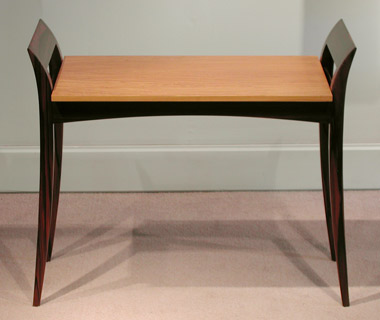
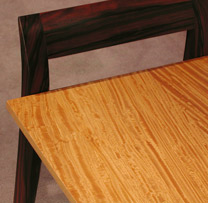
Side Table by TIMOTHY PHILBRICK:
Macassar ebony, satinwood.
Furniture by
DUNCAN GOWDY
NOTES: The furniture of DUNCAN GOWDY was the subject of a featured show at Pritam & Eames, June 28 – July 29. The show featured a Blanket Chest with Pine Branches, a pair of wall-hung Brook Cabinets, a Dresser with Glacial Shadow, a Mirror with Branches, and a bench. “Duncan Gowdy’s signature in furniture is the quality of reserve,” says Bebe Johnson, gallery partner. His furniture often employs the imagery of a winter landscape from his native New England.
His teacher, Wendy Maruyama, Professor and Chair of the Furniture Design Program at San Diego State University, says, “Duncan Gowdy often speaks of his Yankee heritage, one that comes from his grandfather and father, that has shaped this artist and his work ethic. Gowdy’s furniture evokes a memory of looking out a window to a cold wintry sky with the silhouettes of the pines in movement. There's a feeling of a warm wood paneled cabin wall that's in contrast to the cold glass window pane. His stark, yet warm, white bleached wood surfaces highlight the reeds dancing across the faces of his dresser. His work is simply and honestly poetic.”
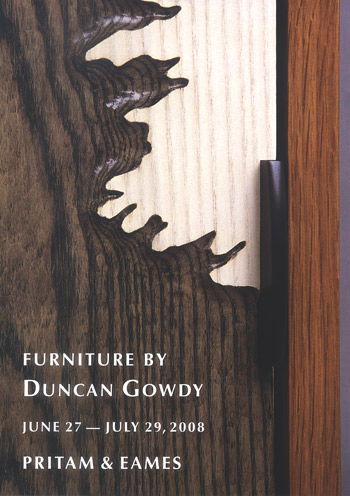
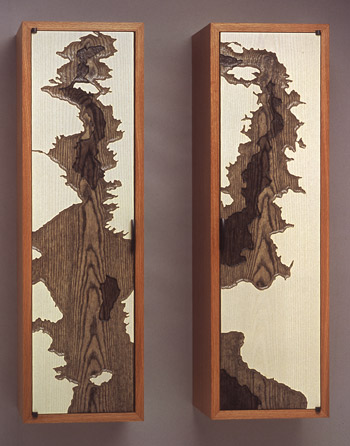
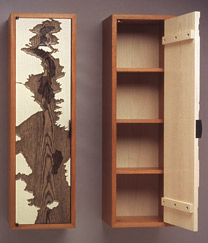
Brook Cabinets
Rift-sawn white oak, ash, stain.
38"H x 11"W x 8"D (each)
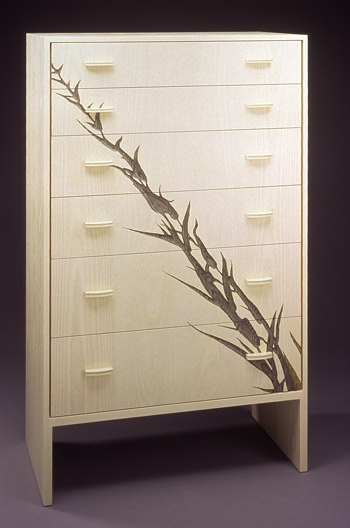
Dresser with Glacial Shadow
Ash, quarter-sawn maple, ash plywood.
54"H x 33"W x 18"D
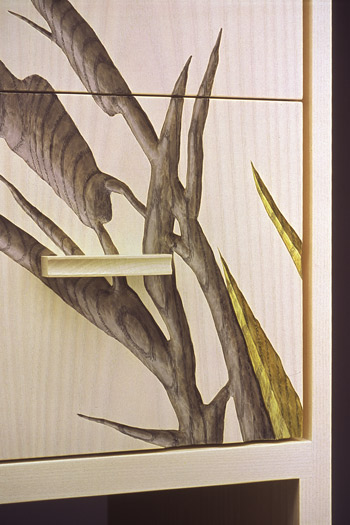
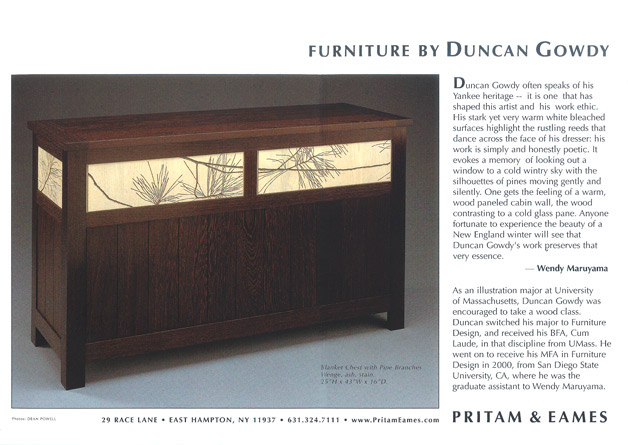
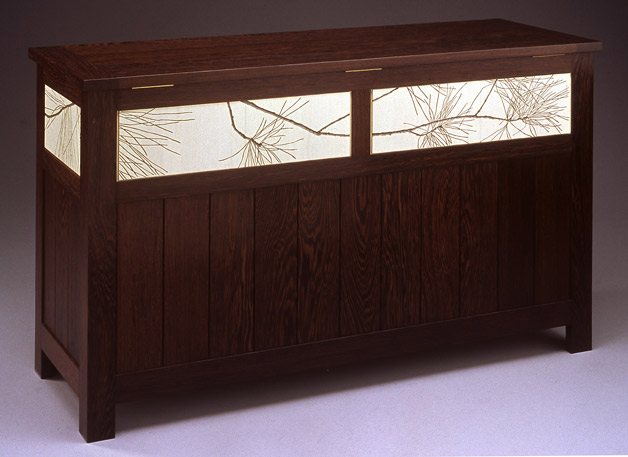
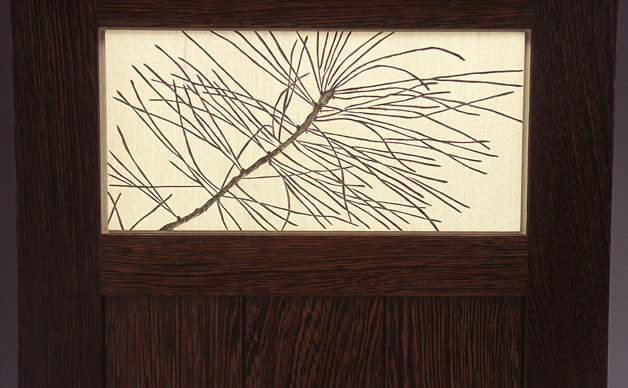
Wenge, ash, stain.
25"H x 43"W x 15.5"D
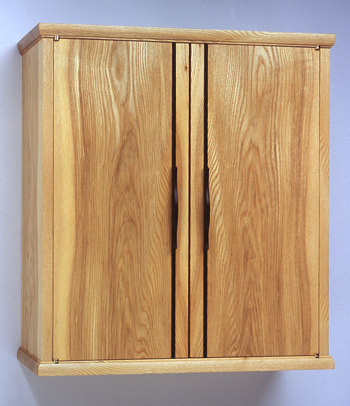
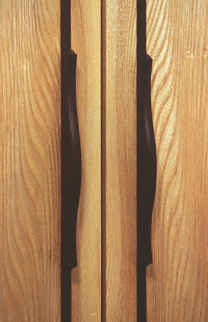
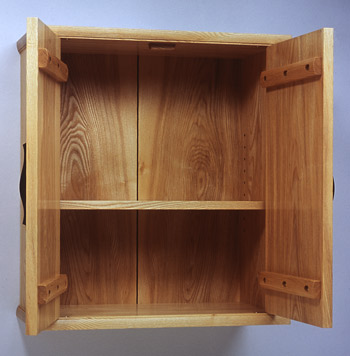
Ash, wenge.
21"H x 20"W x 8"D
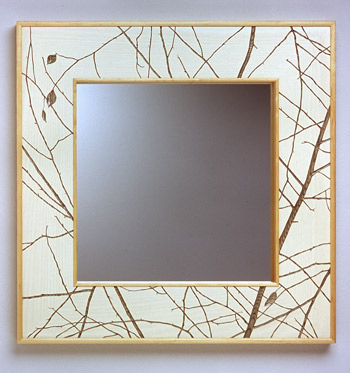
Ash, maple.
22"H x 22"W x 1.5"D
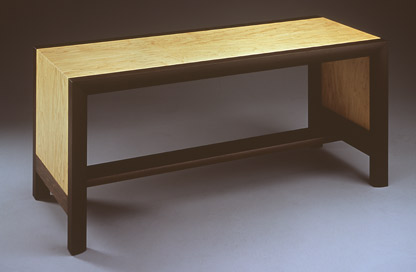
Wenge, maple.
18"H x 40"W x 16"D
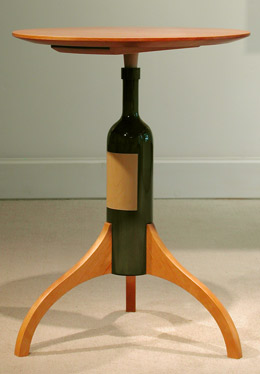
Cherry, maple, paint.
25"H x 19"diameter
The Marina Line
by MICHAEL HURWITZ
July 25 – September 2, 2008
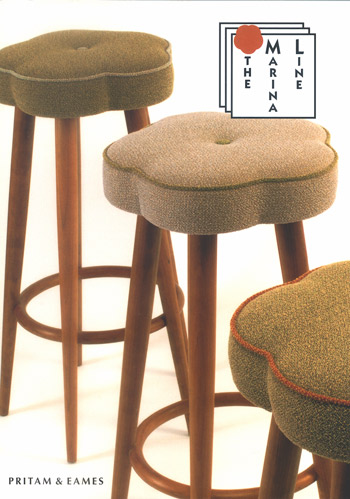
Cherry, fabric made from 100% recycled material.
16.5"H x 7"W x 18.5"D
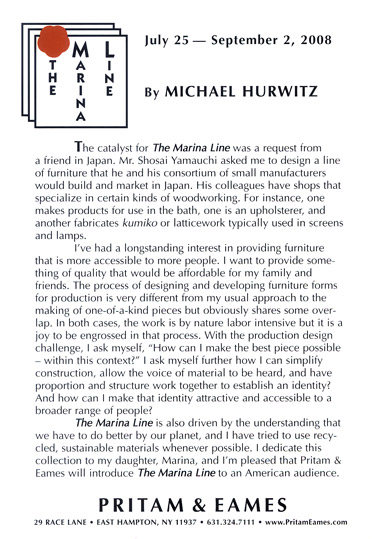
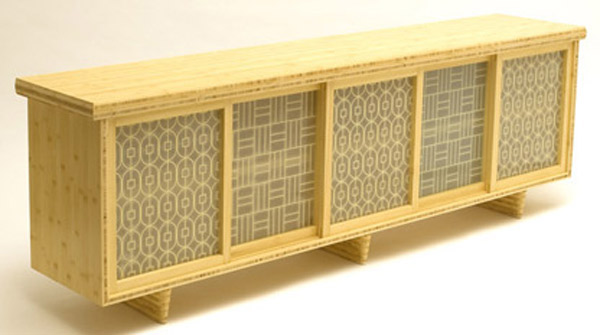
Bamboo plywood, reclaimed Alaskan Yellow Cedar, antique plate glass.
24"H x 72"W x 18"D
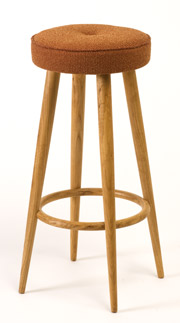
Ash, fabric made from 100% recycled material.
31"H x 17.5"W x 17.5"D
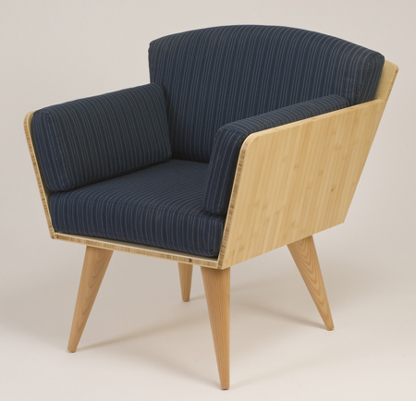
Bamboo plywood, ash, fabric made from 100% recycled material.
32"H x 32"W x 28"D
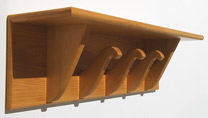
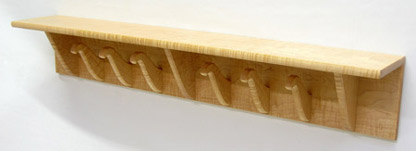
Figured maple.
Small: 7"H x 24"W x 7"D
Figured Maple.
Medium (above): 7"H x 41"W x 7"D
Large: 7"H x 57.5"W x 7"D
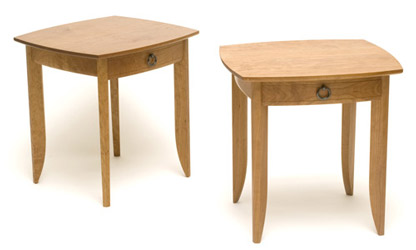
Cherry or ash, iron pulls.
20"H x 20"W x 18.5"D
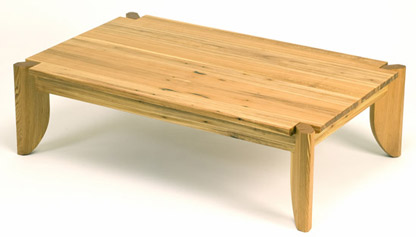
Reclaimed Southern yellow pine.
14"H x 48"W x 30"D
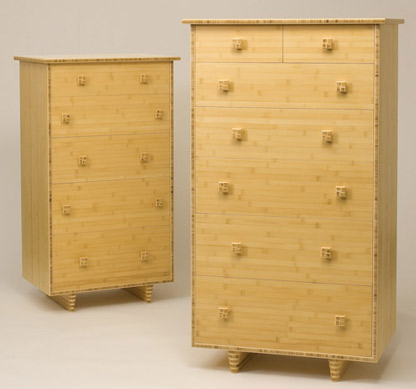
Bamboo plywood, formaldehyde-free composite made from
sunflower seed husks.
48"H x 27"W x 19"D
Bamboo plywood, formaldehyde-free composite made from
sunflower seed husks.
55"H x 31"W x 21"D
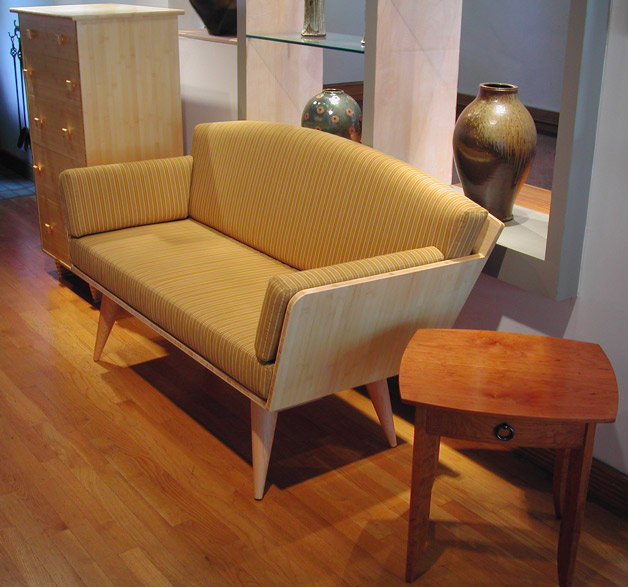
Bamboo plywood, fir, fabric made from 100% recycled material.
32”H x 62”W x 28”D
Bamboo plywood, formaldehyde-free composite made from
sunflower seed husks.
48"H x 27"W x 19"D
Cherry, iron pull.
20"H x 20"W x 18.5"D
JUDY KENSLEY McKIE
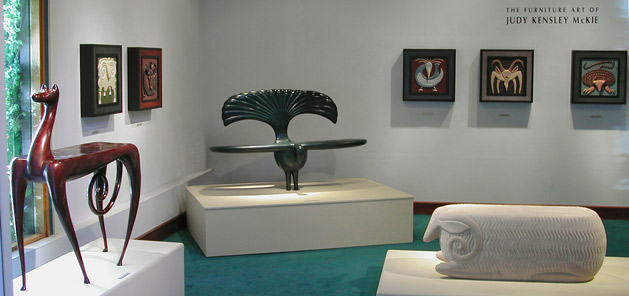
August 1 -- September 9, 2008
NOTES: The Furniture Art of JUDY KENSLEY McKIE is her eighth solo exhibit at Pritam & Eames and featured 17 wall-hung cabinets with bas-relief carved and painted animal and bird imagery for which she is well known. In addition to the wood cabinets, there are two new stone works and two new bronze pieces by McKie in the exhibit: the Ram Bench in Indiana limestone and the Elephant Bench in marble, as well as a bronze horse console table and a bird settee.
The 17 wall-hung cabinets were based on McKie’s graphite drawings. The expressions of the various creatures, prompted one visitor to say: “It’s marvelous that she has the {maturity} and confidence to express herself so freely, almost like a child.” There is great precedence of artists striving for child-like simplicity in their work, and the allegorical nature of the creatures McKie creates do seem like images you could find in children’s books. However, the deceptively uncomplicated representation of the creatures should not belie the mastery of McKie’s bas-relief carving and painting techniques.
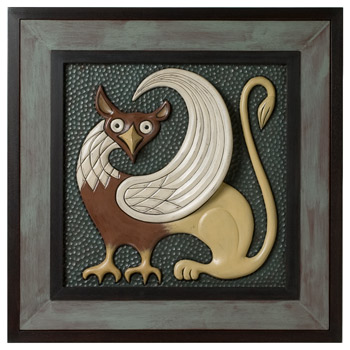
Carved mahogany, milk paint.
21"H x 21"W x 4 "D
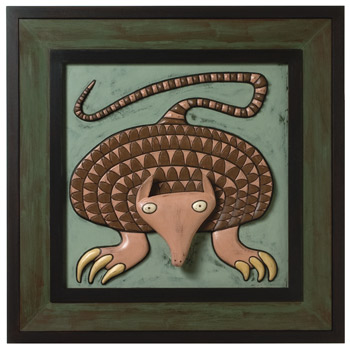
Carved mahogany, milk paint.
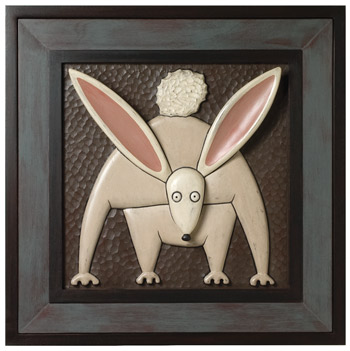
Carved mahogany, milk paint.
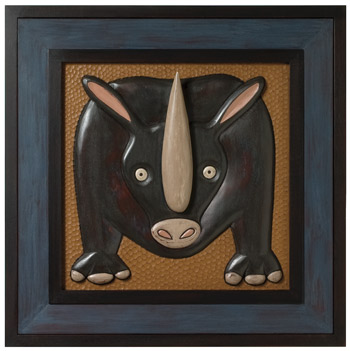
Carved mahogany, milk paint.
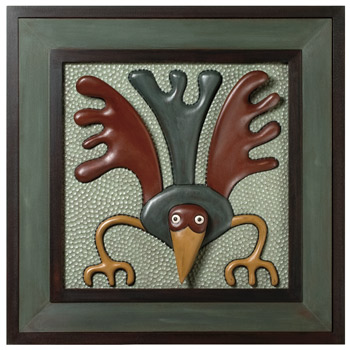
Carved mahogany, milk paint.
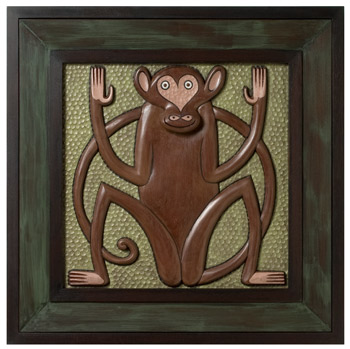
Carved mahogany, milk paint.
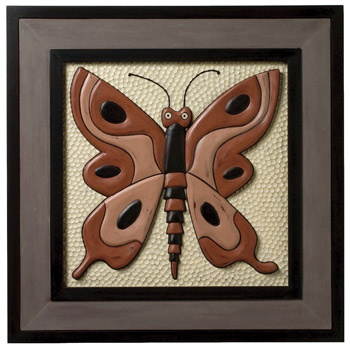
Carved mahogany, milk paint.
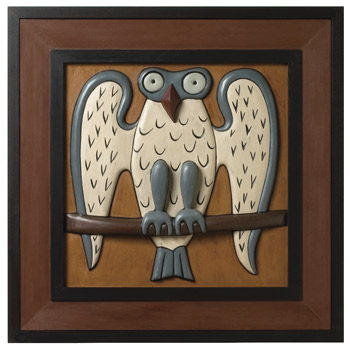
Carved mahogany, milk paint.
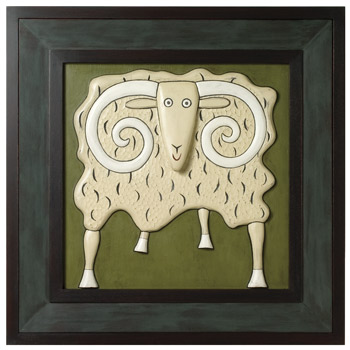
Carved mahogany, milk paint.
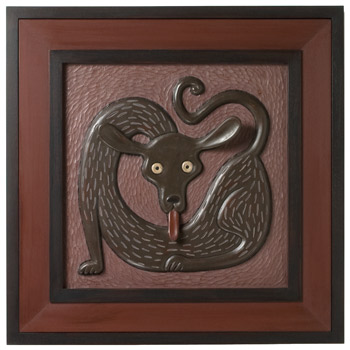
Carved mahogany, milk paint.
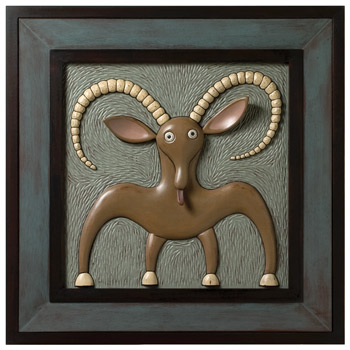
Carved mahogany, milk paint.
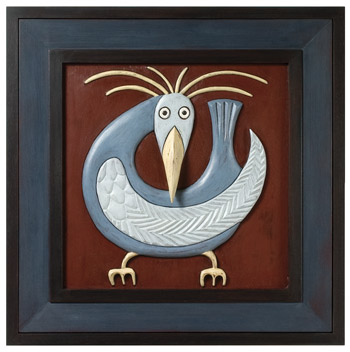
Carved mahogany, milk paint.
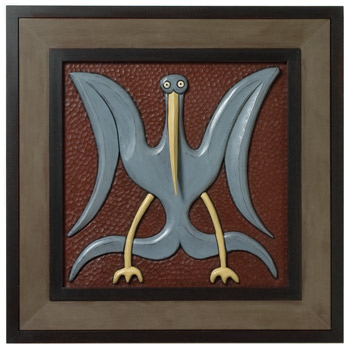
Carved mahogany, milk paint.
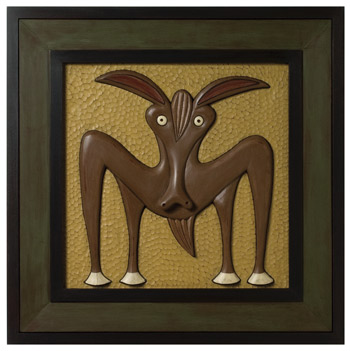
Carved mahogany, milk paint.
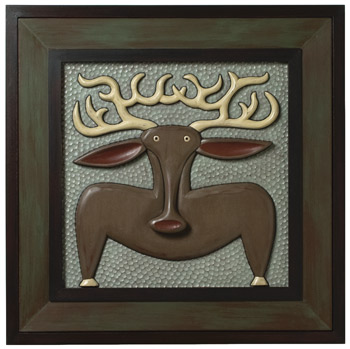
Carved mahogany, milk paint.
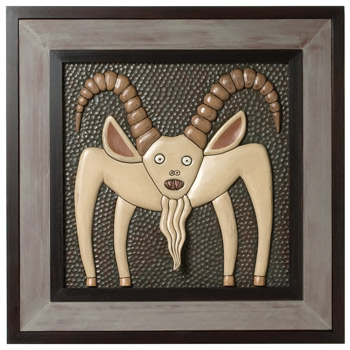
Carved mahogany, milk paint.
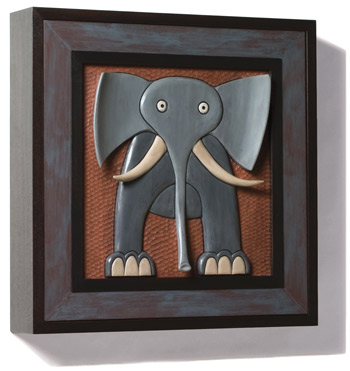
Carved mahogany, milk paint.
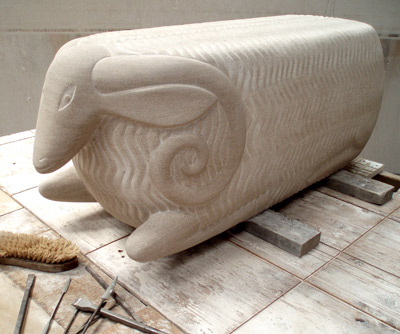
Indiana limestone.
17.5"H x 47.5"W x 17"D
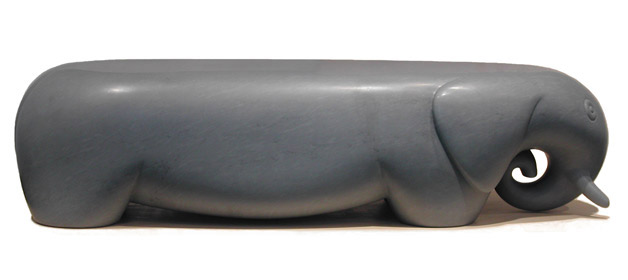
Grey Bardiglio Marble.
17.5"H x 70"W x 25.5"D
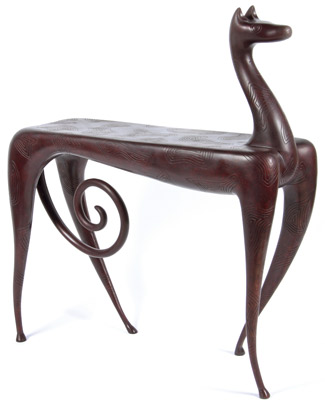
Cast bronze.
42"H x 38"W x 12"D
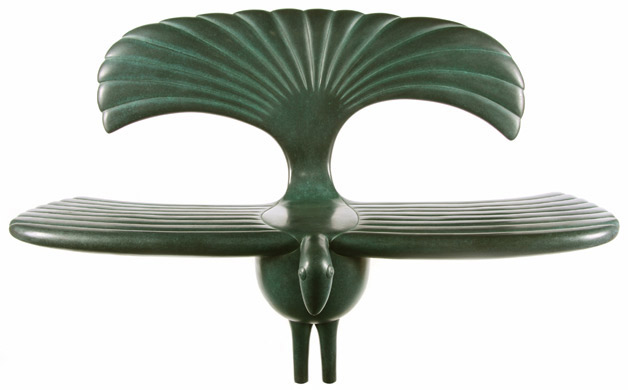
Cast bronze.
36"H x 60"W x 28"D
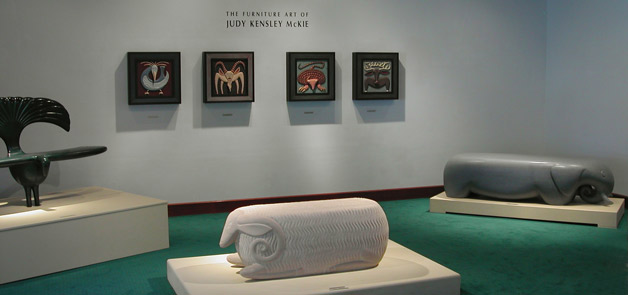
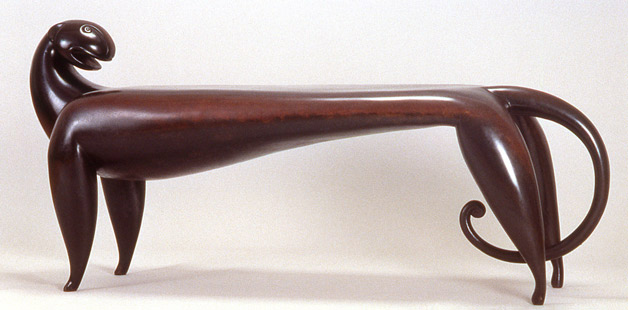
Cast bronze.
27.5"H x 56"W x 17.5"D
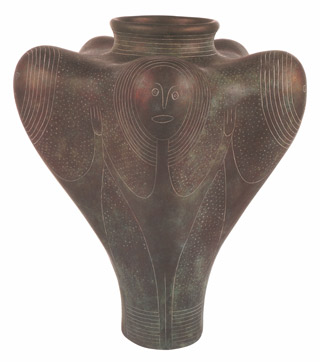
JUDY KENSLEY McKIE:
Last of the Bronze Editions
2008
NOTES: Judy McKie considered the bronzes in this show to be among the best that she had done. She held onto these pieces as their editions sold out. In 2008 she decided to offer them for sale, and Pritam & Eames clients were the beneficiaries.
Cast bronze.
29"H x 24.5"W x 24.5"D
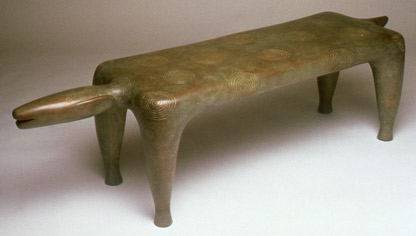
Cast bronze.
16"H x 57.5"W x 15"D
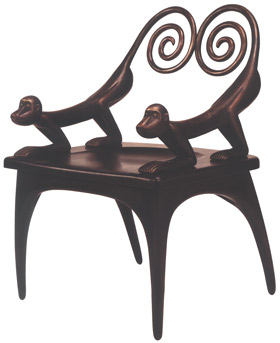
Walnut, cast bronze.
36"H x 25"W x 25"D
SMALL TABLE SHOW
December 15, 2008 - February 3, 2009
Andy Buck, David Ebner, Hank Gilpin, Duncan Gowdy
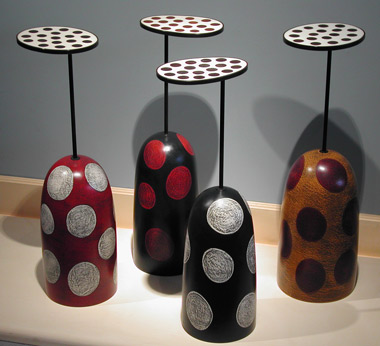
Poplar, steel, resin and cherry/mahogany/wenge.
25.75"H x Bases 7-7.75"diameter/Tops 8" x 5.25-6"
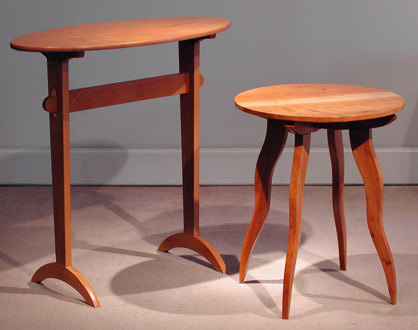
Madrone.
30”H x 30”W x 15”D
Apple.
23”H x 19”diameter
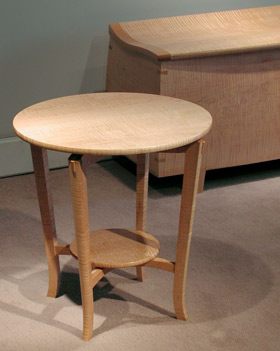
Curly red maple.
21”H x 20”diameter
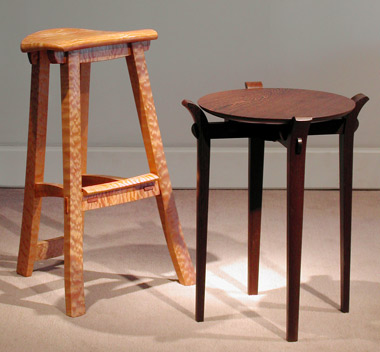
Wildly quilted big leaf maple.
27.25”H x 17.75”W x 16”D
Wenge.
23”H x 19”W x 19”D/15.5”diameter
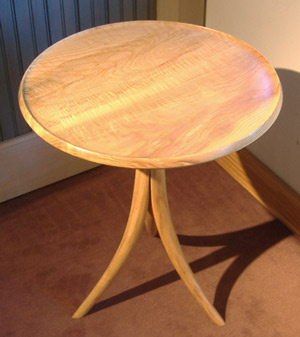
Figured ash.
23.5"H x 19.25"diameter
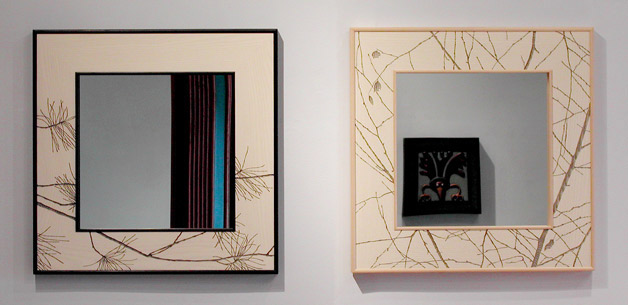
DUNCAN GOWDY
Ash, wenge, stain.
22"H x 22"W x 1.5"D
Ash, maple, stain.
22"H x 22"W x 1.5"D
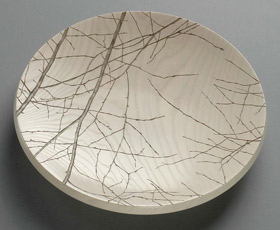
Ash, stain.
2.5"H x 16"diameter
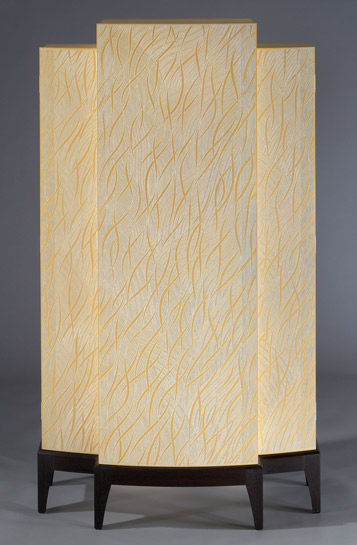
In any commission situation, a furniture maker usually has to take into account a number of givens. A successful outcome in a commission situation for the artist-craftsman is when these givens have been turned into a design that not only meets or exceeds the client’s expectations but, also, at the same time, satisfies and expands the repertoire of the artist’s own vision. In the case of this Jewelry Chest commission, Kristina Madsen worked with two talented New York designers, Jorge Cao and Don Thomas, who designed the interior of this New York apartment. The apartment owners had had a long standing relationship of trust with the designers, and naturally turned to them when they decided to do a major overhaul of their apartment space. The designers commissioned James Schriber to do a number of stand-alone and built-in pieces for the apartment. Of Schriber's work, Madsen says, “James did a spectacular job building many of the pieces in the space.”
For her part, the designers asked Madsen to build a jewelry cabinet. She describes the considerations that went into the making of her supremely beautiful cabinet: “My primary consideration was to design a piece that would be harmonious with the rest of the room - a bedroom. It was a compact room, outfitted with large, curved door built-ins by James (Schriber) of avodire and zebrawood. The avodire is pale yellow, similar to satinwood, and it was this color that suggested the beeswax colored paint for the cabinet. The wall against which it was to be placed was a narrow strip between two large windows, upholstered in pale peach silk. The foot of the bed was very close to this, so the cabinet had to be shallow: hence, the step-back of the side cabinets. The client’s only guideline was that she wanted it to be as spacious as possible. Beyond that, I was given complete freedom. With the exterior subdued in color, I thought it would be fun to have a really bold interior. The color of the padauk picked up on small orange tufts in a beautiful bed cover nearby, and the wenge base was meant to set off the lightness of the cabinet. The carved pattern was inspired by a painting by Jacques Martinez that I had seen in a book.”
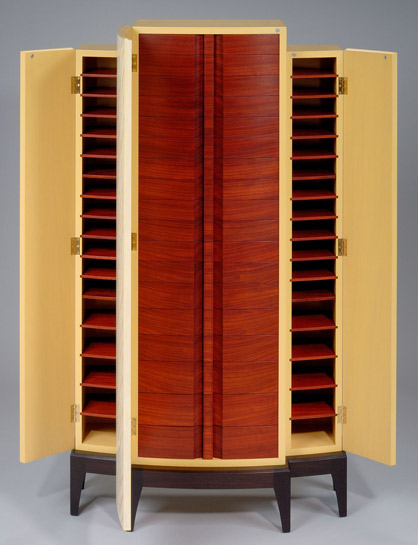
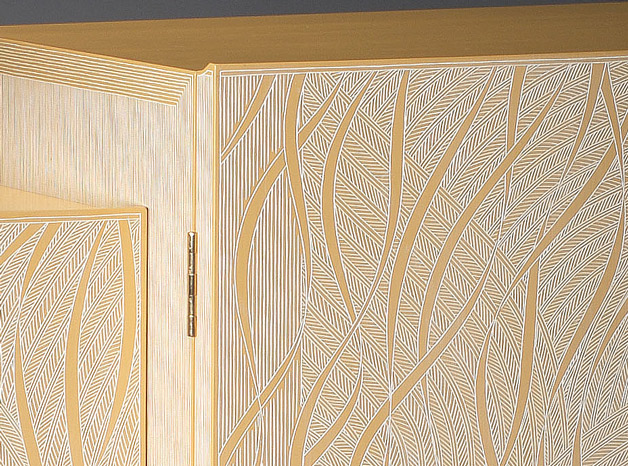
David Ebner, Noel & Janene Hilliard, Tony Kenway, Greg Smith, Stewart Wurtz
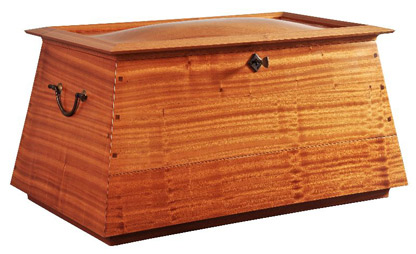
Sapele, hand-forged bronze.
19"H x 34"W x 22"D
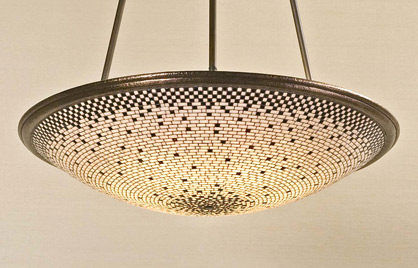
Hand-blown glass tiles, bronze.
34"diameter
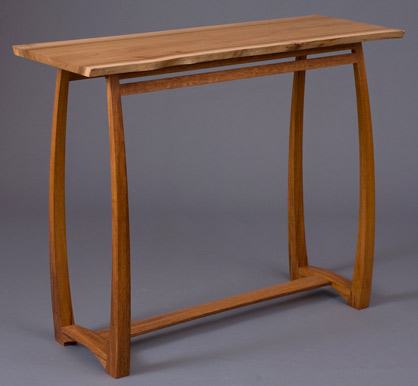
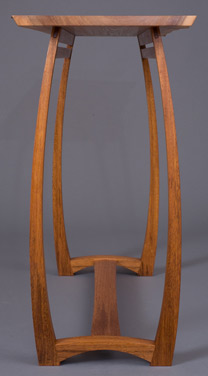
Red elm, kwila.
34”H x 42”W x 17”D
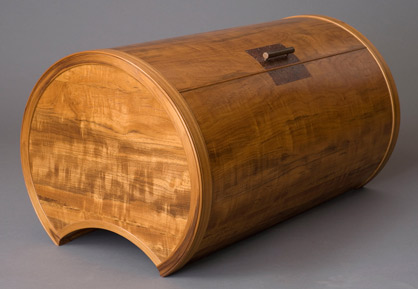
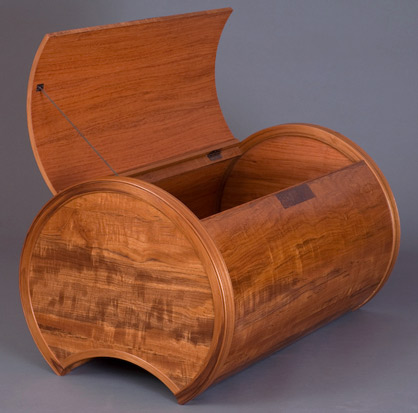
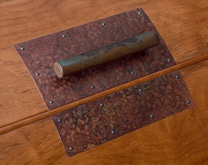
Blanket Chest by GREG SMITH
Teak, afzelia, copper.
19”H x 36”W x 22”D
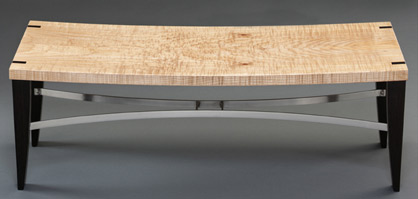
Rubin Bench by STEWART WURTZ
Curly maple, wenge, steel.
18"H x 48"W x 17"D
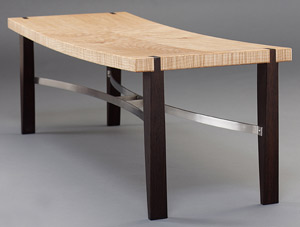
THE CASE F0R CARVING
May 22 -- June 30, 2009
ANDY BUCK
JOHN ERIC BYERS
TOM CALHOUN
MICHAEL CULLEN
DAVID EBNER
DAVID ESTERLY
DUNCAN GOWDY
JANEL JACOBS0N
KRISTINA MADSEN
BRIAN NEWELL
RICHARD SCOTT NEWMAN
RANDALL ROSENTHAL
HOWARD WERNER
NOTES: The process of carving has remained essentially unchanged from pre-historic times: it cuts out the unwanted part; the remaining part is the work. Today, with tools like the chisel, carving knife, gouge, chainsaw, or CNC router, carving still puts the maker in immediate touch with the material, whether the material is wood, stone, sand, or pumpkin.
Most of the carving designs that have evolved from different cultures have something in common -- they have their roots in nature and natural form. So whether it is Viking, Celtic, Maori, Eskimo, or African, it all starts with nature and imagination.
In The Case for Carving show, using wood and a few tools, the artist-craftsmen in this show demonstrate how they bring a flat board to life.
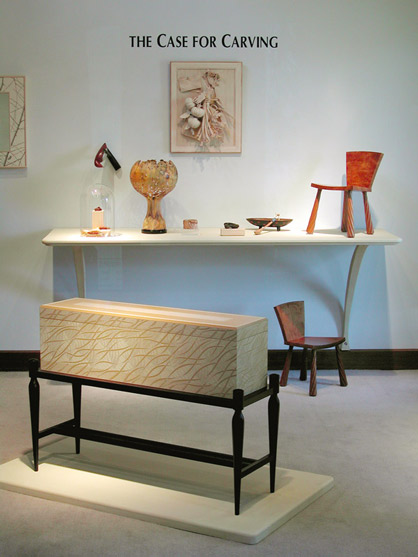
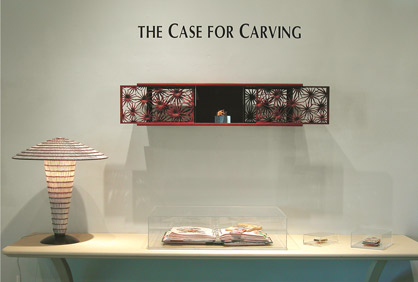
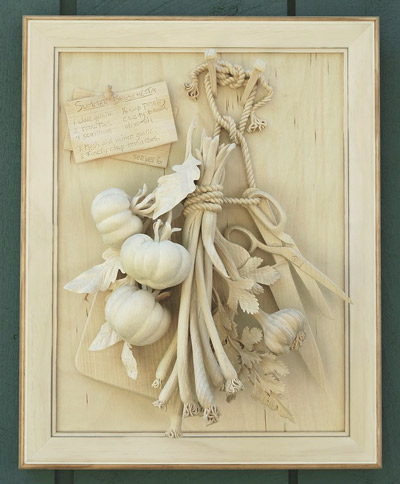
David Esterly’s studio is in upstate New York, where he works in the tradition of 17th-century British carver, Grinling Gibbons, who is generally recognized as one of the greatest wood carvers of all time, specialized in high relief -- four to six inches deep -- almost life-size foliage carving. Although Esterly’s subject matter may occasionally deviate from foliage, his use of material is constant; he always carves in European limewood, a relative of American linden, or basswood. Like Grinling Gibbons before him, Esterly uses no finish on his carvings; he allows the shadows cast by the relief carving to reflect directly on the pale wood.
Limewood.
21.5”H x 17”W x 6”D
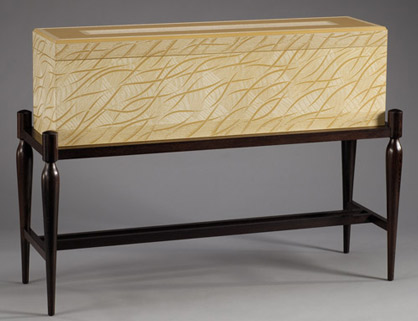
Kristina Madsen mastered intaglio or shallow-relief, carving after a year’s stay in Fiji in the early 1990s. There, as a Fulbright grantee, she apprenticed with master Fijian carver, Makito Koto, who taught her the intricacies of carving done to a depth of no more than a 16th to a 32nd of an inch deep. Intaglio is characteristic of carving in the South Seas. Although she had previously carved in her furniture, Madsen acknowledges that the Fijian experience was an epiphany for her.
She says that the carved surface has become more and more important to her furniture design, and has begun to view her work as a study of pattern -- repetitive, non- repetitive, figurative, abstract, geometric, monochromatic, polychromatic -- with furniture as its medium.
Chest: Maple, milk painted, carved, gesso. Stand: Wenge.
29”H x 41”W x 14”D (Box: 11”H x 37.5”W x 10”D)
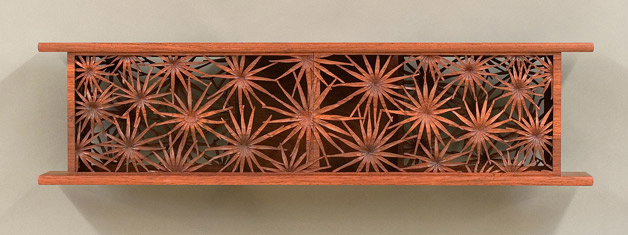
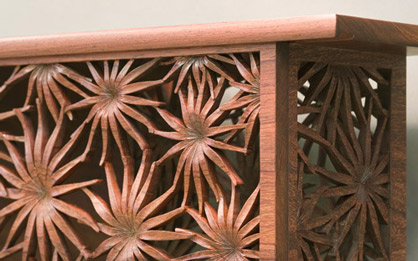
Wall Cabinet by BRIAN NEWELL
Rosewood.
9"H x 34"W x 8"D
Brian Newell chip carved wooden signs for shopkeepers as a teenager in his native Flint, Michigan. He pursued his interest in wood and studied with master cabinetmaker, James Krenov, and his furniture represents some of the boldest, most exciting work we’ve seen in decades. His carving is exceptional as seen in this rosewood wall-hung cabinet.
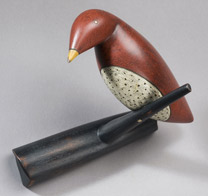

Andy Buck's charming bird, spoon, bowl, and hope chest demonstrate his mastery of carving as well as friendly, inventive forms.
Mahogany, walnut, milk paint.
5.5”H x 7”W x 5/5”D
Beech, milk paint.
11" long
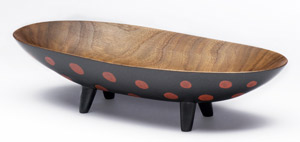
Walnut, milk paint.
2.75”H x 11.25”W x 5”D
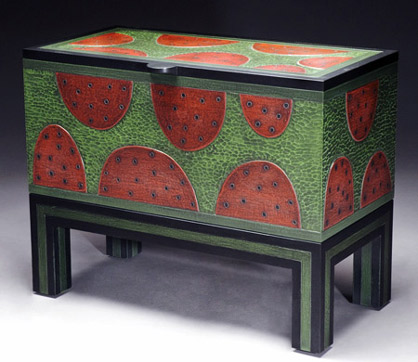
Mahogany, poplar, milk paint.
3.5”H x 7.5”W x 3.25”D
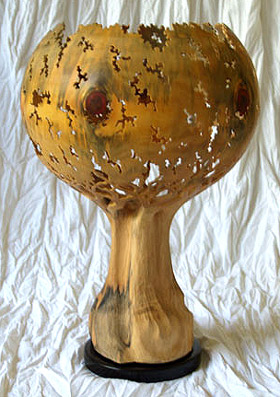
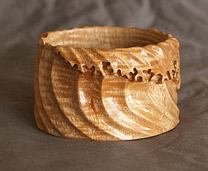
Curly mango.
2”H x 3.25”diameter
Norfolk pine.
17”H x 11.375”diameter
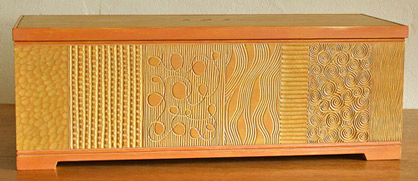
Hard maple, Port Orford cedar.
7.75"H x 21.75"W x 8.25"D
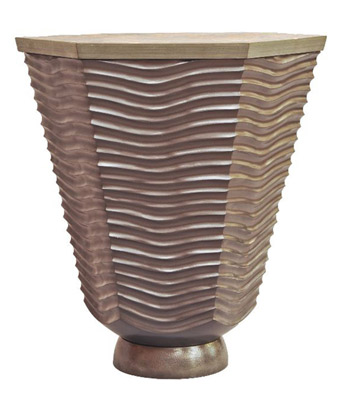
Pigmented maple, slate, peened and blued steel.
22"H x 20"W x 18"D
© Amiaga Photographers, Inc.
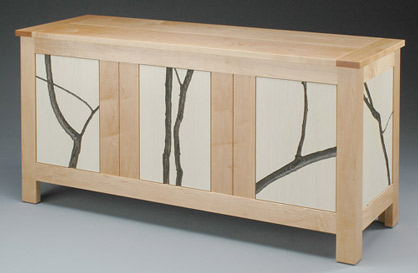
Maple, ash, stain.
24"H x 47"W x 16.5"D
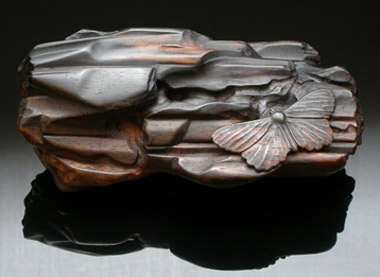
Gabon ebony.
3.6” x 2.1” x 1.3”
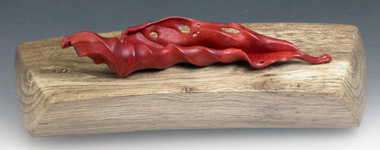
Leaf: Pink ivory wood, Stand: Persimmon.
Leaf: 3.1” x 0.6” x 0.4” / Tray: 4.25” x 1.6” x 0.6”
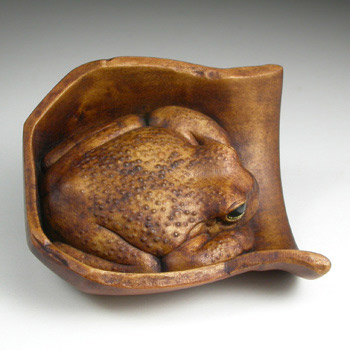
Boxwood, Baltic amber (eye inlay).
1.5” x 1.6” x 1”
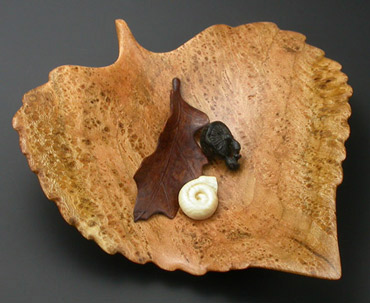
Cottonwood Treasure by JANEL JACOBSON
Cottonwood Leaf: Cherry burl.
Red Oak Leaf: Manzanita.
Tiny Mushrooms: Bog oak.
Snail: Mammoth tusk with boar’s tusk inlay.
3.3” x 3.1” x 1.2”
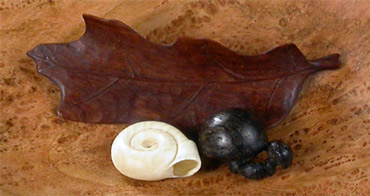
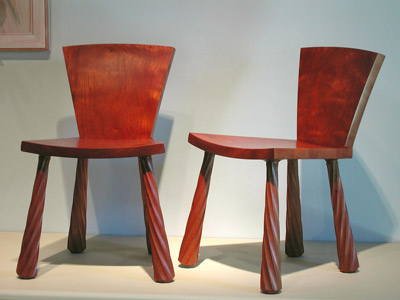
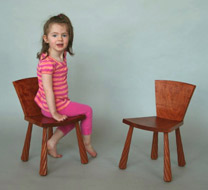
Cherry.
19”H x 12”W x 12”D
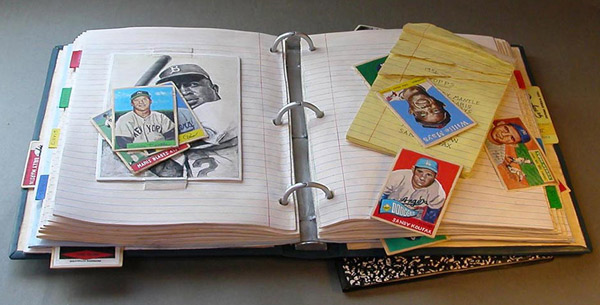
Pine, paint.
3”H x 21”W x 14”D
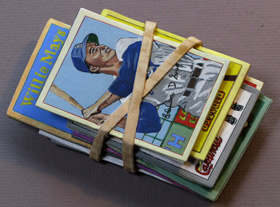
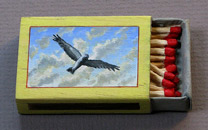
Pine, paint.
0.5”H x 2.5”W x 1.5”D
Pine, paint.
1.25”H x 3”W x 5”D
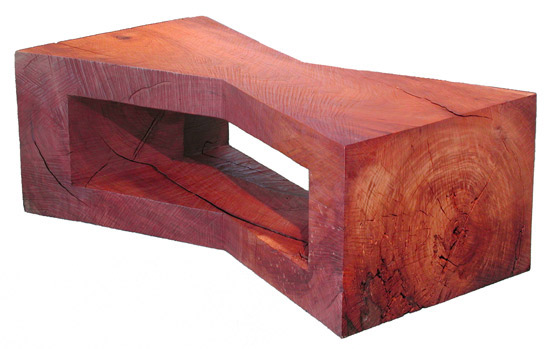
Cherry.
18"H x 4'W x 2'D
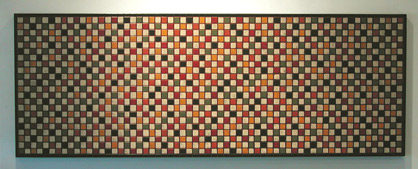
John Eric Byers contributed two Queen-sized headboards in carved mahogany. The multiple colors seem to animate the shallow relief squares.
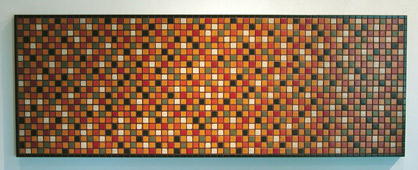
Mahogany, milk paint.
23”H x 63”W x 2”D (Queen)
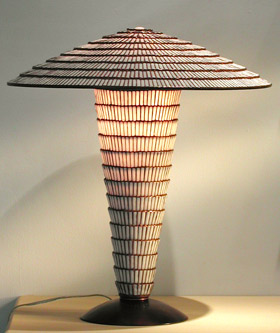
Hand-blown glass tiles, bronze.
21"H x 18.5"diameter
The Art Furniture of
JUDY KENSLEY McKIE
at LongHouse
2009
NOTES: Jack Lenor Larsen has been a long-standing fan of Judy McKie and her work. His 1994 tribute to her appeared in a Pritam & Eames catalogue, and included these lines: "Today, as we stand awash -- sometimes shoulder deep -- in an art world market-driven, ego-tainted, tongue-tied while near buried in words, the furniture of Judy McKie appears as a singular 'safe harbor'. McKie's stricture that her work remain furniture and functional may be a clue to its success, for this is not sculpture to sit on, nor art to warehouse. True, these pieces are also ritual objects going beyond function. Often bestial with four stout legs or with none, her house-broken menagerie makes maker and viewer smile, as intended."
In 2009, Larsen hosted a show of McKie's work at LongHouse, his East Hampton estate that is a foundation for the arts.
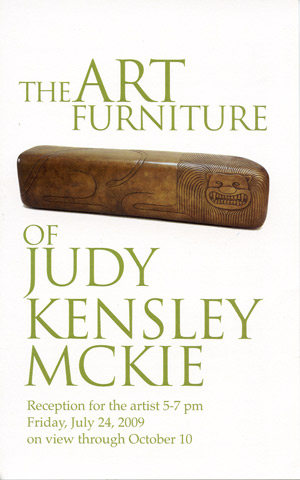
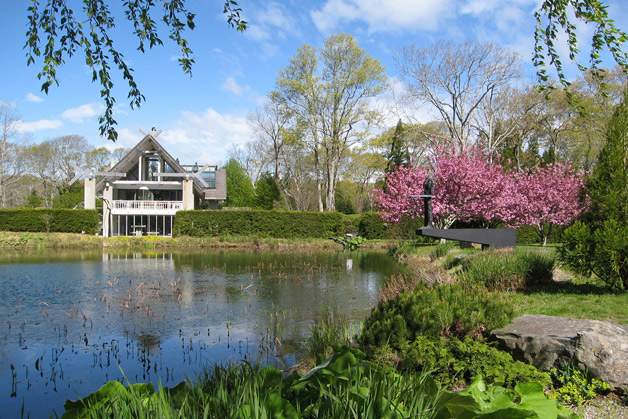
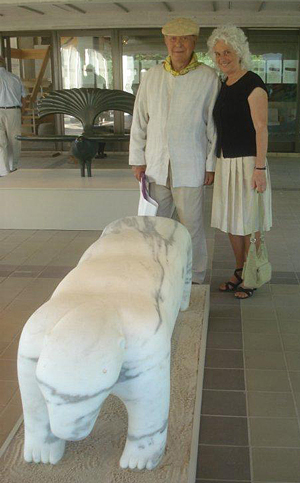
with Polar Bear Bench at LongHouse
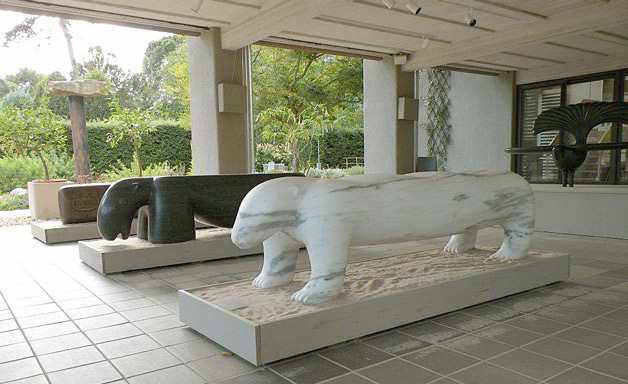
Danby marble.
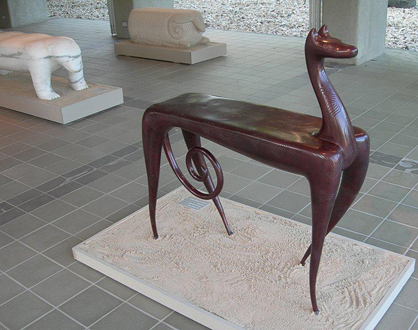
Cast bronze.
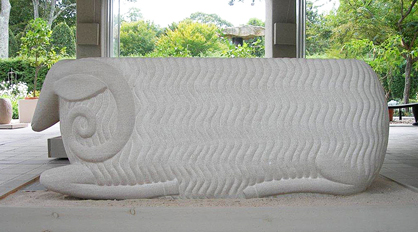
Limestone.
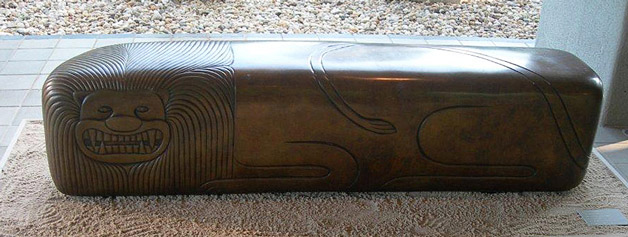
Cast bronze.
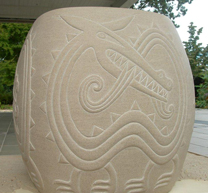
Indiana limestone.
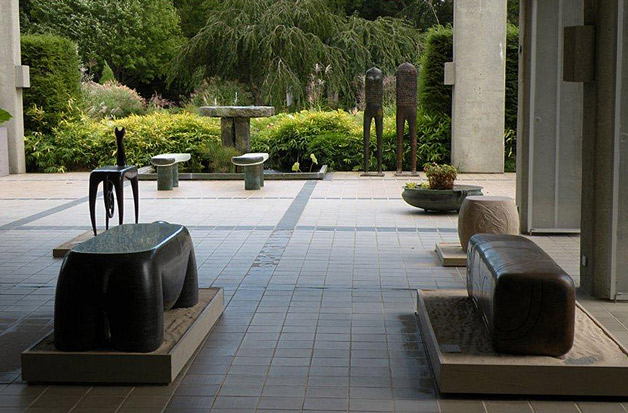
Champlain marble.
JULY 3 -- AUGUST 18, 2009
This show was dedicated to the memory of Ebner's dear friend and photographer, Gil Amiaga.
NOTES:The long stretch of the gallery’s association with David Ebner began with a 1980 visit to his studio in Bellport, NY, a visit that initiated a relationship that would extend for the life of the gallery. For the gallery’s opening in May 1981, Ebner arrived with his Wishbone Rocker (see P&E Archives, First Decade, 1981) propped up in the back of a borrowed sports coupe convertible. He had picked the rocker up from a local caner who had just completed work on the seat. The Wishbone Rocker was a perceptive, modern design that began with Ebner’s observing the rocking motion of a duck’s sternum bone on his plate in a Long Island restaurant. This rocker embodied the quality and kind of work that would attract a broad public to Ebner’s furniture and entice many to make their initial venture into American studio furniture. His sense of design has a broad reach and stays away from an approach that is overly personal and eccentric. For any movement to gain traction, it needs both rarity as well as the strength of a broader appeal.
In a sense, Ebner’s 2009 show at Pritam & Eames was a strong review of furniture chestnuts from his body of work. At this point, his career as a furniture maker had spanned four decades of productivity, and this prolific body of work included commissioned pieces that constantly pushed Ebner for new design solutions. During this period of productivity, he was able to make a number of pieces that would go on to be considered classics within his body of work. The 2009 show exhibited a number of these pieces.

Take, for example, his Chest of Drawers in Sapele. He came up with the design for this chest of drawers while he was still a student at RIT in the ‘60s, and it was there that he made the first version. The three-tiered structure, with its three volumes separated by a central column, was sculptural in its aesthetic but functional in that each volume housed a single drawer that decreased in size from the bottom up. Although over the years, he revised aspects of this design, he kept its essential nature unchanged. As such, it would do well in any modern architectural setting, while still providing an exceptional canvas for the organic figure of beautiful wood.
Quartered sapele.
44"H x 32"W x 22"D
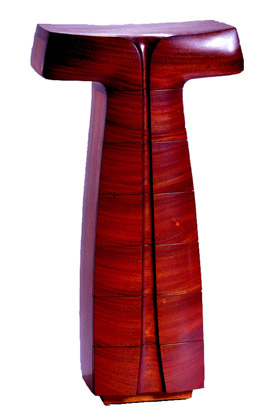
Figured mahogany.
45”H x 24”W x 16”D
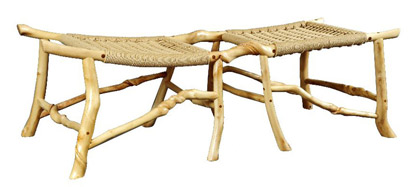
Sassafras, rush.
16"H x 48"W x 18"D
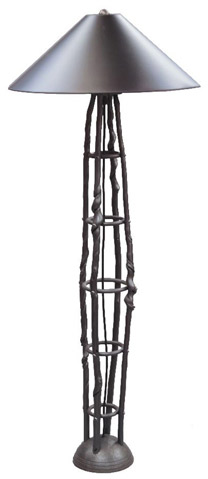
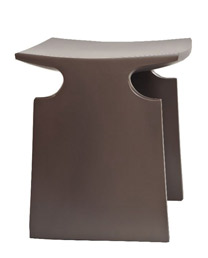
Stained sassafras, peened & blued steel.
54”H x 22”diameter
Pigmented maple.
16"H x 15"W x 15"D
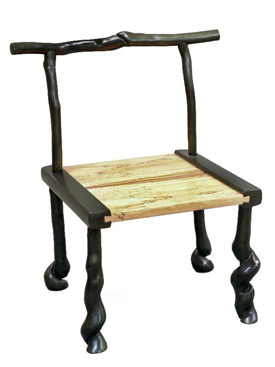
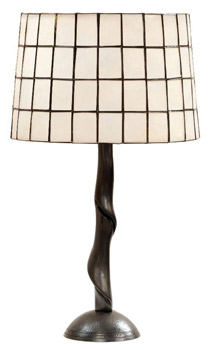
Pigmented sassafras, spalted maple.
25"H x 20"W x 16"D
Pigmented maple, peened & blued steel.
23"H x 12"diameter
With Ebner’s Brookhaven Chair one can also feel the influence of earlier Modernist designs; the chair is also not without a distinctly Esherick feel. What is interesting is to compare the structural thinking that went into the design of the chair with the Library Steps, and to note that the chair made its first appearance in the gallery in the early ‘80s, while the Library Steps did not appear until the turn of the century.
In both pieces, there is a wishbone-type joining as the feet continue into legs, and continue the upward moving curves to meet in a wishbone structure. In both pieces, the horizontal solid of the seat with respect to the chair and the horizontal solid of the steps with respect to the ladder provide the functional strength of a stretcher. The joining of the three legs on each side of the Library Steps is accomplished by a skillful use of tapered lamination. Its six legs provide stability and the necessary sense of security. The slight arching of the leg material, after the wishbone joint, provides an upward reaching surface to guide the hands of the climber, and offers continued security. This is an elegantly fluid structure, as well as a well-thought out design, from the user’s point of view.
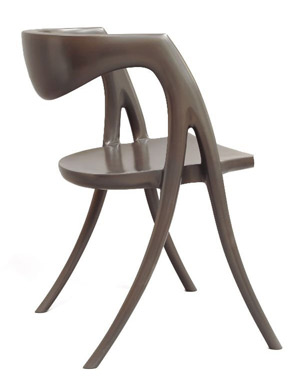
Pigmented maple.
30"H x 22"W x 18"D
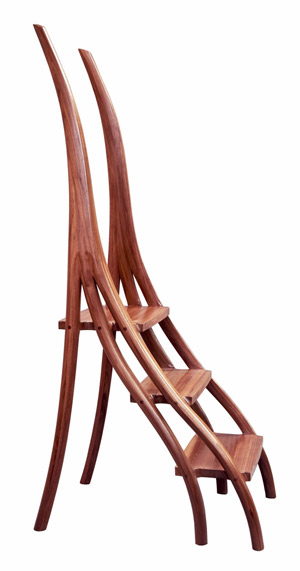
Brazilian cherry.
49"H x 19"W x 22"D
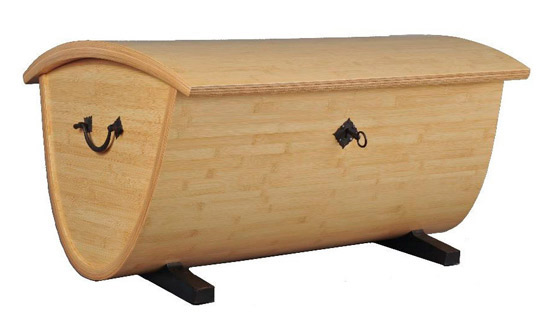
Natural bamboo.
20"H x 36"W x 28"D
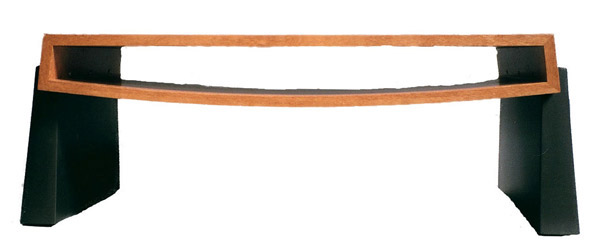
Coffee Table
Lacewood, pigmented maple.
15"H x 38"W x 20"D
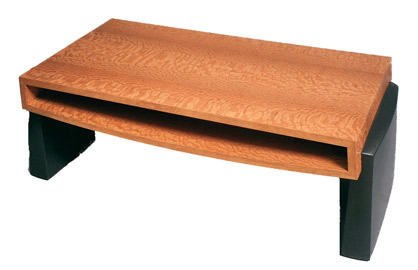
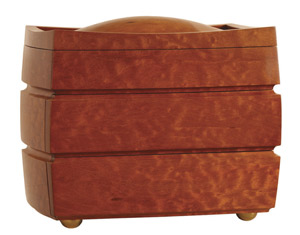
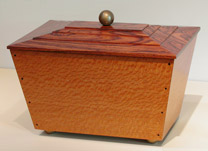
Figured mahogany.
13.5"H x 15"W x 9.75"D
Rosewood, lacewood, Spanish cedar.
9.5”H x 13.25”W x 9.25”D
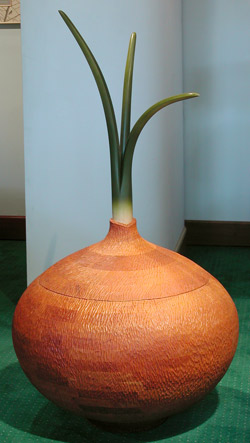
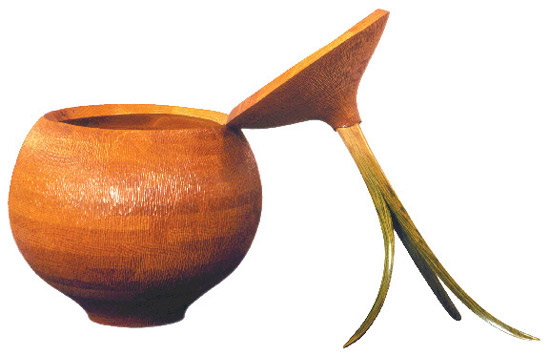
Red oak, ash.
54”H x 28”diameter
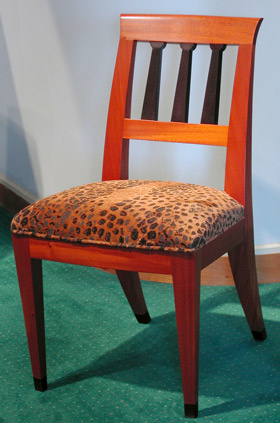
Figured mahogany, wenge, Larson fabric.
33”H x 19”W x 20”D
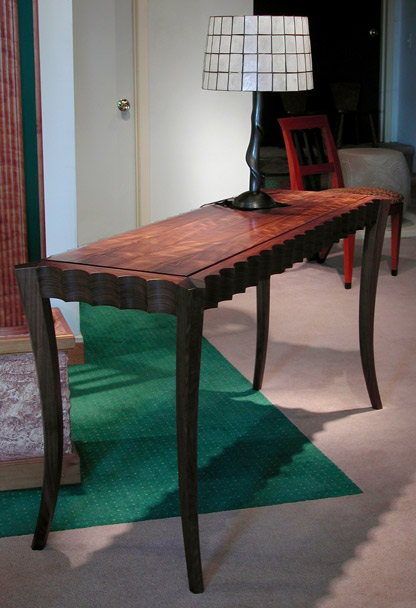
Walnut.
30”H x 58”W x 22”D
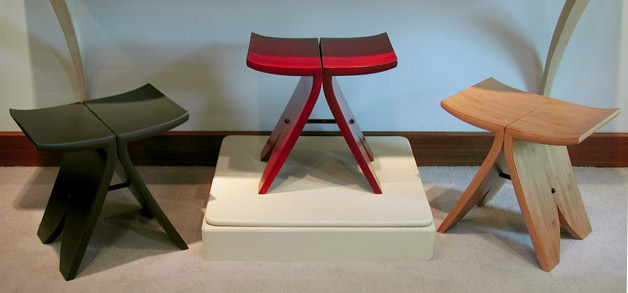
Bamboo, blued steel.
17”H x 17”W x 13”D
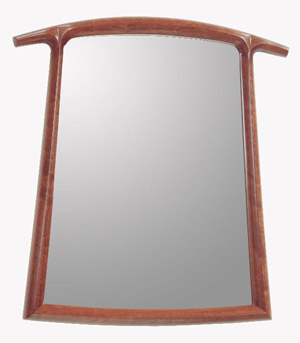
Bubinga.
23.5”H x 21.5”W x 1.5”D
All Ebner Studio Photos: © Amiaga Photographers, Inc.
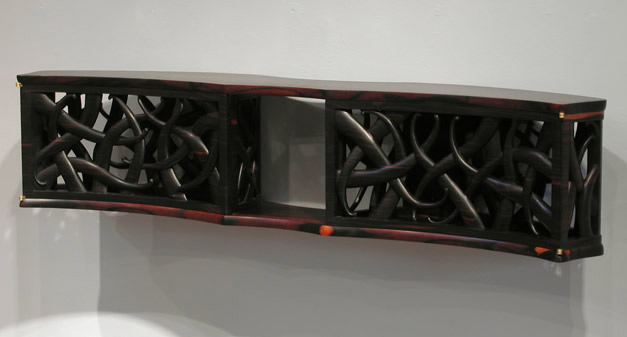
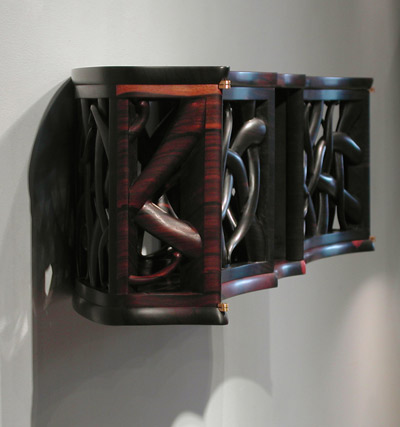
Another wall-hung cabinet by Brian Newell that exhibits his great talent for three-dimensional decorative carving. Note how the ends of the cabinet curve away from the wall, which allows back lighting to accentuate the cabinet's transparency. Also, of note, is the commitment it took to use solid ebony boards for his carving blanks.
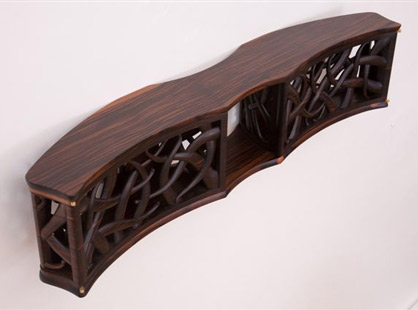

9.5"H x 42"W x 7"D
2010 EARLY SPRING SHOW
March 19 – May 25
TED BLACHLY & PETER BLOCH MICHAEL CULLEN, DAVID EBNER, GARY MAGAKIS, GREG SMITH, FRAN TAUBMAN
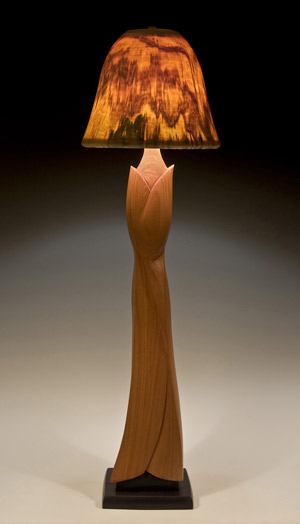
Mahogany, wenge, quaking Aspen
65"H x 16"diameter
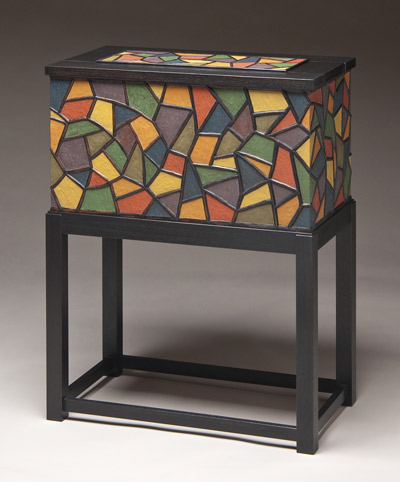
Carved and painted mahogany, Spanish cedar interior
32.25"H x 24.625"W x 13.75"D
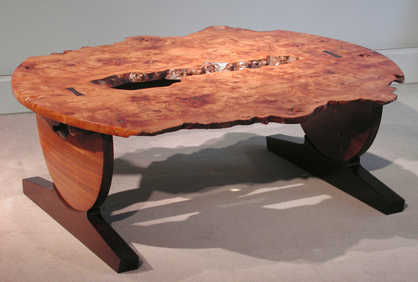
Elm burl, walnut, wenge, peened & blued steel.
16.5”H x 37”W x 43.5”D
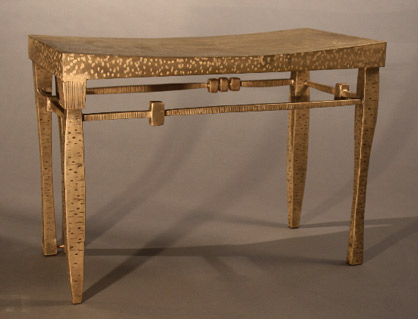
Bronze.
20"H x 28"W x 14"D
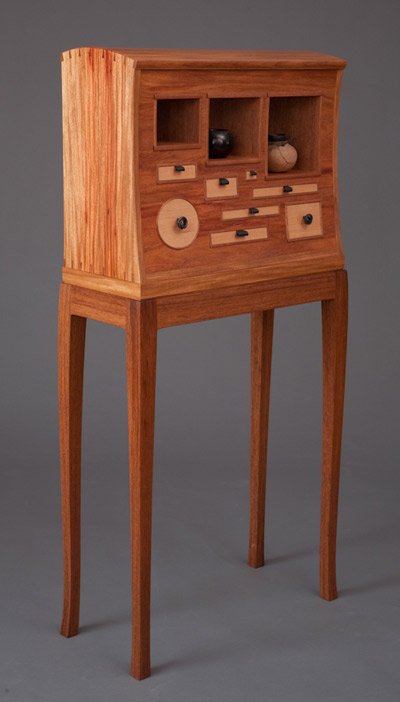
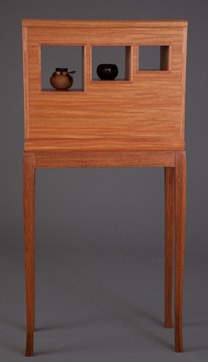
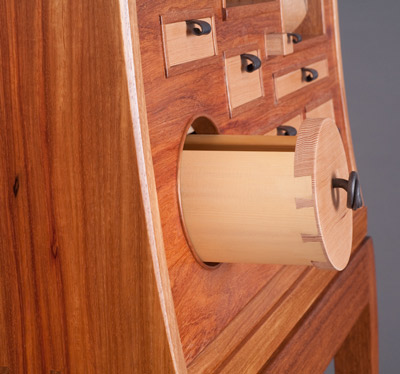
Narra, kwila, Douglas fir, nutmeg, maple, iron.
52"H x 25.25"W x 11"D
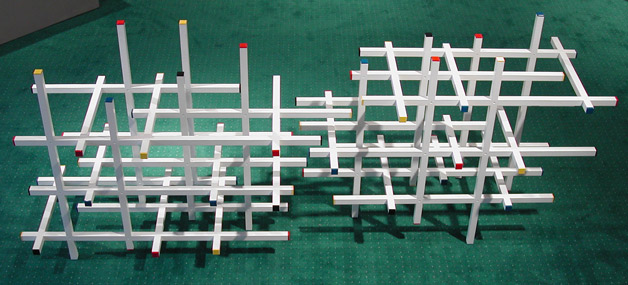
Powder coated aluminum.
30"H x 79"W x 21"D
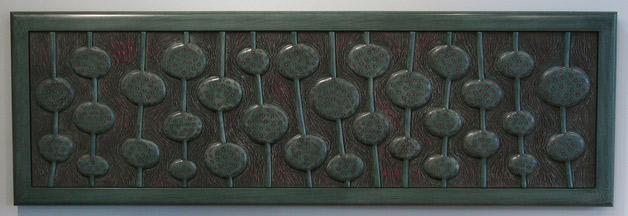
Mahogany, milk paint.
22”H x 67.5”W x 1.5”D
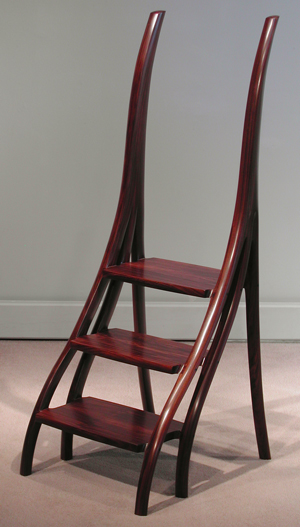
ANDY BUCK . DAVID EBNER . THOMAS HUCKER . MICHAEL HURWITZ . WENDY MARUYAMA .JUDY KENSLEY McKIE . DON MILLER . BRIAN NEWELL . ZIVKO RADENKOV . RICH TANNEN . WILLIAM WALKER . HOWARD WERNER
NOTES: In 2010, The New York Times art critic, Roberta Smith, stated: “What is missing is art that seems made by one person out of intense personal necessity, often by hand.’* To Smith’s remark, we offer the studio furniture field as an apposite reminder that furniture, in the hands of these makers, is rich in the very way that she senses is absent in contemporary art.
*Roberta Smith, The New York Times, Post-Minimal to the Max, Arts & Leisure, pg. 1, February 14, 2010
In Andy Buck’s Headboard, he uses his usual technique of relief carved figure to create a gathering of like, but individualistic, forms waving gently like sea plants. The muted sea green colors add to this underwater effect.
Already a well received design, the Library Ladder by David Ebner appears this time made from East Indian rosewood.
Tom Hucker’s Illuminated Cabinet, almost seven feet tall on its spare, squat base, has the feel of a Japanese lantern. It is a feat of both craftsmanship and design that, at this scale, he created a sufficiently rigid structure to house a series of broad glass shelves. Lighting was provided both by interior strip lights that ran vertically inside the corners, and also by ambient light from outside passing through the laminated rice paper skin.East Indian rosewood.
49”H x 19”W x 22”D
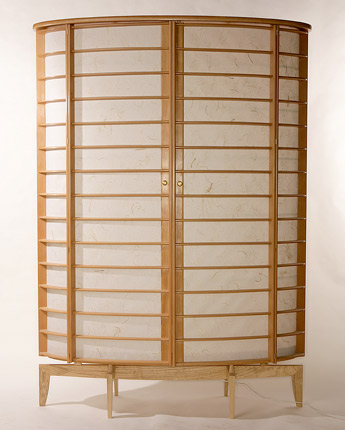
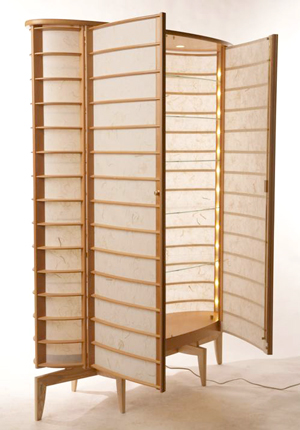
Douglas fir, synthetic rice paper, LEDs.
82”H x 56”W x 21”D
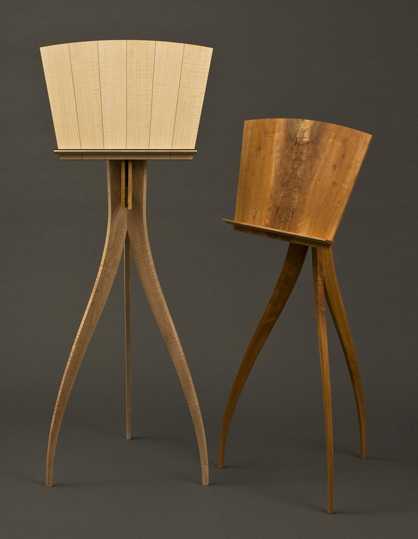
The two music stands in this show came from Michael Hurwitz. The detail image shows the design’s ability for height adjustment. In the curly maple version, its form is set off by crisp ebony lines. Both the zelkova and curly maple versions make use of Damascus steel in the stands’ hardware for height adjustment. Early on, Hurwitz had apprenticed with a musical instrument maker.
Music Stands by MICHAEL HURWITZ
Curly maple, ebony / zelkova;
Damascus steel.
46-55”H x 21”W x 21”D
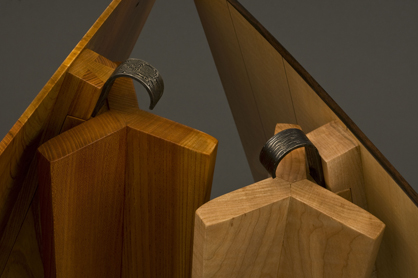
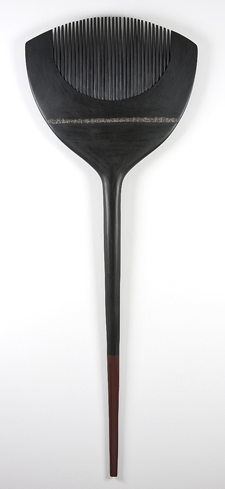
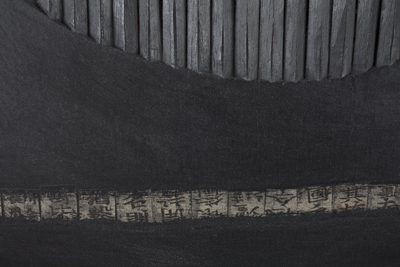
Kanzashi Hair Ornament by
WENDY MARUYAMA
Carved & painted Jelutong, paper.
60”H x 18”W x 3”D
Wendy Maruyama’s comb was inspired by Kanzashi or hair ornaments worn by geisha or women at tea ceremonies and weddings. Here the comb is scaled up to the size of a human figure. The light band, running below the teeth of the comb, is created from a paper mache band with kanji.
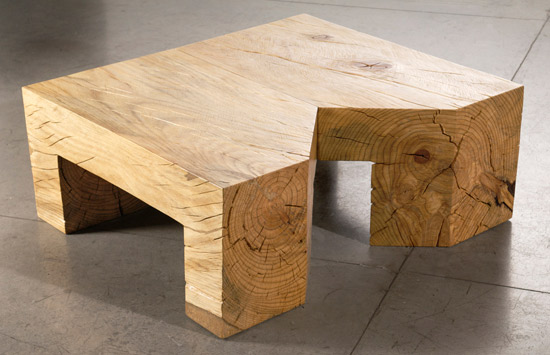
Pine.
19”H x 40”W x 31”D
Howard Werner, well-known for his fine sculptural chain saw carving, has also made a strong use of hard edged geometric forms in his work. This low table made of pine is formed by two adjoining, identical members. They are mirror opposites and can be adjoined on any of their five vertical facets.
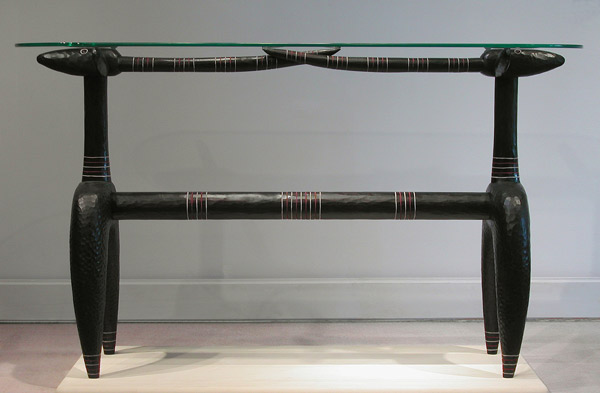
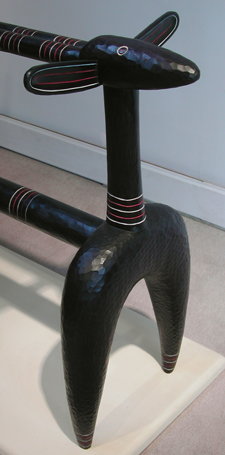
The Gazelle Table from Judy McKie was originally conceived in the early 1980s. At that time, she roughed out parts for several more of the edition, which were finished over the subsequent years. The table strongly suggests primitive animist work. The upright, sentinel position of the forequarters lends the piece its presence. McKie has often used “twinship” in animal form to create a symmetrical whole but also to raise to guardianship an animal form. Here the use of carved and colored bands to embellish the forms also adds to the heightened presence of this animist rather than animal form.
Mahogany, paint, glass.
34”H x 60”W x 18”D
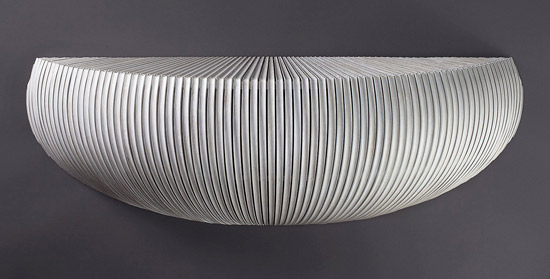
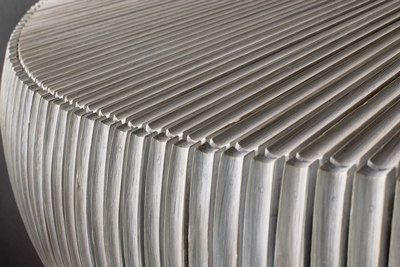
Four pieces by Don Miller show well the range of his thinking on the form and pattern created by skeletal and surface piecing. Starting with his wall-hung demilune, and looking at it structurally, each horizontal surface member is supported by an arched rib joining in the belly of the piece with a result of lightness and strength. Pattern-wise, each piece doubles as a perspective line converging at the edge of the plane. It is easy to understand how helpful an advanced computer design program would be in figuring out the shape of an individual piece. This is what Miller did. His mirror uses similar design thinking but adds a more playful aspect. It is human nature to glance at a mirror when passing. Here the form of the piece is infused with mirror reflected light which ripples with shadow effects as one passes. The Eggo wall vessel is the third piece that fits into this design thinking. Here form is used non-functionally; it makes you think of a spirit or energy hole but also brings to mind that Miller worked with musical instruments earlier in his career. In the fourth piece, his Tea Table, east meets west. A familiar pedestal design is partnered with a fan-pieced top. The graphic of the top suggests both a chrysanthemum form as well as the sun.
Bleached white oak.
16”H x 40”W x 12”D
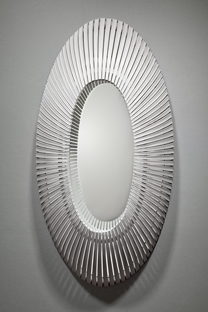
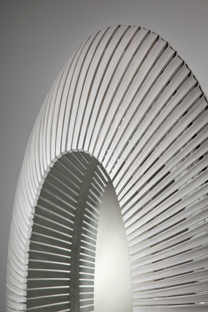
Bleached white oak, mirror.
27”H x 14”W x 4”D
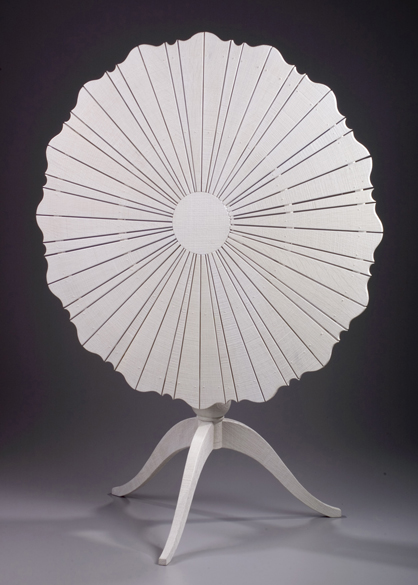
Bleached white oak, brass.
28”H x 32”W x 32”D
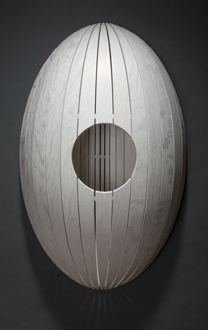
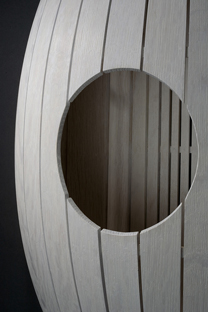
Bleached white oak.
31”H x 18”W x 7.5”D
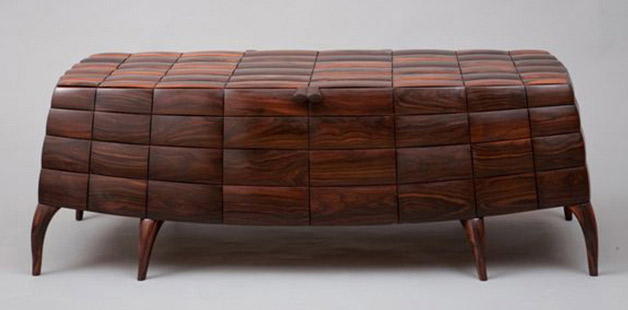
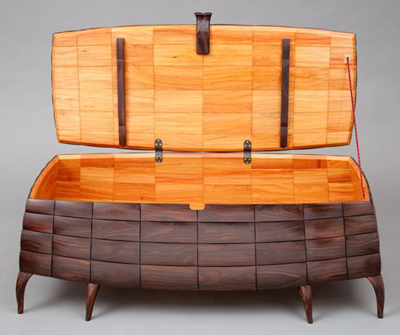
In a 2007 show, Brian Newell created a blanket chest that was rectilinear in form whose surface was covered by pillowed tiles of African blackwood. That chest featured a base of many legs. For the blanket chest in this show, he bellied out the front and back of the form, curved the sides and canted them towards the top, and used eight legs at the base to raise the structure.
These legs gave the entire carcass the sense of an arthropod on the verge of moving.
Macassar ebony, narra, Japanese cypress.
18”H x 51.5”W x 22.5”D
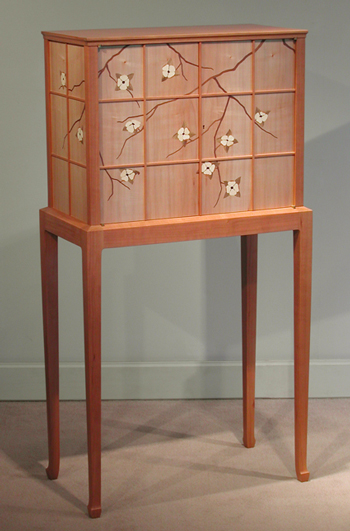
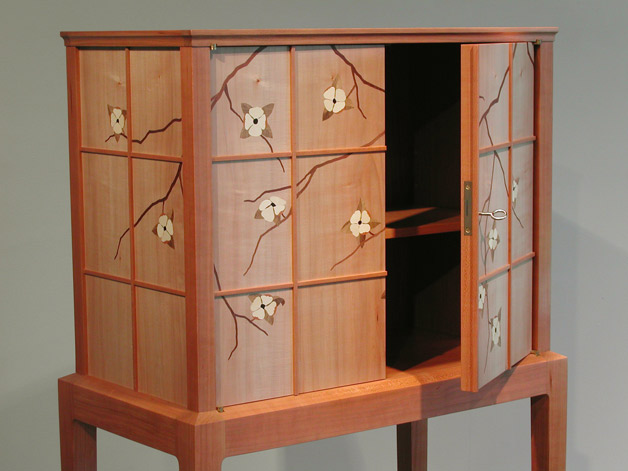
Cherry, soft maple, walnut, holly, myrtle, pearwood, ebony.
53”H x 27.5”W x 14.75”D
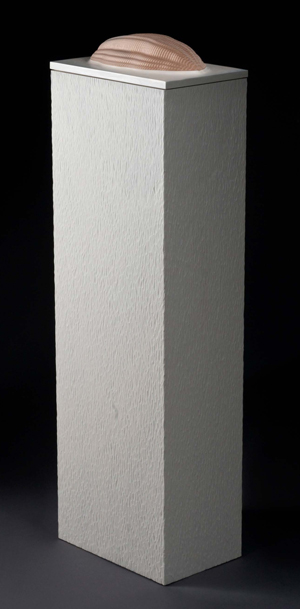
Rich Tannen’s maple milk-painted Container transforms a textured undulating surface into a three-dimensional form. Its asymmetric form is overlaid with precise rhythmic texturing. Like some forms found in nature, while externally free and irregular, they are built on a foundation of precise mathematical internal structure.
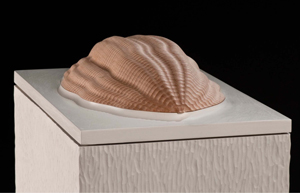
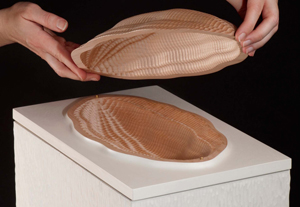
Maple, milk paint.
41”H x 13”W x 8.5”D
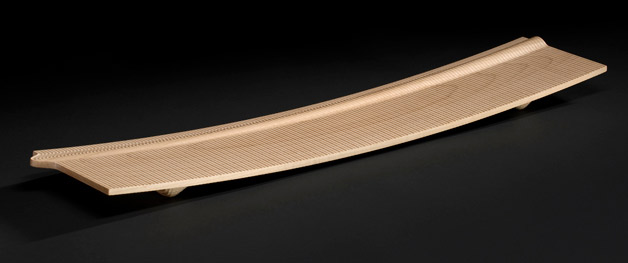
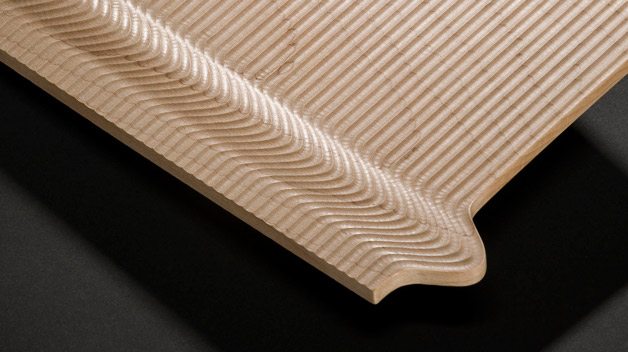
Maple.
1.25”H x 28.5”W x 6”D
THE LOOKING GLASS
JULY 2 -- AUGUST 3, 2010
ANDY BUCK, TIM COLEMAN, DAVID EBNER, DON MILLER
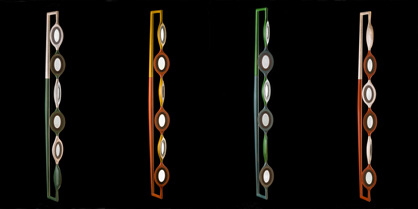
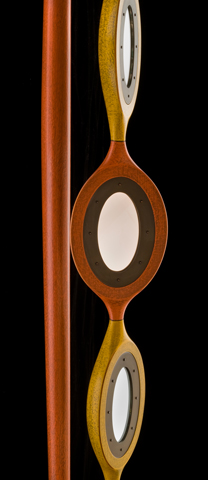
Mahogany, milk paint, steel, mirrors.
48”H x 4”W x 6”D
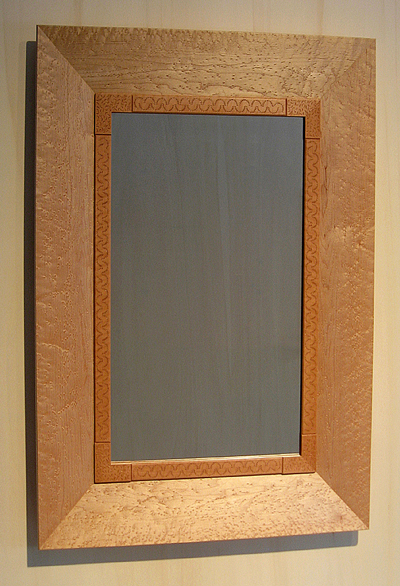
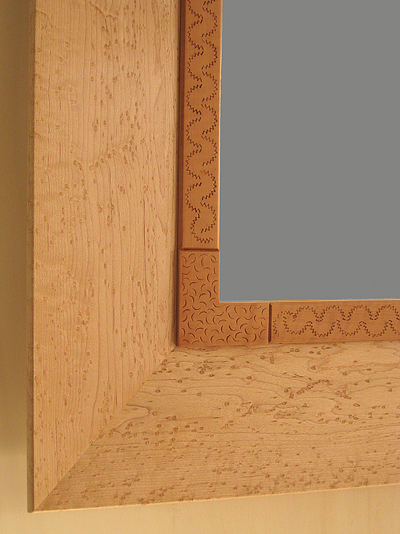
Bird's-eye maple, pearwood.
32”H x 24”W x 2”D / 24"H x 32"W x 2"D
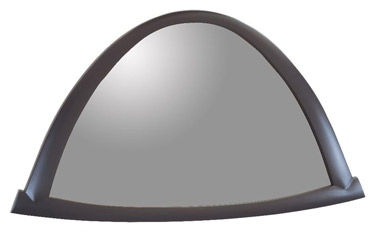
Pigmented bamboo.
25”H x 44”W x 2”D
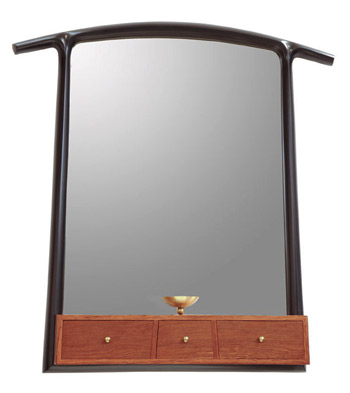
Pigmented maple, bubinga, brass.
32”H x 29”W x 4”D
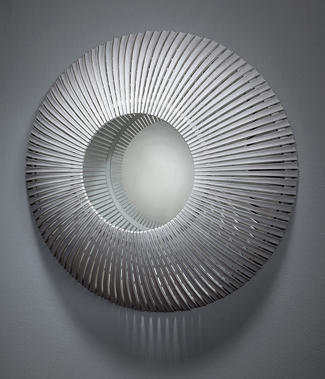
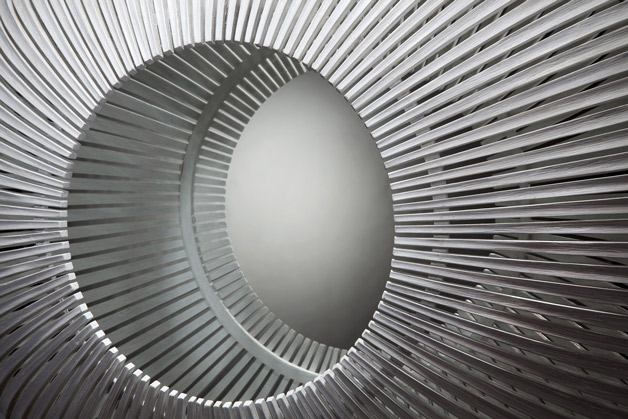
Bleached white oak.
21"diameter x 5.5"D


Bleached white oak, mirror.
27”H x 14”W x 4”D
SEATING @ Pritam & Eames
Chairs, Benches, Stools
August 6 - September 7, 2010
VIVIAN BEER . GARRY KNOX BENNETT . DAVID EBNER . MICHAEL HURWITZ . TIMOTHY PHILBRICK . JAMES SCHRIBER . HOWARD WERNER
NOTES: There were a number of exciting seating pieces that arrived for this show, starting with Vivian Beer's Ruby Red Slipper Bench.
Ruby Red Slipper was the first piece by Vivian Beer to be exhibited at P&E. Beer's father was a Maine boat-builder, and she had plenty of practical experience in the boatyard that gave her choice to bend and weld sheet steel into furniture forms, a rational base. That her slipper form has the fluidity of poured resin is still a thing of wonder, and shows the confidence of an artisan whose apprenticeship included working on parts for Jeff Koons’ sculptures. The gratifying sculptural aspect of her “slipper” is that it pours itself into the terminal of a cubist block, which anchors nicely the activity of the dancing form. Ruby red and black are essential to this bench.
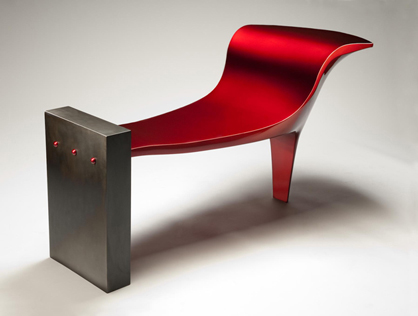
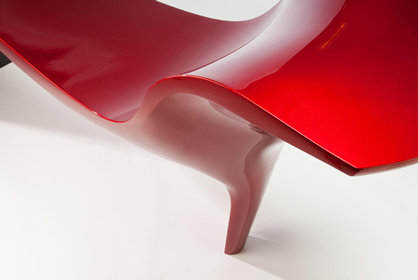
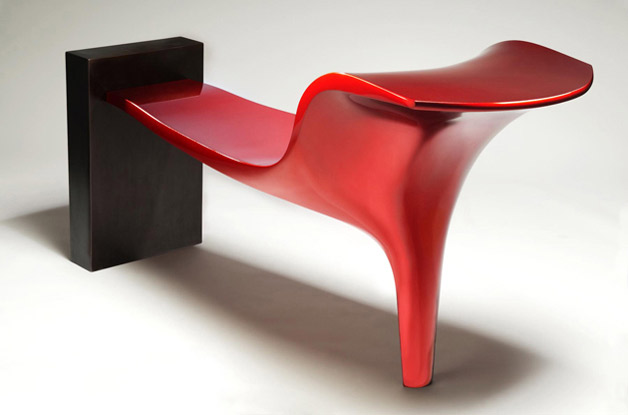
Steel, automotive paint, patina.
36”H x 52”W x 26”D
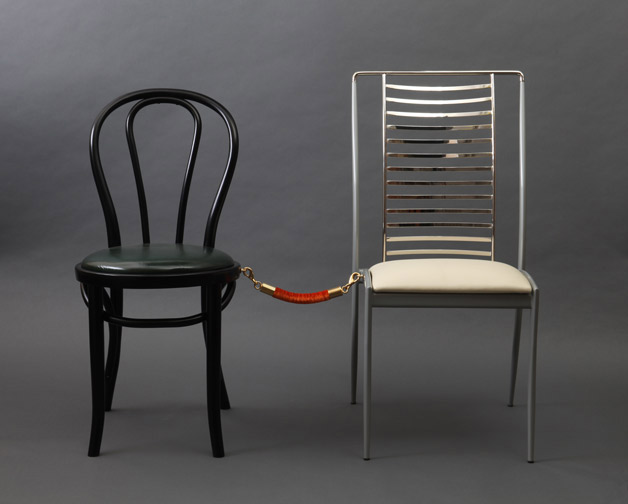
Reclaimed & refurbished pre-used chairs, powder coat, nickel plate, paint, leather, Naugahyde, velour, 23K gold plating.
36”H x 45”W x 22”D
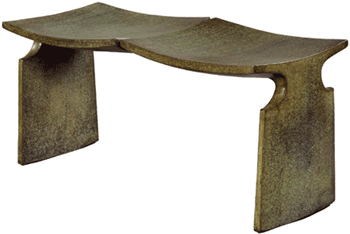
David Ebner is well known for his Renwick Stool, and it was this piece that he later extended into a two-seater bench design that was also originally fashioned from wood. Ebner correctly saw how well this design could translate into bronze. The bronze allowed him to work with less thickness through the bottom of the seat. This is a piece that would sit harmoniously in almost any landscape.
Ebner’s Bellport Bench and chairs are successful updates of Edwin Lutyens’ (a prominent early 20th century British architect) classic garden furniture designs.
Cast Bronze.
16”H x 36”W x 16”D
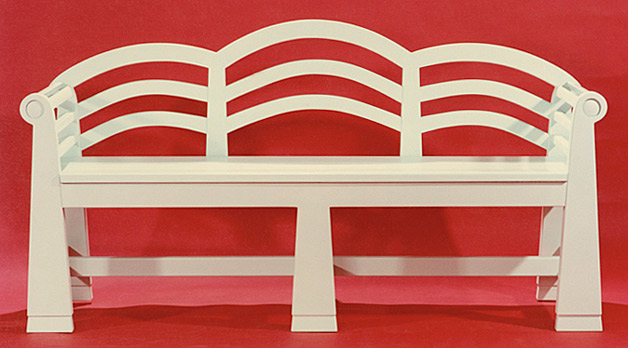
Mahogany, paint.
33”H x 60”W x 20”D
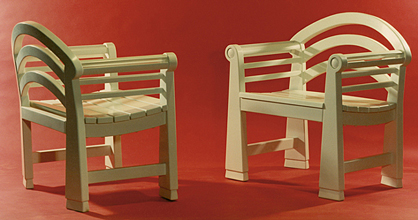
Mahogany, paint.
31”H x 30”W x 21”D
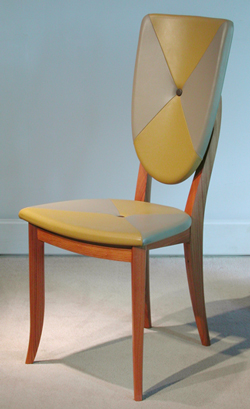
Michael Hurwitz uses the shield shape as an element of design in the back of his chair. However, the back is sufficiently narrow that this form appears in an elegant way, and is embellished on the sitting side by a subtle graphic that uses two closely related tones of mustard and taupe leather. The chair’s width is projected to the front edge of the seat, which in characteristic Hurwitz manner, gives it a welcoming gesture.
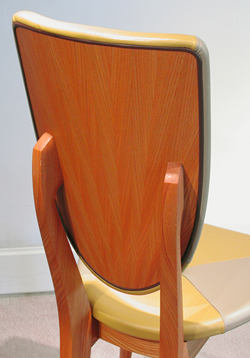
Zelkova, Spinneybeck leather.
39”H x 18”W x 21”D
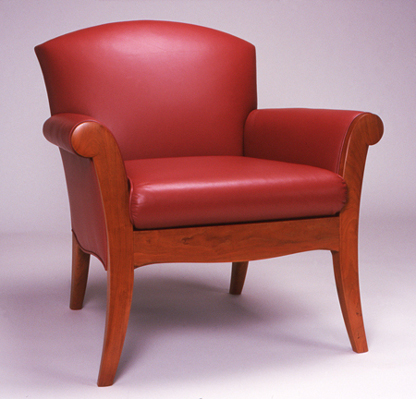
Tim Philbrick’s Reading Chair owes its lineage to a long line of his club chairs and yet is distinctly different in scale. While taller backs and more ample seats have been the tradition, Philbrick’s Reading Chair is modern in that its agreeable proportions and perspective lines give it all of the appearance of comfort. Its scaled-down dimensions make it easily moveable within a room and, in this way, adjustable for conversation. Although larger versions of Philbrick’s easy chairs have been an exhibition attraction for many years, the particular scale of this chair, as well as the choice of Claro walnut and burgundy-colored leather, was a particularly effective combination. He had sufficient walnut, which appears in the front apron, to make this chair three times.
Philbrick also exhibited a side chair in Claro walnut whose lines are masterfully resolved. It has a simplicity that would allow it to sit well with most tables and desks, and also the comfort of a traditionally upholstered seat and back.
Claro Walnut, Spinneybeck Italian calfskin.
32”H x 29”W x 27”D
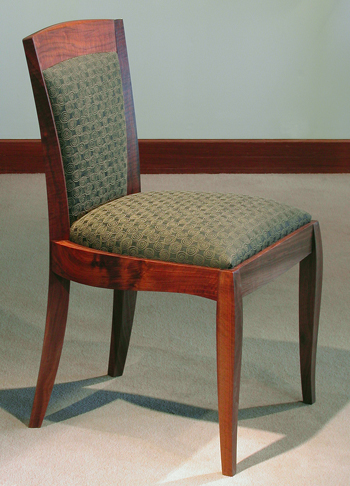
Claro Walnut, Larsen fabric.
33.5"H x 19.5"W x 20"D
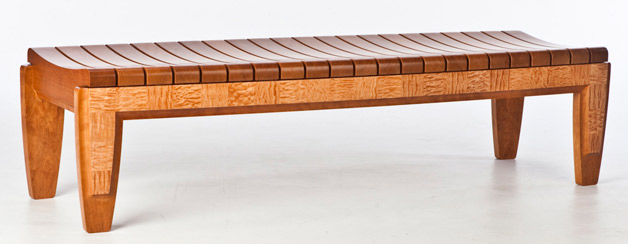
Cherry, Quilted Maple.
17”H x 66”W x 22”D
The five and one-half foot long wooden bench by James Schriber was a shortened version of a bench originally designed for public seating at a Yale University hospital. The slat-style cherry members of the bench’s top are nicely shaped for comfort, and the figured maple overlay on the long apron and legs effects an elegant style that goes well beyond the demands of public seating. This shortened version would make an entry way piece, but would also look quite in place at the foot of a bed. Viewed from above, the bench's long sides are slightly bowed as on a kayak.
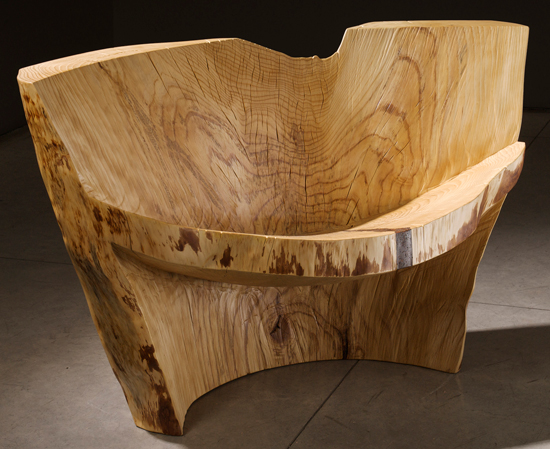
Pine.
29”H x 60”W x 23”D
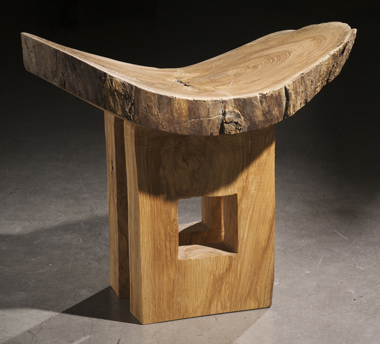
Ash.
26”H x 30”W x 21”D
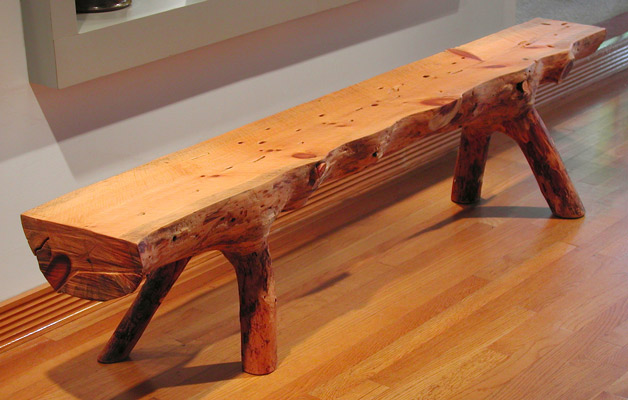
White Pine.
16.5”H x 72”W x 15”D
NOTES: Of the two pieces completed by Kristina Madsen in 2010, the queen-size bed was presented in exhibition, while the cabinet-on-stand was a commissioned piece. The bed was framed by its four posts, most of its curved surfaces covered by Madsen’s signature intaglio carving. Although this was not the first time Madsen applied her shallow-relief carving to surfaces in the round (see P&E Archives, Decade 2, Grasshopper Chest, 1995), the posts on the bed were the largest turnings she had carved. Normally, Madsen would begin her exploration of a pattern to be carved by making tests on flat wood panels, roughly a foot in width. However, in the round, there are no discrete beginnings or end. Knowing that continuous patterns are the norm on pottery, she consulted a potter who gave her the tip of cutting her paper patterns in half so that she could move it side to side and thereby ensure that the pattern flowed around. Eventually, though, she would have to explore the carving of this pattern in the flat. In the posts, lines that would appear horizontal on a tapered column would curve when made to lie flat on a plane.

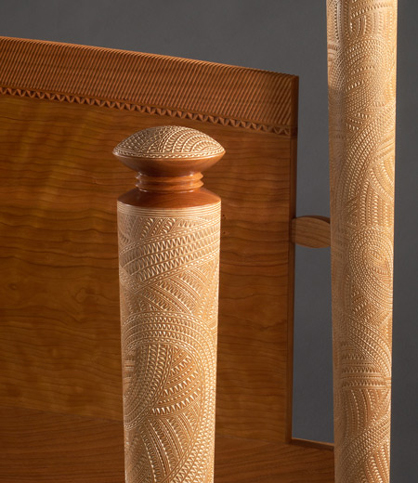
As you can see from the close-up of the tapered post, Madsen’s chosen pattern was dense with detail and complexity of curve. The tops of the posts are carved pattern on the gentle swell of the surface much like an elegant button. What gives the posts an exotic feel is their inverse progression; that is, from the bottom up, the thickness goes from narrow to thick. This interrupts our most normal design expectations and, in this piece, leaves a sense of surprise and wonder. Note that on the headboard, the carving is not deepened by the use of gesso, and sways away from the center like a wheat field divided by a parting gust.
Cherry, gesso.
56”H x 86”L x 66”W (Queen)
Before she started carving, Madsen sealed the bubinga with varnish. Once carved, she scrubbed in the gesso, wiping it off of the top surface with a damp rag. Once the gesso was dry, she lightly sanded the surface and applied a couple of more coats of varnish. The gessoed background helps to lift up/set off the primary pattern, which creates the illusion of greater dimension than actually exists.
This visual depth is enhanced by applying dark brown gesso to the more complex background patterns. While the top-most pattern is composed of simple sickle shapes in bubinga, the pattern beneath is developed with curved lines and tooth-textured, ribbon-like sections. The syncopated activity of the different levels gives an illusion of endless action. The legs of the cabinet-on-stand were made to look like they were turned, but because of their gentle curve, had to be shaped round by hand.
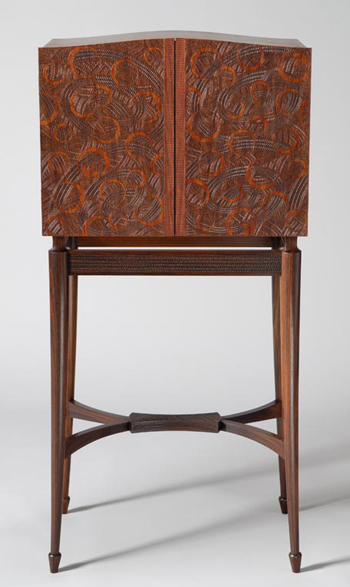
Madsen’s choice for the interior, which is composed of drawer fronts, is bold and acts like a jazz riff to the serious melodic composition of the exterior. The drawer fronts are made of alternating stripes of rosewood and maple.
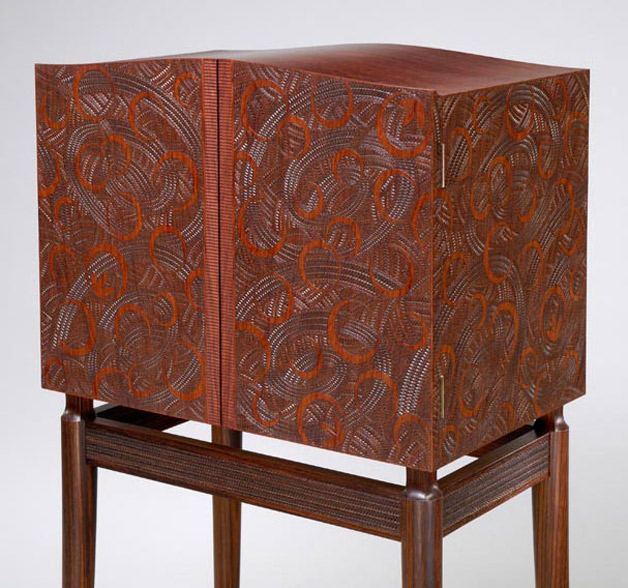
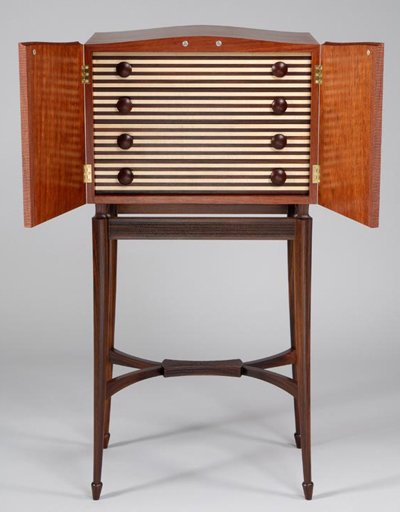
Bubinga, Indonesian rosewood, maple, gesso, silk.
47.25”H x 22.5”W x 14”D
Photos: David Stansbury
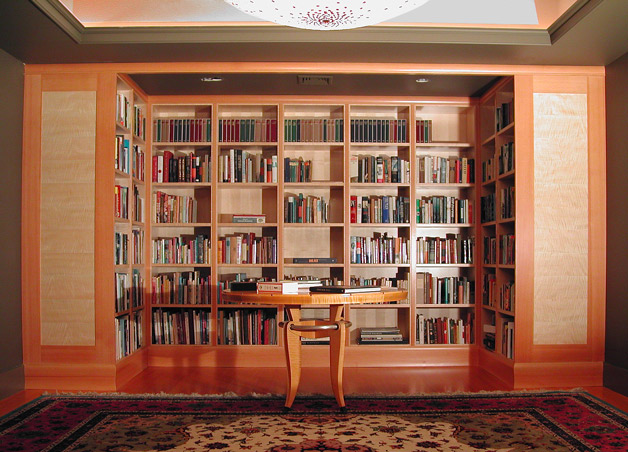
Maple, fir.
This “pocket” library was commissioned of James Schriber as part of a complete renovation -- design as well as structure -- of a traditional house on Shelter Island, NY. The re-design carefully adopted architectural elements that would blend into the company of its traditionally styled neighbors. In this way, this library unit also reflects elements of the new and the old. This is another good example of how Schriber’s talents allow him to absorb the environmental circumstances in a space, and come up with a specific design. The clients had also admired a late-1980’s circular library or foyer table of Schriber's that they had seen at the gallery. It has the neo-classical sense of a Deco design with silver leaf and ebony details.
NOTES: Despite the differences in their training backgrounds -- Fran Taubman came from RISD and Pratt Institute, and Vivian Beer trained at Portland College of Art and Cranbrook Academy of Art -- there is some common ground these two artists share. Both are working in painted steel: Taubman using rods, and Beer, sheet metal, to create their seating pieces. While sinuous curves have become Beer's signature, Taubman's Blue Chair represents a return to her more organic art nouveau botanical forms than to the more spare geometry of her current steel bar and plate work.
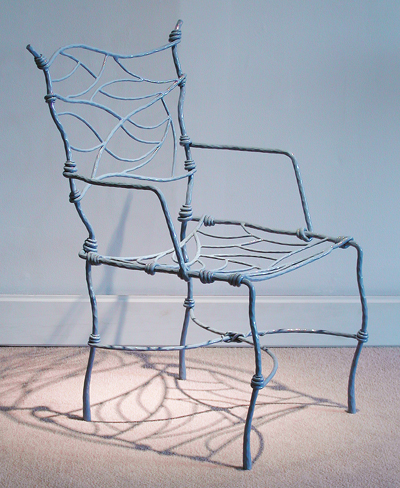
Edgar Brandt, the early 20th century French ironworker, was a formative inspiration for Fran Taubman in her work. Because of the Art Nouveau period of Brandt’s work, the flora muse was still strong, and this same organic element found its way in Taubman’s pieces, such as her well received Branch Lamp and her series of chandeliers and sconces. More recently, she experimented in a more modernist vein with both the chaotic nature of bent ribbon work as well as the rectilinear severity of steel bar stock construction. This beautiful chair is a return for her to the muse of the earlier period—twisted vines and branch patterns. With this style, the hammered exterior texture of the steel stock is meticulously rendered with the forging process. The joints on this chair are made secure by the three or four vine twists around a thicker member. The pattern of the back and seat itself will have a sense of familiarity to anyone who has worked with a wisteria in their garden. The chair is lithe, beautiful in its blue powder coating which does not hide or subdue the forged texture underneath, and actually provides a comfortable seat. Additional comfort is easily achieved with a thin canvas throw cushion.
Powder coated steel.
35”H x 18”W x 18”D
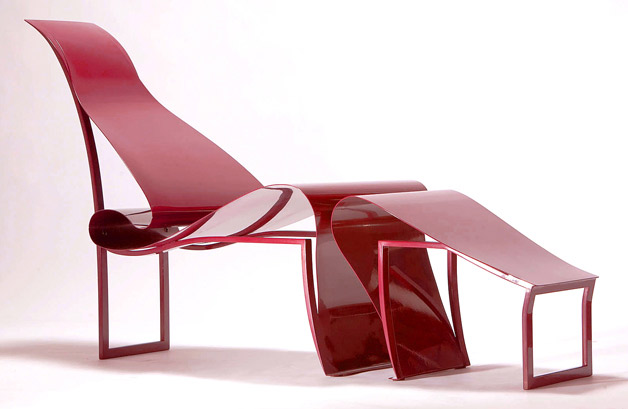
Steel, automotive paint.
33”H x 57”W x 21.5”D
30th ANNIVERSARY SHOW
Pritam & Eames marks its 30th year as a showcase for American studio furniture in a show that runs from May 27 - September 6, 2011
Vivian Beer, Fran Taubman, Tim Coleman, Brian Newell, Andy Buck, Wendell Castle, Judy Kensley McKie, Michael Hurwitz, Wendy Maruyama, Tom Hucker, Timothy Philbrick, John Dunnigan, Duncan Gowdy, Kristina Madsen, David Ebner, Hank Gilpin, Alphonse Mattia, Richard Scott Newman, and James Schriber.
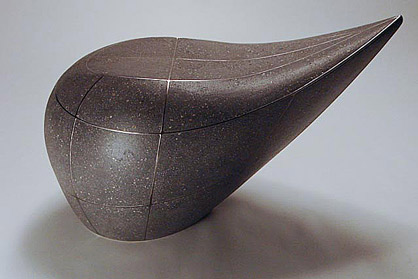
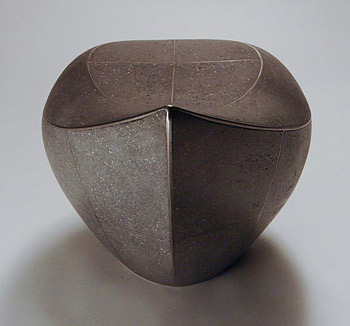
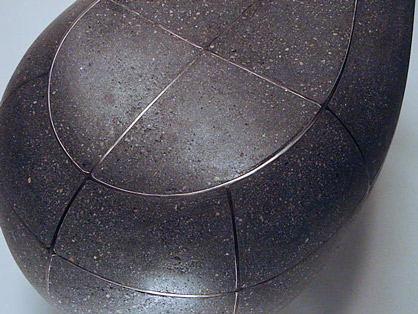
Stainless Steel, pure pigment and ferrocement (cement).
25"H x 40”W x 24”D
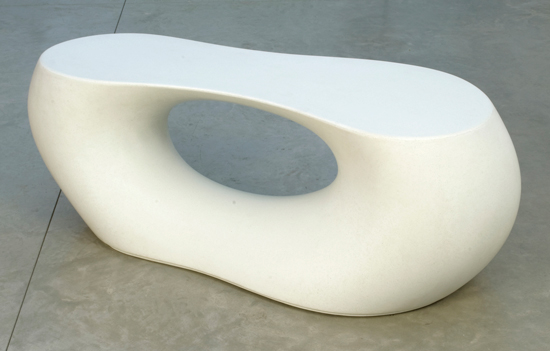
Polished concrete.
18.5"H x 55"W x 24"D
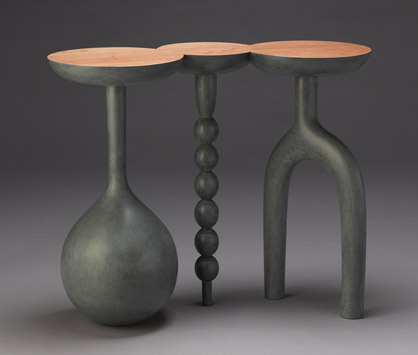
Poplar, cherry, paint, graphite.
31"H x 40”W x 16”D
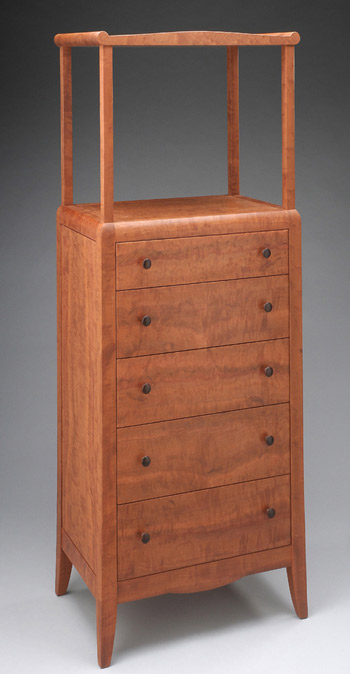
Figured makore; Drawers: Soft maple with eucalyptus bottoms, Brazilian rosewood pulls.
57.5"H x 23.5"W x 17"D
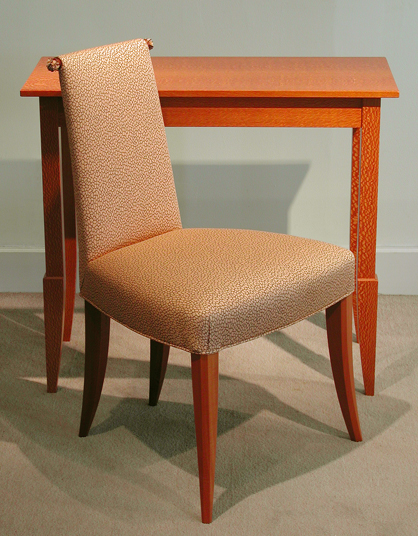
Lacewood.
29”H x 33”W x 15.5”D
Cherry, fabric.
34”H x 21”W x 20”D
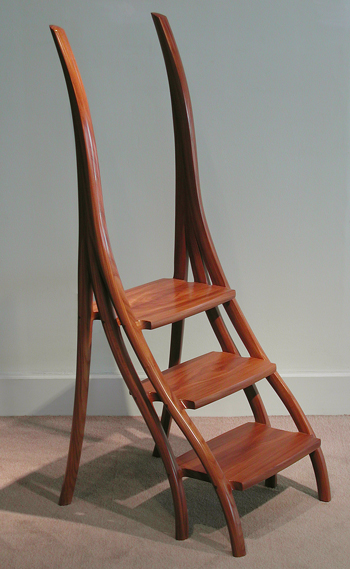
Aframosia.
49”H x 19”W x 22”D
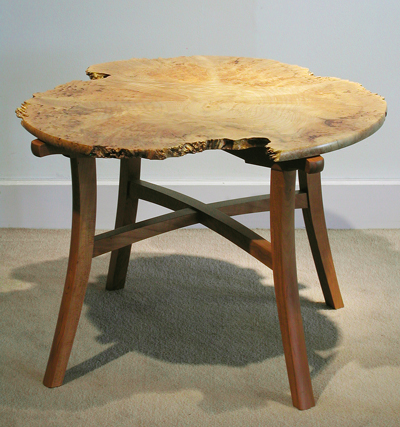
Maple Burl, Cherry base.
22.25”H x 31.5”W x 31.5”D
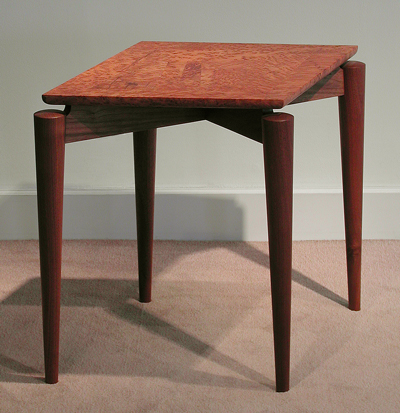
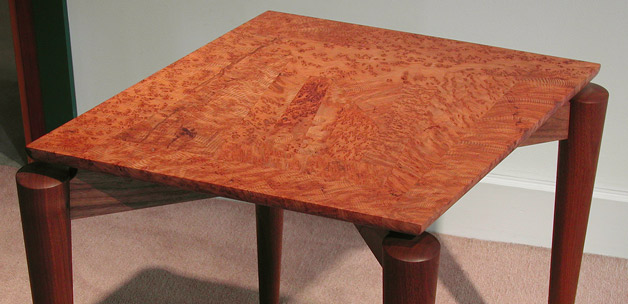
Redwood, Walnut.
24”H x 31”W x 23”D
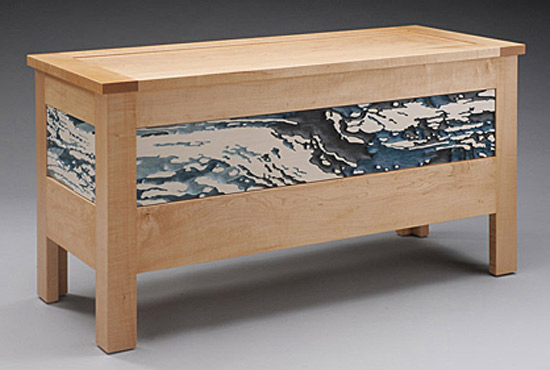
Maple, Stained Ash.
21”H x 39”W x 16”D
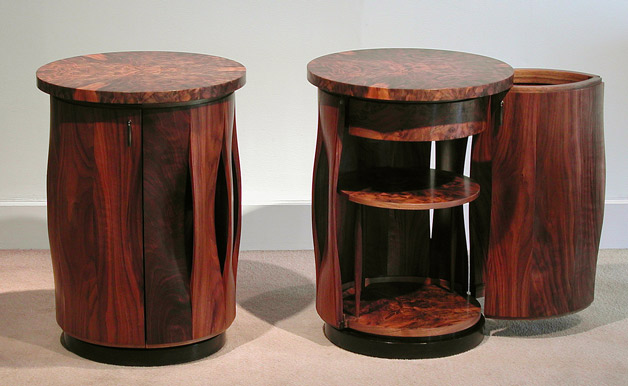
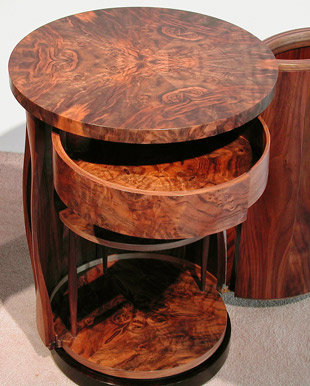
The pair of American walnut side cabinets by Tom Hucker is stunning to see and best approached without expectation. They function in no normal manner but will intrigue the furniture connoisseur with the ingenuity of their closure and operation features. The doors slide to the side with hinged folding panels, while the internal vertical structure is kept rigid by spectacularly minimal posts. When the door panels are all the way open, a circular drawer can swing out from the top interior level. Closed, the cabinets are highlighted by a sequence of gently twisting curved panels which, in a nod to a Japanese sensibility, screens the interior but leaves a sense of openness.
American Black Walnut.
24.5"H x 18"Diameter
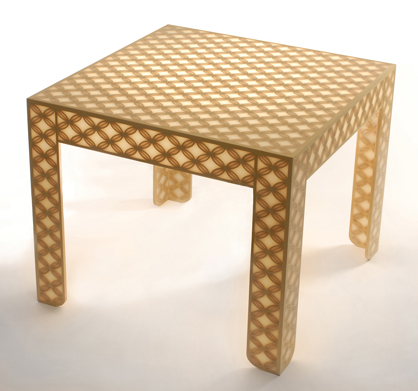
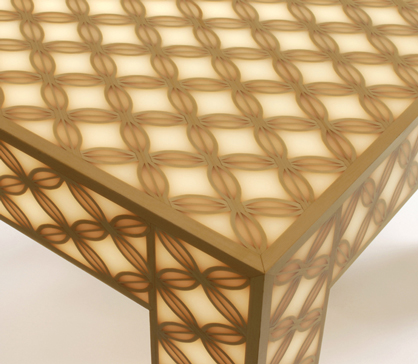
Alaskan Yellow Cedar, Epoxy Resin.
30"H x 37"W x 37"D


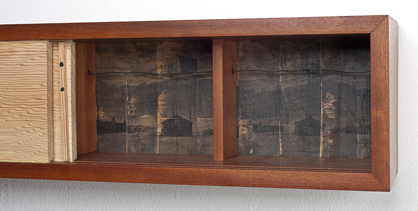
Angelique, fir, wire, image transfers, encaustic.
6"H x 48"W x 6"D
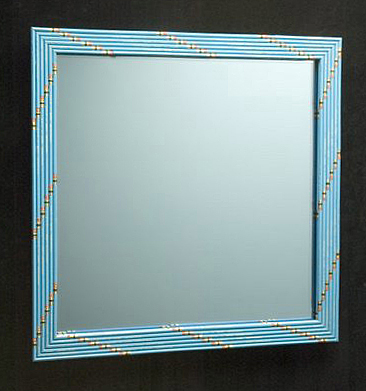
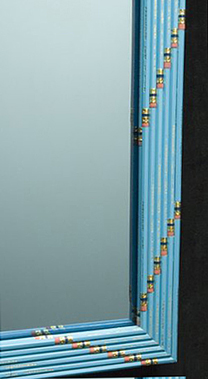
Hardwood Blue Pencils, mirror.
22"H x 22"W x 1.25"D
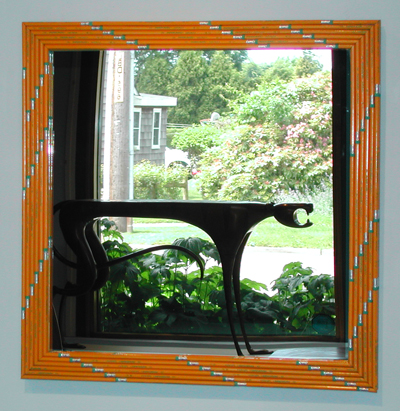
Earthwrite Pencils, mirror.
22"H x 22"W x 1.25"D
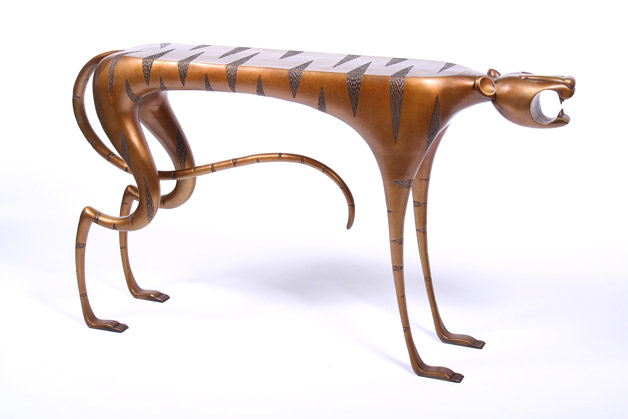
Cast Bronze.
34"H x 60"W x 12"D
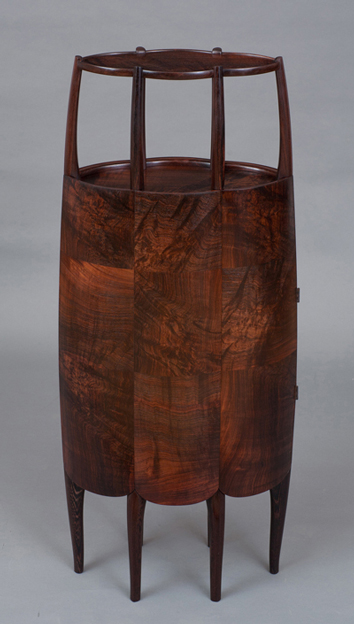
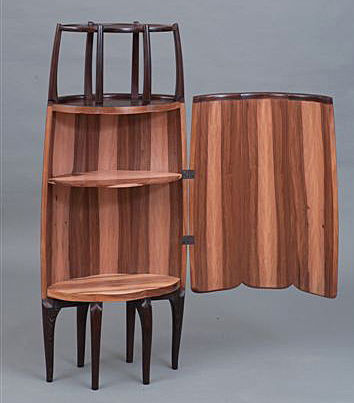
East Indian rosewood, wenge, isu noki.
47.5"H x 20"W x 10"D
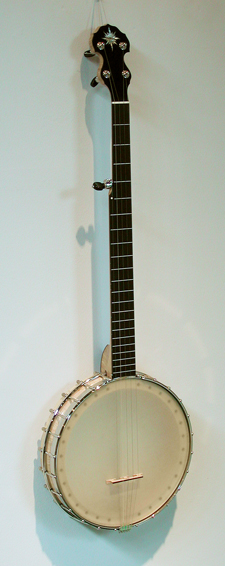
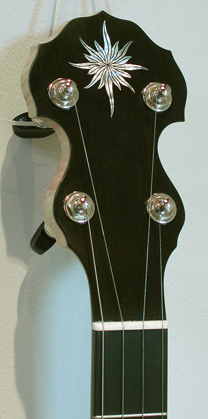
Curly Maple, Ebony, Brass, Mother-of-Pearl.
38”H x 11.75”W x 3.5”D
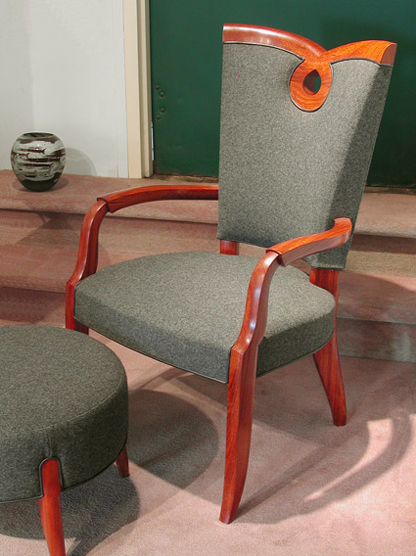
Bubinga, wool felt, leather.
Chair: 43"H x 27W x 29D
Ottoman: 15"H x 23 diameter
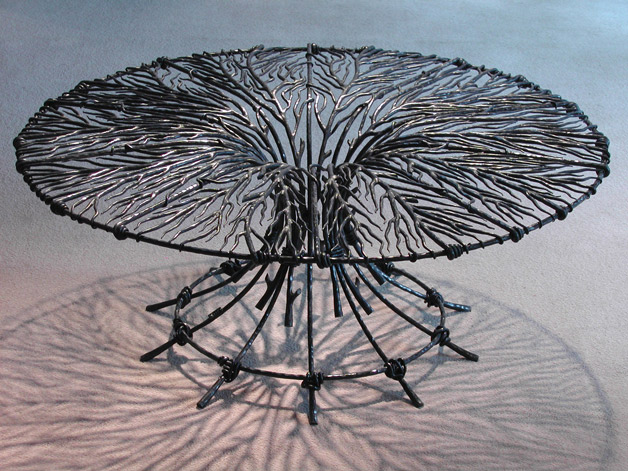
Forged & patinaed steel.
17”H x 42.5”diameter
Looking back through the period of this third decade, beyond the shops and studios of furniture makers, there were cyclical events underway that would change the outlook for the field. During the summer of 2008, there was a palpable anxiety in the air that foreshadowed the economic events that would take place that fall. Clients more closely in touch with financial circles were aware of the scary specters that hung over the future. Besides the recession that followed in 2009, there were other circumstances in play that affected the fragile health of the average artisan. Most of the collectors, whose support had made possible the sense of optimism during the gallery’s first two decades, had filled their furniture needs after years of collecting, and a new audience for studio furniture had not yet appeared. At the same time, there were architectural and decorative trends that did not favor studio furniture. The interior design media showed reinvigorated interest in modernist/minimalist ideas with their wide use of steel, glass, and other industrially produced materials, and seemed to turn away from the more organic nature of wood. In both architecture and interior design, there appeared to be no use for classical references. It is ironic that while artisanal food gained currency, interest in studio furniture seems to be waning.
At this point, there are more than a few indicators to suggest that studio furniture is an historical movement. The growth of literature about studio furniture itself suggests that this decorative arts movement has reached a stage in its dialectic that makes it a proper subject for analysis and evaluation as an historical movement. Schools that were identified as centers for training the second generation of furniture makers in the mid to late 20th century shifted their emphasis from making to designing in the 21st century. In 2002, the American Craft Museum in New York changed its name and organizational purpose to become the Museum of Arts & Design. Concurrently, the secondary market was making its way from Arts & Crafts through the mid-20th century to contemporary pieces produced by studio furniture makers. However, the auction house is an unsentimental host and while values rose for some, like George Nakashima whose sheer volume of work (estimated to be more than 35,000 pieces over a lifetime) would enhance his secondary market sales, more than a few makers would find their work on the auction block selling for less than wholesale. Ironically, it will be the secondary market, and not the primary market, that will ultimately determine the value of studio furniture. In order to facilitate the evaluation of studio furniture, a new breed of professional appraiser must appear, like Bien Fait in Boston, upon whose expertise the evaluation of this 20th-21st century decorative arts period will rest.
Access to and use of text, artwork, photographs and other files on this Web site are subject to the following terms and conditions:
All Content is Protected by Copyright Laws
Images, text, software, documentation, electronic text and image files, audio and video clips, and other materials are protected by copyright laws and may be covered by other restrictions as well. Pritam & Eames retains all rights, including copyright, in data, image, text, and any other information contained in these files. Copyrights and other proprietary rights in the material on this Web site may also subsist in individuals and entities other than, and in addition to, Pritam & Eames. Pritam & Eames expressly prohibits the copying of any protected materials on this Web site, except for the purposes of fair use as defined in the copyright laws, and as described below.
Fair Use is Permitted
Fair use of copyrighted material includes the use of protected materials for noncommercial educational purposes, such as teaching, scholarship, research, criticism, commentary, and news reporting. Unless otherwise noted, users who wish to download or print text and image files from
Pritam & Eames’ Web site for such uses are welcome to do so without Pritam & Eames’ express permission. Users must cite the author and source of this material as they would material from any printed work; the citation should include the URL "http://www.PritamEames.com".
By downloading, printing, or otherwise using text and image files from this Web site, users agree that they will limit their use of such files to fair use, and will not violate Pritam & Eames’ or any other party's proprietary rights.
Commercial Use is Restricted
Unauthorized publication or exploitation of Pritam & Eames’ files is specifically prohibited. Anyone wishing to use any of these files or images for commercial use, publication, or any purpose other than fair use as defined by law, must request and receive prior permission. All requests to reproduce works from Pritam & Eames’ collection within North America ( Canada, U.S., Mexico) should be addressed directly to Pritam & Eames, at 29 Race Lane, East Hampton, New York 11937.
Telephone (631) 324-7111; fax (631) 324-4942, connect@pritameames.com, www.PritamEames.com.
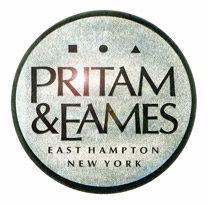
![]()
East Hampton, New York 11937
631-324-7111
connect@pritameames.com
www.PritamEames.com
![]()
Design by Diana Zadarla